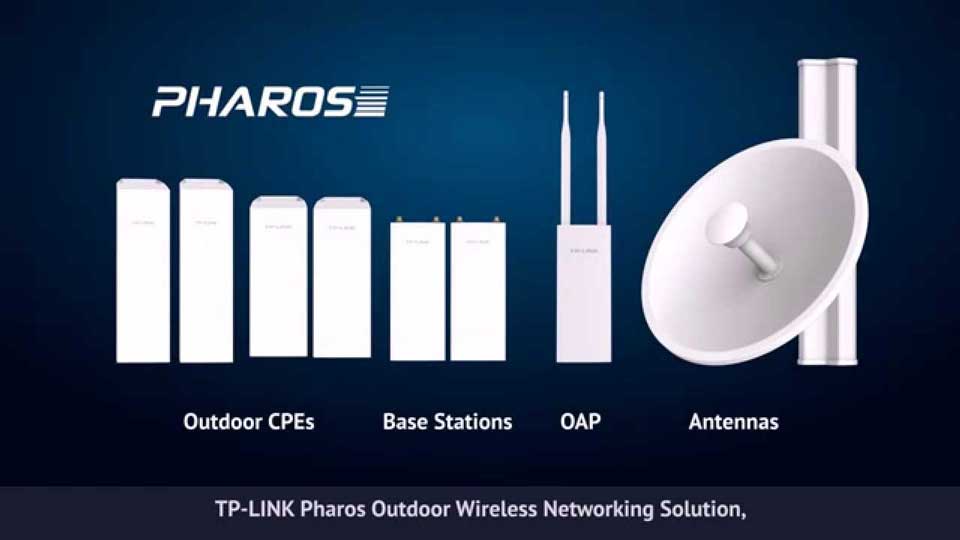TP-Link Pharos Series Installation Guide, With a high transmit power and antenna gain, TP-Link Pharos Products are perfect for long-distance wireless connections. The communication distance ranges from several kilometers to dozens of kilometers depending on your product models.
You can use Pharos products in diversified network environments. This article introduces some common application scenarios, including Point to Point (PtP), Point to Multi-Point (PtMP) and Wireless Internet Service Provider (WISP), one of which may be similar to yours.
If you want to set up a Wi-Fi hotspot outdoors like in a plaza or farm, use Omada Outdoor EAPs instead, such as EAP225-Outdoor and EAP110-Outdoor. That’s because Omada outdoor EAPs are designed to provide wireless access for mobile terminals, while Pharos devices are more suitable for long-distance communications. However, if you still want to use Pharos Products in that scenario, refer to Device A in 1 Point to Point (PtP) to set up the device.
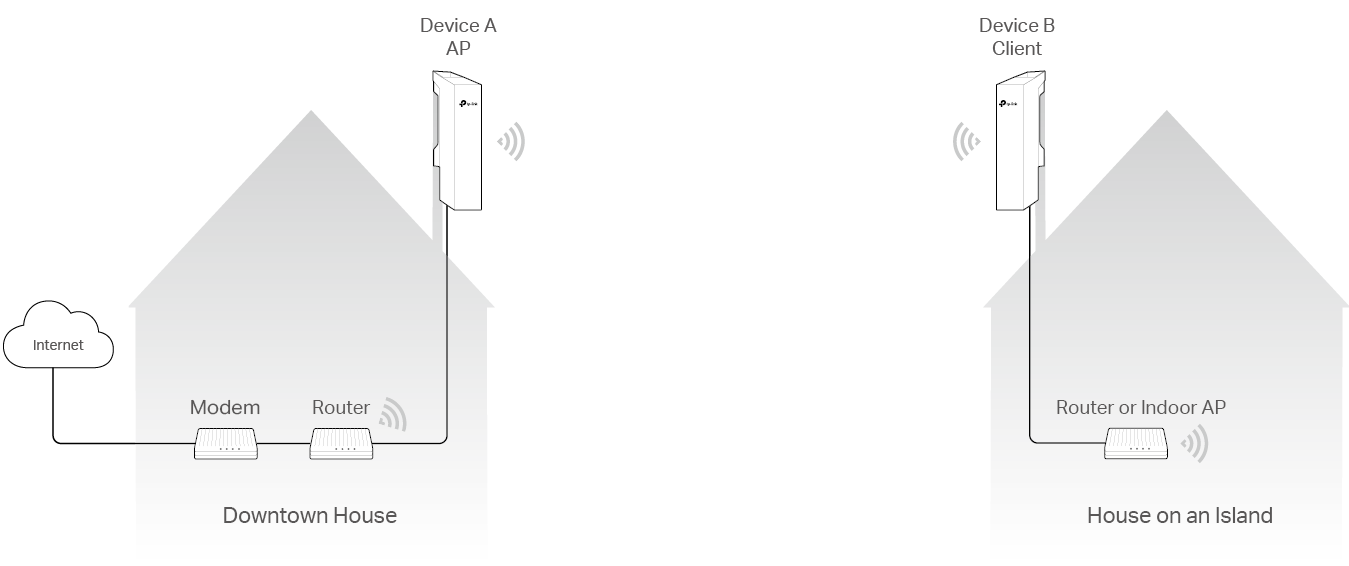
The PtP application is to realize the communications between two isolated locations, such as two sites separated by a river, hill, railway, and so on. The wireless PtP link acts as a very long and invisible cable. It simplifies the network deployments because you do not need long-distance cabling between the two sides. To build a PtP link, you need two Pharos devices. We recommend that you configure one in AP Mode and the other in Client Mode.
Figure 1-1 shows a typical example of the PtP application: Bridging the internet connection from a downtown house to another house on a small island where no ISP provides internet access.
For the downtown house, there are already a modem and router together to provide internet access for computers and mobile terminals. Configure Device A to work in AP Mode and connect it to the LAN port of the router. In AP Mode, Device A creates a Wi-Fi signal to the designated area so that wireless clients can access the network after connecting to it.
For the house on the island, configure Device B to work in Client Mode and connect it to the SSID of Device A wirelessly. In Client Mode, Device B acts as a wireless adapter to receive the wireless signal from the remote root AP (Device A). Connect it to a router or indoor AP via Ethernet cables, then mobile terminals like laptops and mobile phones can access the internet by connecting to the SSID of the router or indoor AP.
TP-Link Pharos Series Installation Guide
Read More :
- Comfast Long Range WiFi Access Point Setup
- How to Setup Email Notifications via Gmail
- SADP Tool Software User Manual
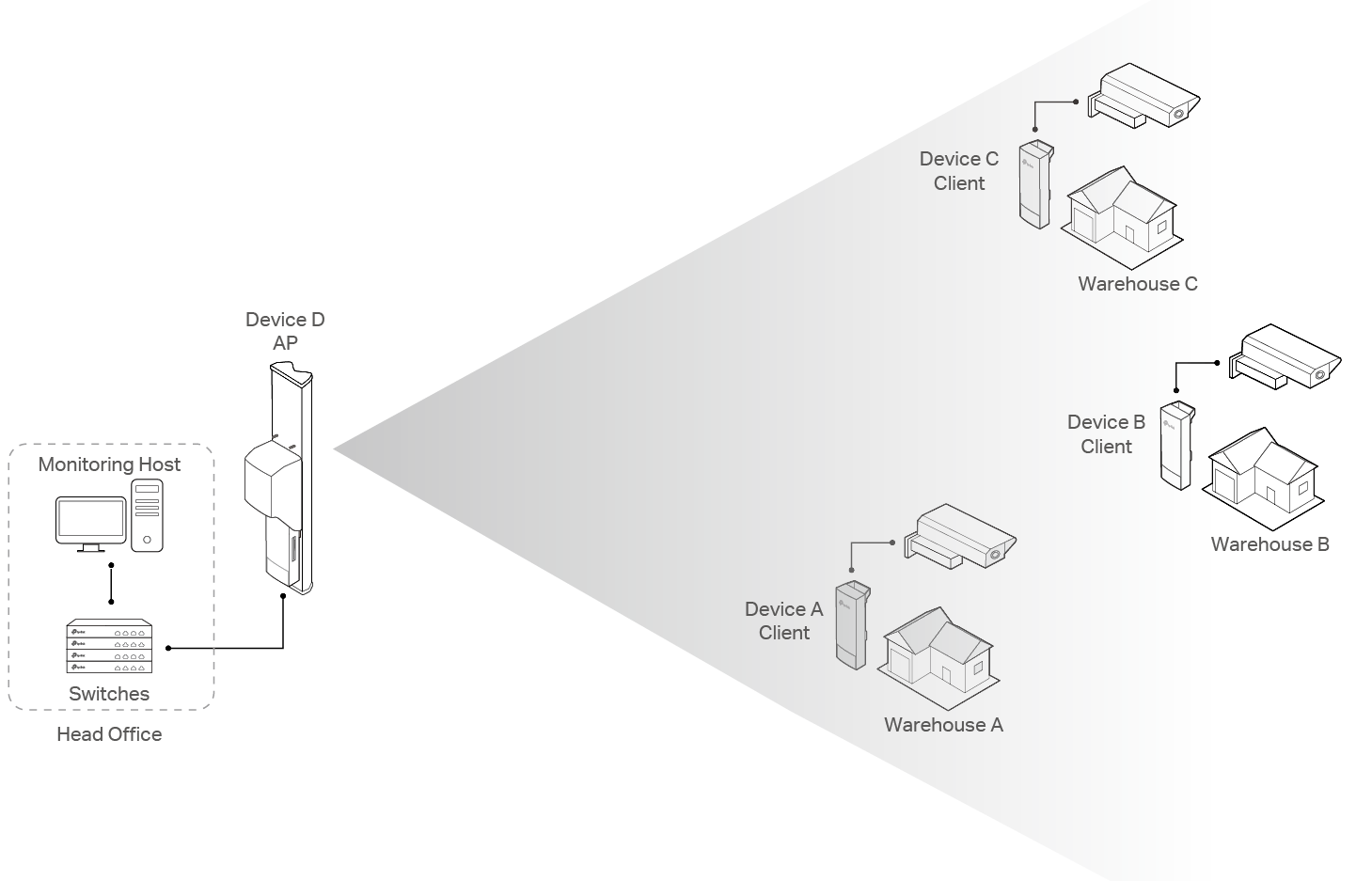
The PtMP application is often used when multiple sites need to connect to a remote center. The device at the remote center usually works in AP Mode and the others work in Client Mode. To cover all the Clients, the AP should have a wide enough beamwidth. A WBS device installed with a sector antenna is recommended.
Figure 2-1 shows a typical PtMP application. A company has three warehouses that are located far away from the head office. It plans to construct a PtMP link to realize remote monitoring of the warehouses from the head office.
To construct the PtMP link, for the head office, configure Device D to work in AP Mode and connect it to the switch that the Monitoring Host is connected to. For the warehouses, configure the Pharos devices to work in Client Mode. Connect them to the SSID of Device D wirelessly, and to the cameras via Ethernet cables. Then the four sites form a local area network and employees in the head office can monitor the warehouses in real time via the Monitoring Host.
3Wireless Internet Service Provider (WISP)
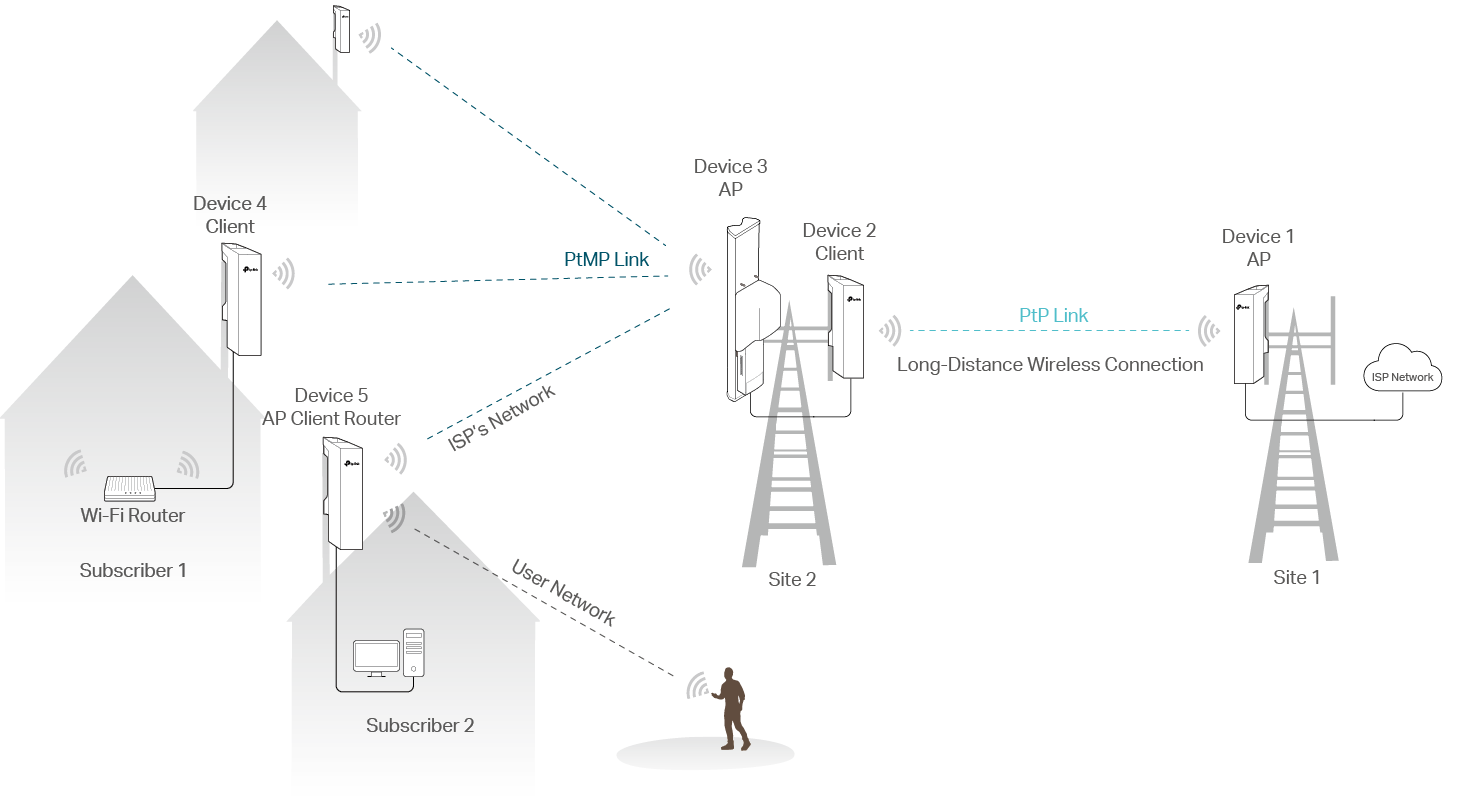
When providing internet service for some remote areas that have no wired internet access yet, ISPs usually choose a wireless solution instead of a wired solution to avoid cabling over long distances. The WISP application is often used in this kind of scenario. Figure 3-1 shows the network topology. As you can see, it is a combination of PtP and PtMP applications.
For this scenario, subscribers are often kilometers away from each other. Find a place that is approximately the center of the subscribers and suitable to install Pharos devices, and mark it as Site 2. Then find the nearest location to Site 2 that has internet access, and mark it as Site 1.
The PtP link is to realize the long-distance wireless connection between Site 1 and Site 2.
For Site 1, deploy a device (Device 1) and configure it to work in AP Mode. Connect it to the existing network via Ethernet cables.
For Site 2, deploy a device (Device 2) and configure it to work in Client Mode. Then connect it to the SSID of Device 1 wirelessly so that it can communicate with Device 1.
The PtMP link is the last mile of the internet connections to the subscribers.
For Site 2, deploy a device (Device 3) and configure it to work in AP Mode. Connect it to Device 2 via Ethernet cables. Device 3 is used to provide wireless coverage for the subscribers. As mentioned in 2 Point to Multi-Point (PtMP), a WBS device installed with a sector antenna is recommended. If Device 3 cannot cover all the subscribers, deploy more devices in different directions to achieve the goal.
For the devices at subscribers’ homes like Device 4 and Device 5, there are two configuration choices:
Choice 1: Client Mode
This is the most common use, and a Wi-Fi router is needed.
Configure the device (Device 4) to work in Client Mode. Connect it to the ISP’s network wirelessly, and to a Wi-Fi router via Ethernet cables. Computers and Mobile terminals can access the internet by connecting to the Wi-Fi router.
Choice 2: AP Client Router (WISP Client) Mode
AP Client Router Mode is used in the following two scenarios:
■The ISP needs to have good control of user networks, like limiting the ingress and egress bandwidth of the user networks.
■The user has no Wi-Fi routers.
Configure the device (Device 5) to work in AP Client Router Mode and connect it to Device 3 wirelessly. In AP Client Router Mode, Device 5 acts as a wireless client in the ISP’s network and a wireless NAT router in the user network. Both wired and wireless terminals can access the internet after connecting to Device 5. No extra Wi-Fi router is needed, but there are some concerns to take into consideration.
■The installation position for Device 5 has more stringent requirements than that for Device 4 in Choice 1. In addition to ensuring that Device 5 can communicate with Device 3, you should also ensure that its wireless coverage range can cover the areas where the subscriber needs to access the internet.
■Mobile terminals that are far away from the Pharos device may fail to connect to the wireless network although they can scan it. This is because the mobile terminals are in the coverage range of the Pharos device, but the Pharos device is not in their range. For more details, refer to Why Does My Cellphone Fail to Connect to the Remote Outdoor Access Point?
The Pharos series products support multiple operation modes to satisfy user’s diverse network requirements. This chapter introduces typical usage scenarios of different modes. For more information, refer to Common Applications for Pharos Products.
Note:
Repeater mode or Bridge mode is only available on certain devices. To check whether your device supports this feature, refer to the actual web interface.
In Access Point (AP) Mode, the device acts as a central hub and provides wireless access point for wireless clients, thus the AP Mode is applicable to the following three scenarios. Meanwhile, Multi-SSID function can be enabled in this mode, providing up to four wireless networks with different SSIDs and passwords.
■ Scenario 1
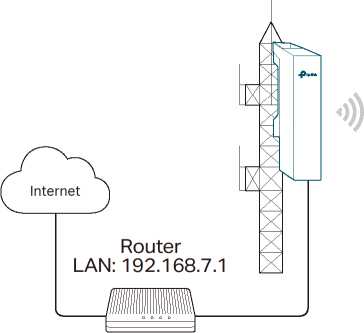
![]()
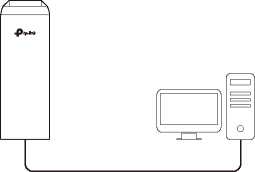
Access Point
LAN: 192.168.7.2
AP Client Router
LAN: 192.168.0.254
WAN: Dynamic IP
Network requirements: Establish the network coverage in the remote areas without longdistance cabling.
The device in the network: In the adjacent town covered by wired network, ISP (Internet Service Provider) can put up a device in AP Mode to access the internet and transform wired signal into wireless one. In the remote area, users can put up a device in AP Client Router Mode to access the wireless network.
Advantages: Transmit data wirelessly across a long distance and reduce the cabling cost.
■ Scenario 2
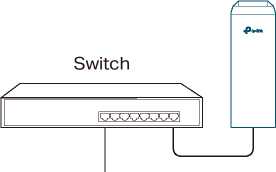
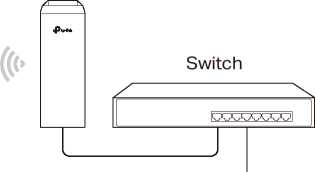

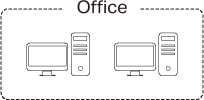
Access Point
LAN: 192.168.0.254
Client
LAN: 192.168.0.2
Network requirements: Combine two separate office networks into one.
The device in the network: The device in AP Mode connects to one office network and creates a wireless network. The device in Client Mode connects to the other office network and the wireless network.
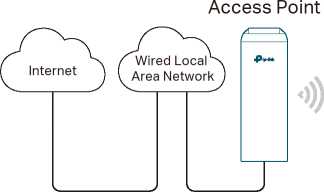 Advantages: Establish a point-to-point WLAN across a long distance to achieve the connectivity between two networks and avoid the cabling trouble.
Advantages: Establish a point-to-point WLAN across a long distance to achieve the connectivity between two networks and avoid the cabling trouble.
■ Scenario 3
Laptop/Tablet/Smartphone
Network requirements: Establish wireless network coverage in the campus, community, industrial park or public place to provide wireless access for users.
The device in the network: With the access to campus wired network or other wired local area networks, the device in AP Mode provides the wireless access for wireless clients, such as smart phones, laptops and tablets to connect to the network.
Advantages: Enrich the access ways of local area network and extend the network coverage.
For the device in Client Mode, the most common usage scenario is point-to-point networking. The device is used to transform wireless signal into wired one.
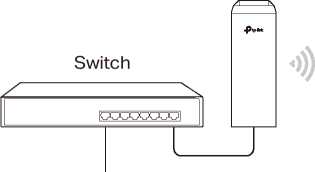
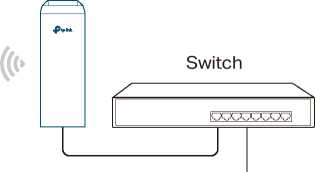
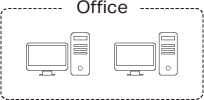
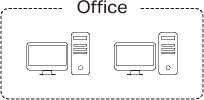
Access Point
LAN: 192.168.0.254
Client
LAN: 192.168.0.2
Network requirements: Help the wired devices to connect to the wireless network.
The device in the network: In Client Mode, the device actually serves as a wireless adapter to receive the wireless signal from root AP or Station. In this case, wired devices can access the wireless network by connecting to the device in Client Mode.
In AP Client Router Mode, the device access the internet provided by WISP (Wireless Internet Service Provider) through wireless connection. For the downstream clients, the device serves as a normal home wireless router. It can provide wired connection and wireless connection simultaneously.

![]()
![]()
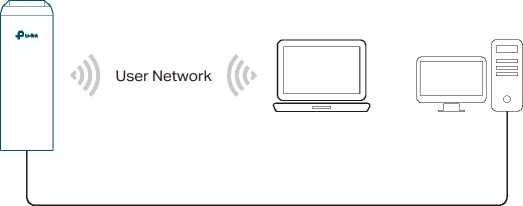
WISP’s network
AP Client Router
LAN: 192.168.0.254
WAN: Dynamic IP
Network requirements: Get internet service from WISP.
The device in the network: The device in Client Router Mode connects to WISP wirelessly for internet service. It provides both wired access and wireless access for the clients.
The device in AP Router Mode serves as a normal home wireless router but provides a wider wireless network range.
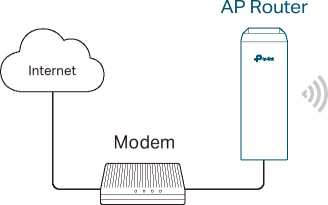

Laptop/Tablet/Smartphone
Network requirements: Establish the wireless network coverage in the campus, community, industrial park or other public places and so on.
The device in the network: The device in AP Router Mode connects to root ADSL/Cable Modem for internet access. Meanwhile, it creates a wireless network for the wireless clients to connect to the internet.
Note:
In this mode, the device cannot be managed directly through the port connected to ADSL/Cable Modem. To manage the device, connect the management host to the device wirelessly or via the other LAN port.
Note:
Repeater mode is only available on certain devices. To check whether your device supports this feature, refer to the actual web interface.
The device in Repeater Mode can extend wireless coverage of an existing wireless network. The SSID and encryption type of the device should be the same as those of the root AP.
Note:
Bridge mode is only available on certain devices. To check whether your device supports this feature, refer to the actual web interface.
The device in Bridge Mode can extend wireless coverage of an existing wireless network.
The SSID and encryption type of the device can be different from those of the root AP.
This chapter introduces how to quickly build a wireless network in different operation modes. Follow the steps below:
- Check the System Requirements
- Log In to the Device
- Set Up the Wireless Network
- Check the System Requirements
Microsoft Windows XP, Windows Vista, Windows 7, Windows 8, Windows 10, Linux, or Mac OS X.
Google Chrome, Safari, Firefox, and Apple Safari. IE browsers are not recommended.
Before configuring the device, you need to access the PharOS configuration interface. Follow the steps below:
- Connect your PC to the device.
- Set the IP address of your PC as static IP address on 192.168.0.X subnet (X ranges from 2 to 253, e.g.192.168.0.10).
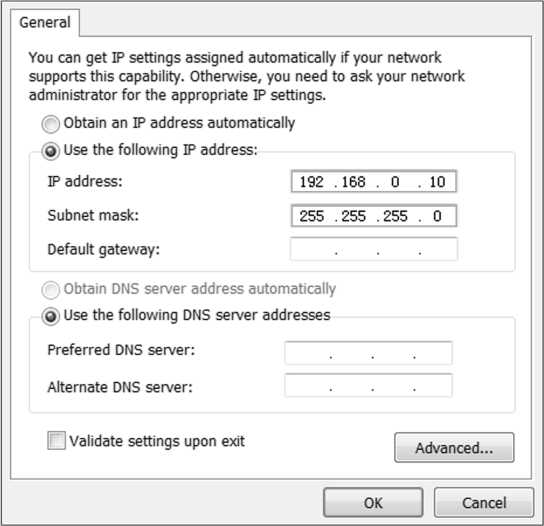
3. Launch a web browser on and enter the management IP address of the device (192.168.0.254 by default) in the address bar to load the login page of the PharOS configuration interface.

- Use admin for both of User Name and Password. Specify the region where you use the device. Available channels and maximum Transmit Power will be determined by the selected region according to the local laws and regulations. Select the appropriate language from the Language drop-down list. Read and agree the terms of use, then click Login.
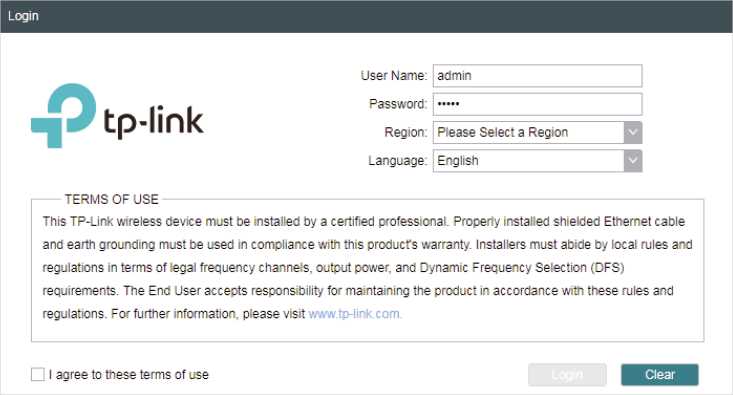
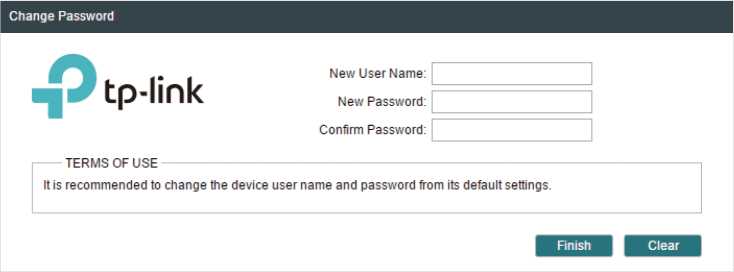
Use the Quick Setup wizard to quickly configure your device step by step. Choose the suitable operation mode according to your network environment and follow the step-by- step instructions.
Follow the steps below to configure the device as Access Point Mode:
![]()
■Jtp-link PHAROS
Operation Mode: | Access Point
About Support Log Out
QUICK SETUP
STATUS
NETWORK
WIRELESS
MANAGEMENT
SYSTEM
Operation Mode
Please select the proper operation mode according to your needs:
(•) Access Point
In this mode, the AP will act as a central hub for different wireless LAN clients. Multi-SSID is also available in this mode.
which supports up to 4 different SSIDs and passwords.
O Client
In client mode, the device can connect to a wired device and work as a wireless adapterto receive wireless signals from
your wire I ess network.
O Repeater
In this mode, the device can copy and reinforce the existing wireless signal to extend the coverage of the signal,
especially for a large space to eliminate signal-blind corners.
O Bridge
Bridge mode borrows existing wireless internet and broadcasts it using a different SSID and password. In this mode, you can set up a wireless client to connect with a rootAP and a wireless AP for local wireless coverage.
O AP Router
In this mode, the device enables multiple users to share the internet. The wireless ports share the same IP address as
the Ethernet WAN port to connect to the ISP. The wireless port can be regarded as a LAN port while in AP Router mode.
O AP Client Router (WISP Client) In this mode, multiple users can share an internet connection provided by a WISP. The LAN port devices share the same
IP as that assigned by the WISP to the Wireless port. While connected to a WISP, the wireless port works as a WAN port
in AP Client Router mode. The Ethernet port acts as a LAN port.
Next
device. Then, click Next.
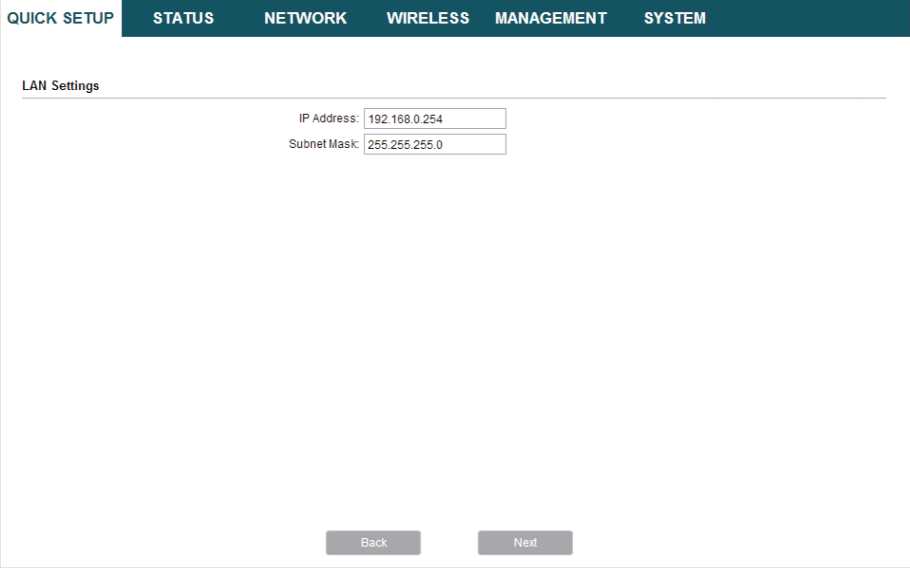
- In the Wireless AP Settings section, specify the basic wireless parameters to create a wireless network. Click Next.
Note:
• It is recommended to specify Security as WPA-PSK/WPA2-PSK for the network security.
• You can keep the default settings or specify the parameters according to your need. For details, refer to 5. Configure the Wireless Parameters.
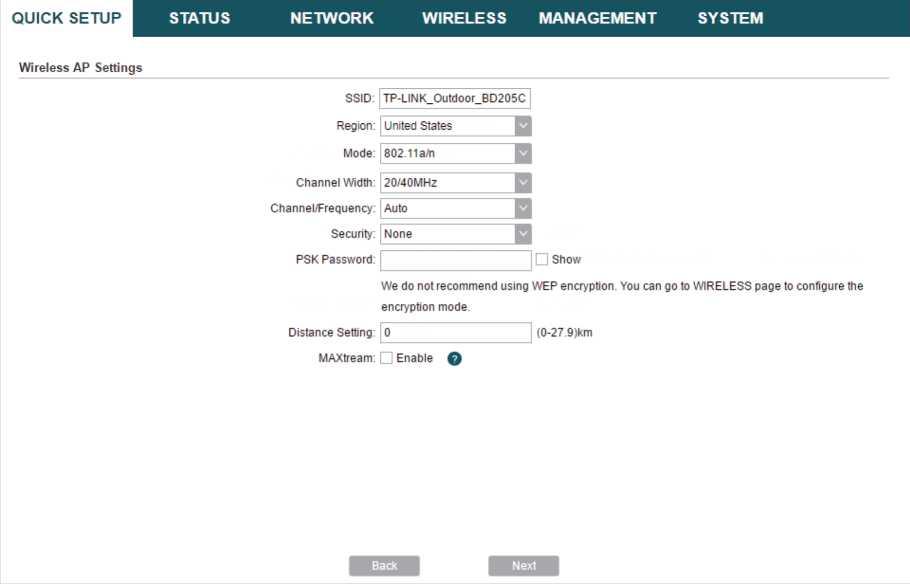
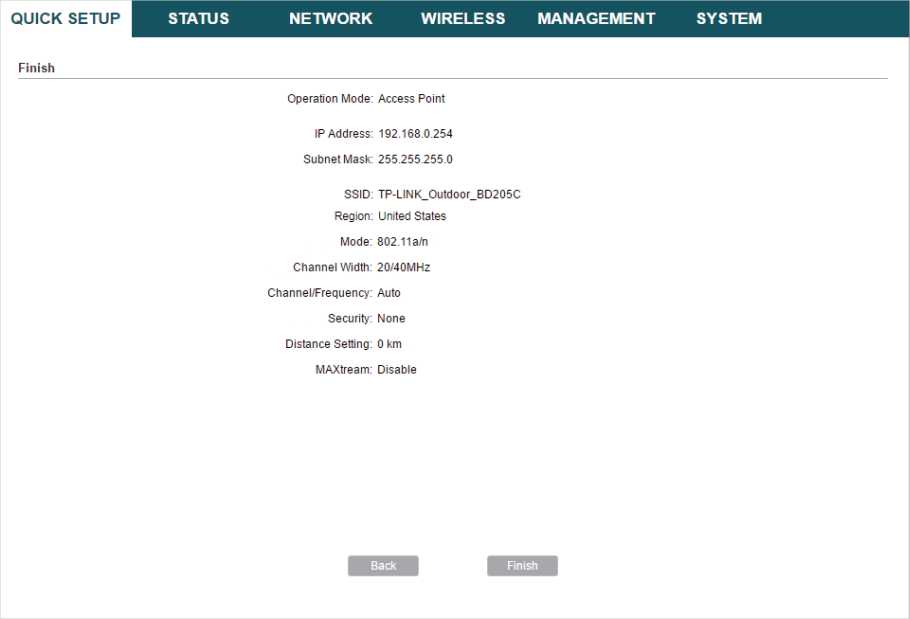
5. Connect the device according to your network topology and use it normally.
Follow the steps below to configure the device as Client Mode:
QUICK SETUP
Operation Mode
Please select the proper operation mode according to your needs:
| o Access Point | In this mode, the AP will act as a central hub for different wireless LAN clients. Multi-SSID is also available in this mode, which supports up to 4 different SSIDs and passwords. |
| (•) Client | In client mode, the device can connect to a wired device and work as a wireless adapter to receive wireless signals from your wireless network. |
| O Repeater | In this mode, the device can copy and reinforce the existing wireless signal to extend the coverage of the signal especially for a large space to eliminate signal-blind corners. |
| O Bridge | Bridge mode borrows existing wireless internet and broadcasts it using a different SSID and password. In this mode, you can set up a wireless client to connect with a root AP and a wireless AP for local wireless coverage. |
| O AP Router | In this mode, the device enables multiple users to share the internet The wireless ports share the same IP address as the Ethernet WAN port to connect to the ISP. The wireless port can be regarded as a LAN port while in AP Router mode. |
| o AP Client Router (WISP Client) | In this mode, multiple users can share an internet connection provided by a WISP. The LAN port devices share the same IP as that assigned by the WISP to the Wireless port. While connected to a WISP, the wireless port works as a WAN port in AP Client Router mode. The Ethernet port acts as a LAN port. |
device. Then, click Next.
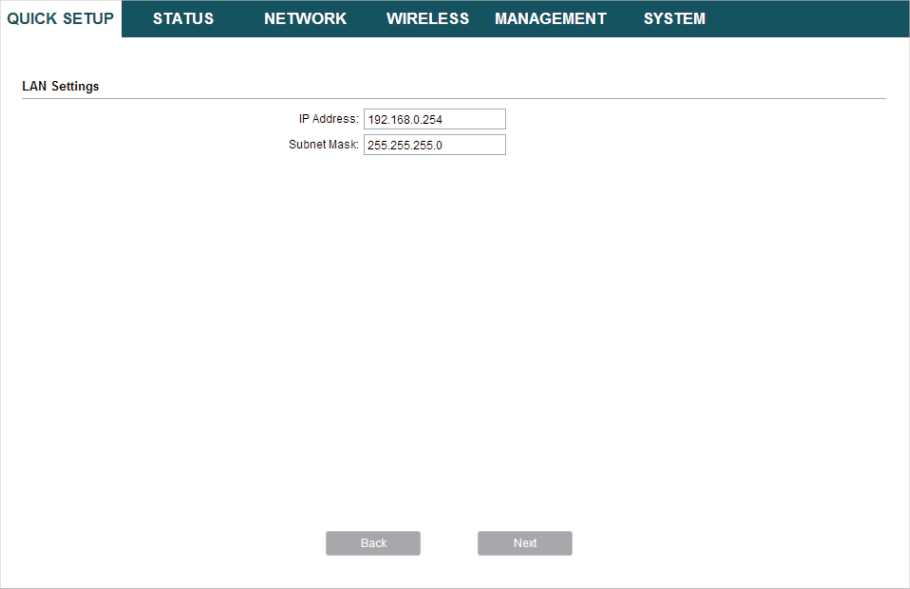
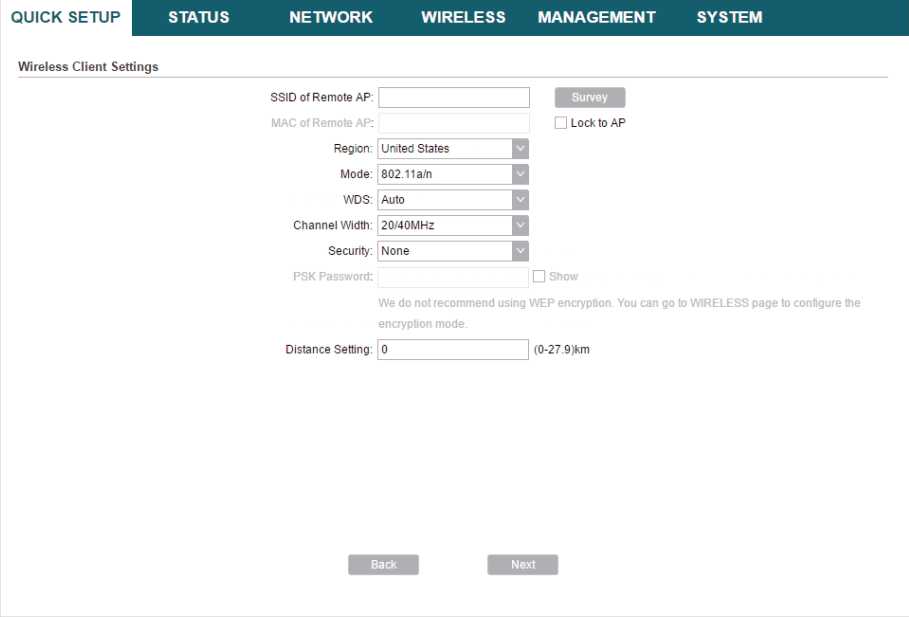
Note:
There may be two or more networks with the same SSID in the AP list. Click Lock to AP to select the SSID and AP simultaneously, which can make the device connect to the specific AP next time.
STATUS NETWORK WIRELESS MANAGEMENT SYSTEM
QUICK SETUP
Wireless Client Settings
| □ | BSSID | SSID | MAXtream | Device Name | SNR (dB) | Signal/Noise (dBm) | Channel | Security | |
| □ | 18-A6-F7-41-26-46 | daisy 3 | No | 42 | -537-95 | 5180 (36) | WPA2-PSK | ||
| □ | 50-C7-BF-27-7F-6E | SR20_5G | No | 50 | -457-95 | 5220 (44) | WPA2-PSK | ||
| □ | 50-C7-BF-17-A6-E3 | EAP-Show | No | 14 | -81/-95 | 5180 (36) | WPA2-PSK | ||
| □ | D4-61-FE-5A-2A-00 | das | No | 11 | -857-96 | 5180 (36) | WPA-PSK/WPA2
-PSK |
||
| □ | 50-C7-BF-48-54-DB | deco | No | 35 | -61/-96 | 5200 (40) | WPA2-PSK | ||
| □ | 50-C7-BF-48-57-1F | deco | No | 30 | -667-96 | 5200 (40) | WPA2-PSK | ||
| □ | 50-C7-BF-48-57-74 | deco | No | 47 | -497-96 | 5200 (40) | WPA2-PSK | ||
| □ | 56-C7-BF-48-54-DB | No | 37 | -597-96 | 5200 (40) | WPA2-PSK | |||
| □ | 56-C7-BF-48-57-1F | No | 31 | -657-96 | 5200 (40) | WPA2-PSK | |||
| □ | 56-C7-BF-48-57-74 | No | 47 | -497-96 | 5200 (40) | WPA2-PSK | |||
| WPA-PSK7WPA2 | |||||||||
Back ■ Refresh
- In the Wireless Client Settings section, specify the wireless parameters to connect to the specified wireless network. Click Next.
Note:
Make sure that Security and PSK Password are the same as the upstream wireless network’s. Other parameters set in this page and those of the upstream wireless network should be compatible with each other. For details, refer to 5.
Configure the Wireless Parameters
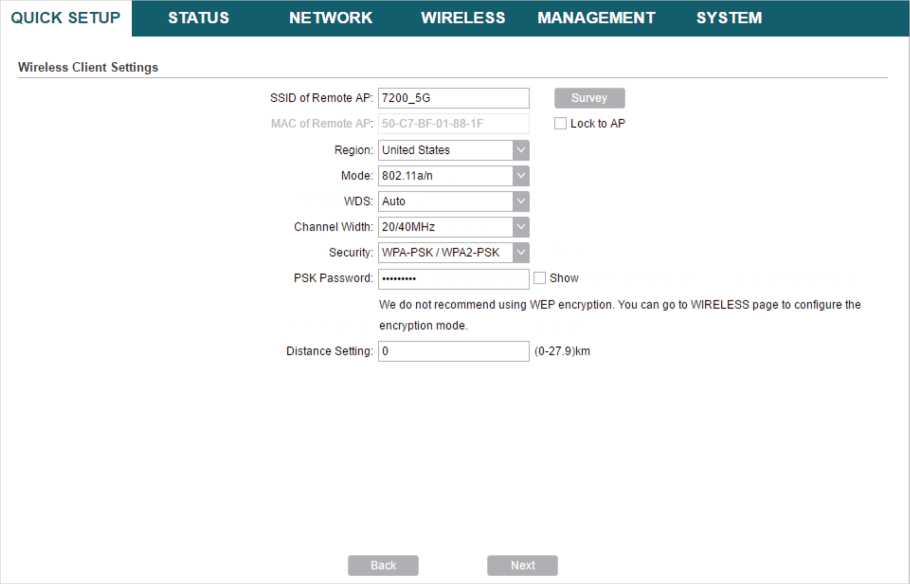
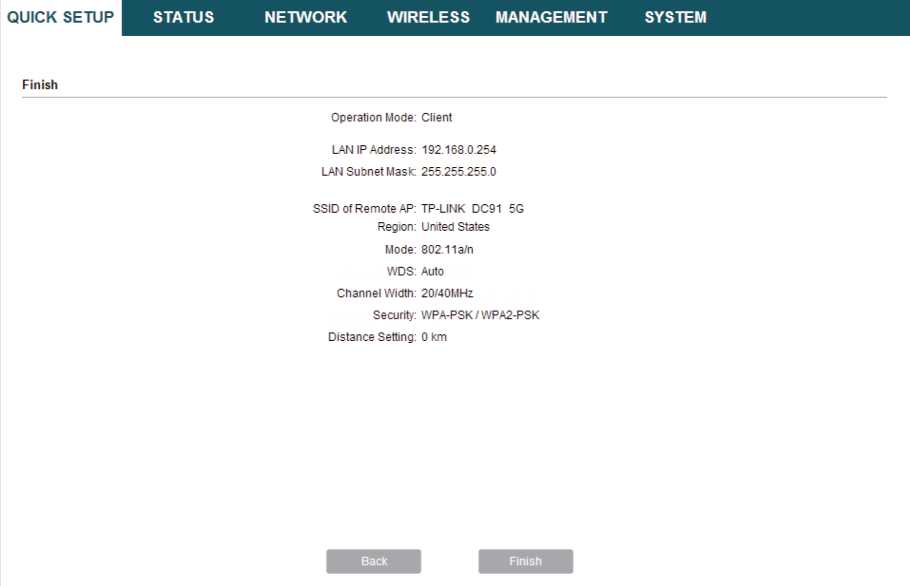
7. Connect the device according to your network topology and use it normally.
![]()
Note:
Repeater mode is only available on certain devices. To check whether your device supports this feature, refer to the actual web interface.
Follow the steps below to configure the device as Repeater Mode:
![]()
tp-link PHAROS
Operation Mode: Client
About Support Log
Tools
QUICK SETUP
STATUS
NETWORK WIRELESS MANAGEMENT SYSTEM
Operation Mode
Please select the proper operation mode according to your needs:
| O Access Point | In this mode, the AP will act as a central hub for different wireless LAN clients. Multi-SSID is also available in this mode, which supports up to 4 different SSIDs and passwords. |
| O Client | In client mode, the device can connect to a wired device and work as a wireless adapter to receive wireless signals from your wireless network. |
| (•) Repeater | In this mode, the device can copy and reinforce the existing wireless signal to extend the coverage of the signal, especially for a large space to eliminate signal-blind corners. |
| O Bridge | Bridge mode borrows existing wireless internet and broadcasts it using a different SSID and password. In this mode, you can set up a wireless client to connect with a root AP and a wireless AP for local wireless coverage. |
| O AP Router | In this mode, the device enables multiple users to share the internet The wireless ports share the same IP address as the Ethernet WAN port to connect to the ISP. The wireless port can be regarded as a LAN port while in AP Router mode. |
| O AP Client Router (WISP Client) | In this mode, multiple users can share an internet connection provided by a WISP. The LAN port devices share the same IP as that assigned by the WISP to the Wireless port. While connected to a WISP, the wireless port works as a WAN port in AP Client Router mode. The Ethernet port acts as a LAN port |
Next
device. Then, click Next.
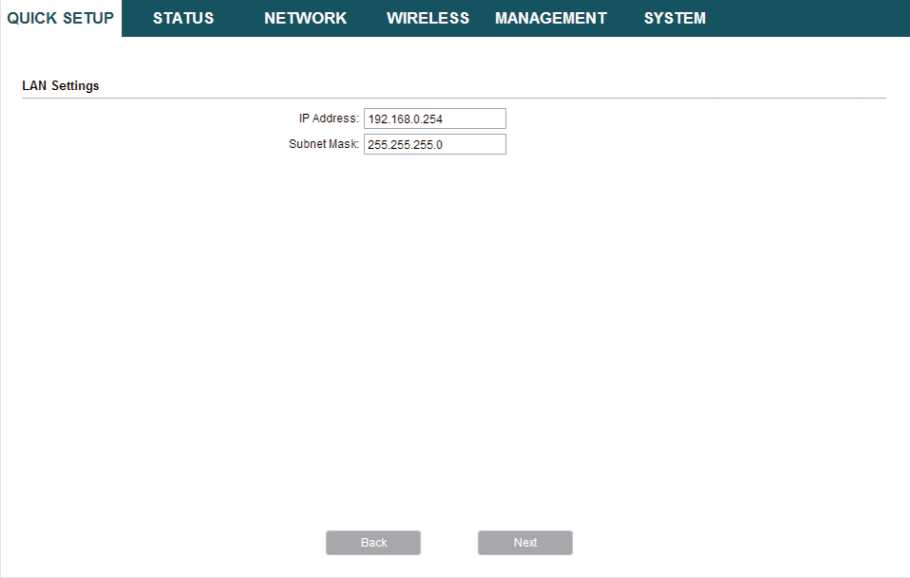
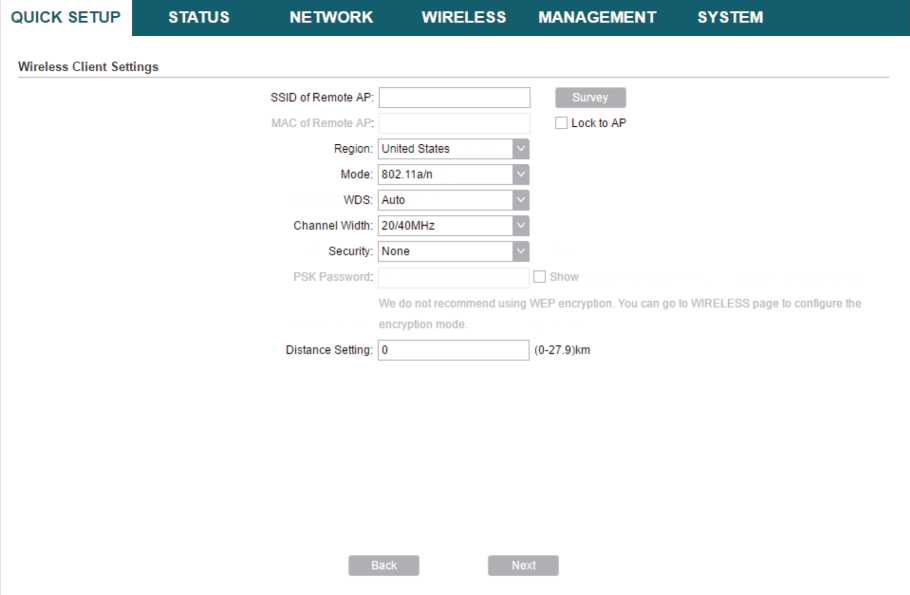
Note:
There may be two or more networks with the same SSID in the AP list. Click Lock to AP to select the SSID and AP simultaneously, which can make the device connect to the specific AP next time.
STATUS NETWORK WIRELESS MANAGEMENT SYSTEM
QUICK SETUP
Wireless Client Settings
| □ | BSSID | SSID | MAXtream | Device Name | SNR (dB) | Signal/Noise (dBm) | Channel | Security | |
| □ | 18-A6-F7-41-26-46 | daisy 3 | No | 42 | -537-95 | 5180 (36) | WPA2-PSK | ||
| □ | 50-C7-BF-27-7F-6E | SR20_5G | No | 50 | -457-95 | 5220 (44) | WPA2-PSK | ||
| □ | 50-C7-BF-17-A6-E3 | EAP-Show | No | 14 | -81/-95 | 5180 (36) | WPA2-PSK | ||
| □ | D4-61-FE-5A-2A-00 | das | No | 11 | -857-96 | 5180 (36) | WPA-PSK/WPA2
-PSK |
||
| □ | 50-C7-BF-48-54-DB | deco | No | 35 | -61/-96 | 5200 (40) | WPA2-PSK | ||
| □ | 50-C7-BF-48-57-1F | deco | No | 30 | -667-96 | 5200 (40) | WPA2-PSK | ||
| □ | 50-C7-BF-48-57-74 | deco | No | 47 | -497-96 | 5200 (40) | WPA2-PSK | ||
| □ | 56-C7-BF-48-54-DB | No | 37 | -597-96 | 5200 (40) | WPA2-PSK | |||
| □ | 56-C7-BF-48-57-1F | No | 31 | -657-96 | 5200 (40) | WPA2-PSK | |||
| □ | 56-C7-BF-48-57-74 | No | 47 | -497-96 | 5200 (40) | WPA2-PSK | |||
| WPA-PSK7WPA2 | |||||||||
Back ■ Refresh
- In the Wireless Client Settings section, specify the wireless parameters to connect to the specified wireless network. Click Next.
Note:
Make sure that Security and PSK Password are the same as the upstream wireless network’s. Other parameters set in this page and those of the upstream wireless network should be compatible with each other. For details, refer to 5. Configure the Wireless Parameters.
QUICK SETUP
STATUS
NETWORK
WIRELESS MANAGEMENT
SYSTEM
Wireless Client Settings
SSID of Remote AP: [t200 5G
MAC of Remote AP: 50-C7-BF-01-33-1F
Survey
□ Lock to AP
Region: | United States fl
Mode: 3C2 11aJn fl
WDS: | Auto
Channel Width: 2QM0MHZ fl
Security: |wPA-PSK JWPA2-PSK
PSK Password: | □ Show
We do not recommend using WEP encryption. You can go to WIRELESS page to configure the encryption mode.
Distance Setting: 0
] (0-27.g)km
Back
Next
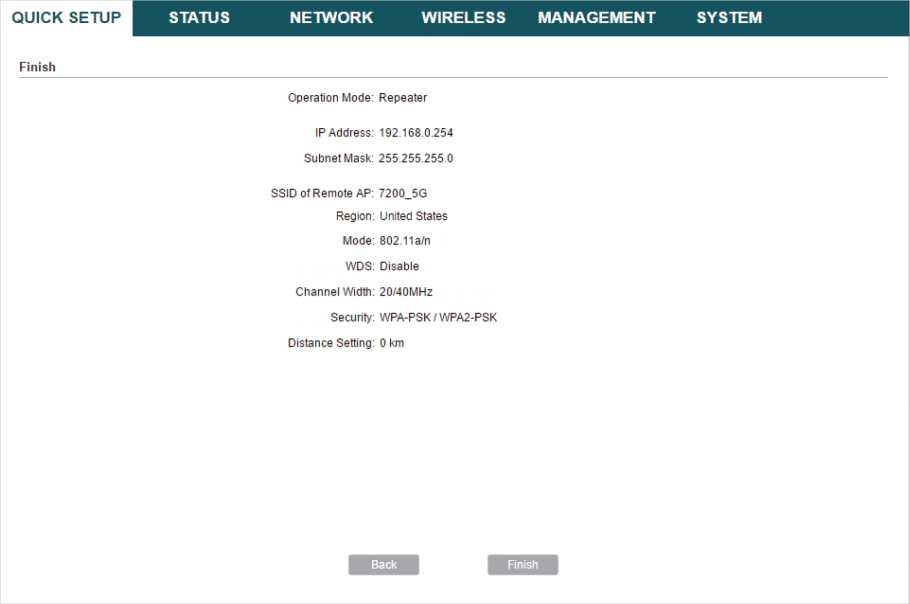
7. Connect the device according to your network topology and use it normally.
Note:
Bridge mode is only available on certain devices. To check whether your device supports this feature, refer to the actual web interface.
Follow the steps below to configure the device as Bridge Mode:
![]()
tp-link PHAROS
QUICK SETUP
STATUS
About Support Log
Operation Mode: AP Client Router ▼ Tools
NETWORK WIRELESS MANAGEMENT SYSTEM
Operation Mode
Please select the proper operation mode according to your needs:
| O Access Point | In this mode, the AP will act as a central hub for different wireless LAN clients. Multi-SSID is also available in this mode, which supports up to 4 different SSIDs and passwords. |
| O Client | In client mode, the device can connect to a wired device and work as a wireless adapter to receive wireless signals from your wireless network. |
| O Repeater | In this mode, the device can copy and reinforce the existing wireless signal to extend the coverage of the signal, especially for a large space to eliminate signal-blind corners. |
| (S) Bridge | Bridge mode borrows existing wireless internet and broadcasts it using a different SSID and password. In this mode, you can set up a wireless client to connect with a root AP and a wireless AP for local wireless coverage. |
| O AP Router | In this mode, the device enables multiple users to share the internet The wireless ports share the same IP address as the Ethernet WAN port to connect to the ISP. The wireless port can be regarded as a LAN port while in AP Router mode. |
| O AP Client Router (WISP Client) | In this mode, multiple users can share an internet connection provided by a WISP. The LAN port devices share the same IP as that assigned by the WISP to the Wireless port. While connected to a WISP, the wireless port works as a WAN port in AP Client Router mode. The Ethernet port acts as a LAN port |
Next
device. Then, click Next.
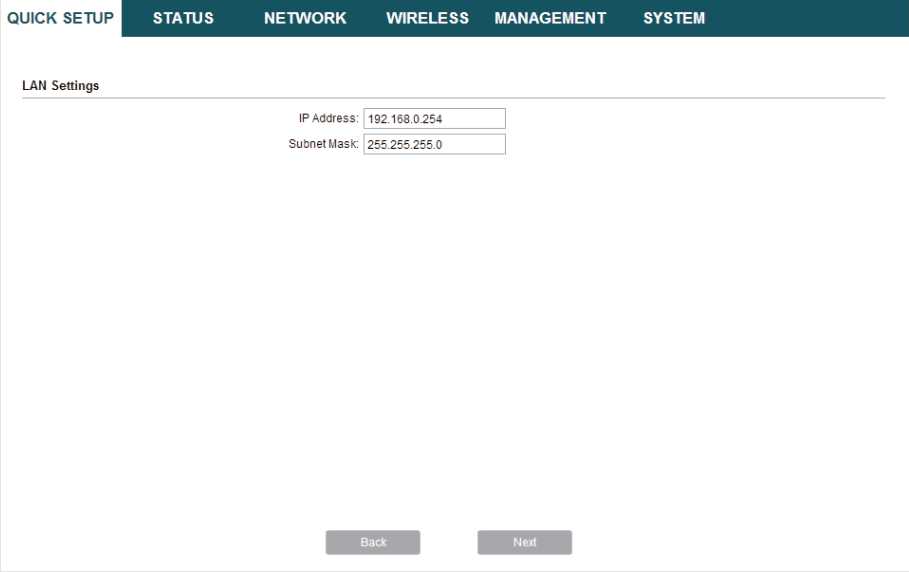
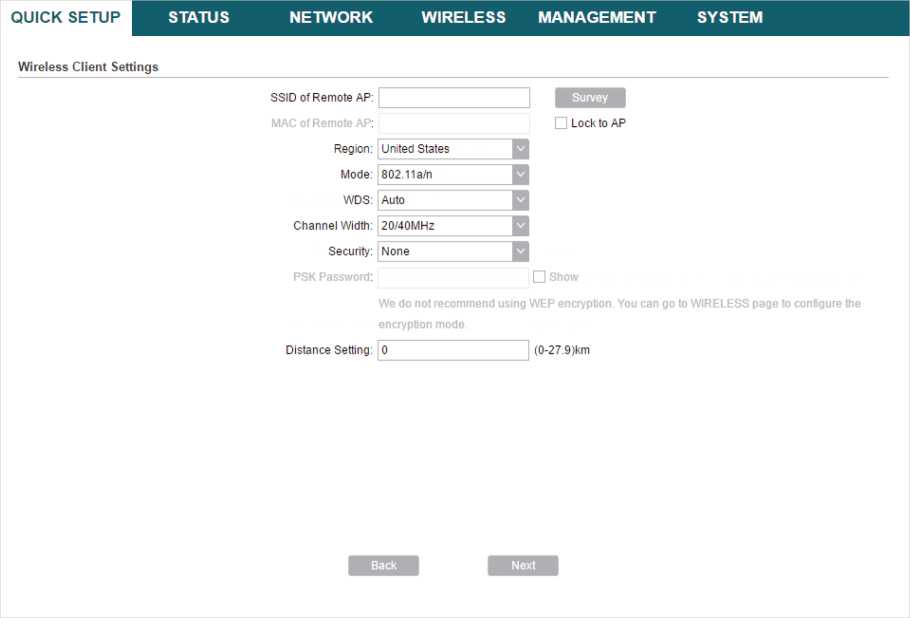
Note:
There may be two or more networks with the same SSID in the AP list. Click Lock to AP to select the SSID and AP simultaneously, which can make the device connect to the specific AP next time.
STATUS NETWORK WIRELESS MANAGEMENT SYSTEM
QUICK SETUP
Wireless Client Settings
| □ | BSSID | SSID | MAXtream | Device Name | SNR (dB) | Signal/Noise (dBm) | Channel | Security | |
| □ | 18-A6-F7-41-26-46 | daisy 3 | No | 42 | -537-95 | 5180 (36) | WPA2-PSK | ||
| □ | 50-C7-BF-27-7F-6E | SR20_5G | No | 50 | -457-95 | 5220 (44) | WPA2-PSK | ||
| □ | 50-C7-BF-17-A6-E3 | EAP-Show | No | 14 | -81/-95 | 5180 (36) | WPA2-PSK | ||
| □ | D4-61-FE-5A-2A-00 | das | No | 11 | -857-96 | 5180 (36) | WPA-PSK/WPA2 -PSK | ||
| □ | 50-C7-BF-48-54-DB | deco | No | 35 | -61/-96 | 5200 (40) | WPA2-PSK | ||
| □ | 50-C7-BF-48-57-1F | deco | No | 30 | -667-96 | 5200 (40) | WPA2-PSK | ||
| □ | 50-C7-BF-48-57-74 | deco | No | 47 | -497-96 | 5200 (40) | WPA2-PSK | ||
| □ | 56-C7-BF-48-54-DB | No | 37 | -597-96 | 5200 (40) | WPA2-PSK | |||
| □ | 56-C7-BF-48-57-1F | No | 31 | -657-96 | 5200 (40) | WPA2-PSK | |||
| □ | 56-C7-BF-48-57-74 | No | 47 | -497-96 | 5200 (40) | WPA2-PSK | |||
| WPA-PSK7WPA2 | |||||||||
Back ■ Refresh
- In the Wireless Client Settings section, specify the wireless parameters to connect to the specified wireless network. Click Next.
Note:
Make sure that the Security and PSK Password are the same as the upstream wireless network’s. Other parameters set in this page and those of the upstream wireless network should be compatible with each other. For details, refer to 5. Configure the Wireless Parameters.
QUICK SETUP
STATUS
NETWORK
WIRELESS MANAGEMENT
SYSTEM
Wireless Client Settings
SSID of Remote AP: [t200 5G
MAC of Remote AP: 50-C7-BF-01-33-1F
Survey
□ Lock to AP
Region: | United States fl
Mode: 3C2 11aJn fl
WDS: | Auto
Channel Width: 2QM0MHZ fl
Security: |wPA-PSK JWPA2-PSK
PSK Password: | □ Show
We do not recommend using WEP encryption. You can go to WIRELESS page to configure the encryption mode.
Distance Setting: 0
] (0-27.g)km
Back
Next
- In the Wireless AP Settings section, specify the parameters to create a new wireless network for the downstream clients. Click Next.
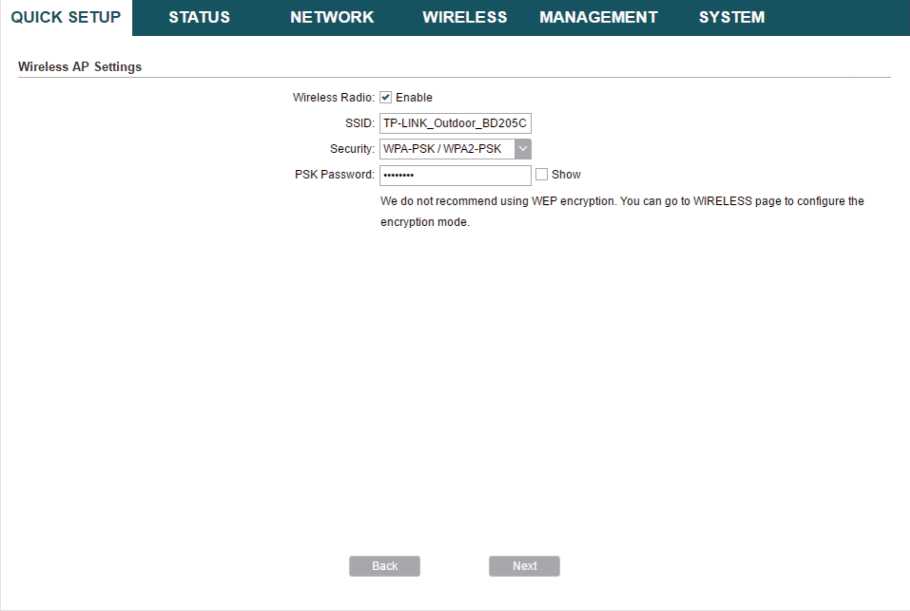
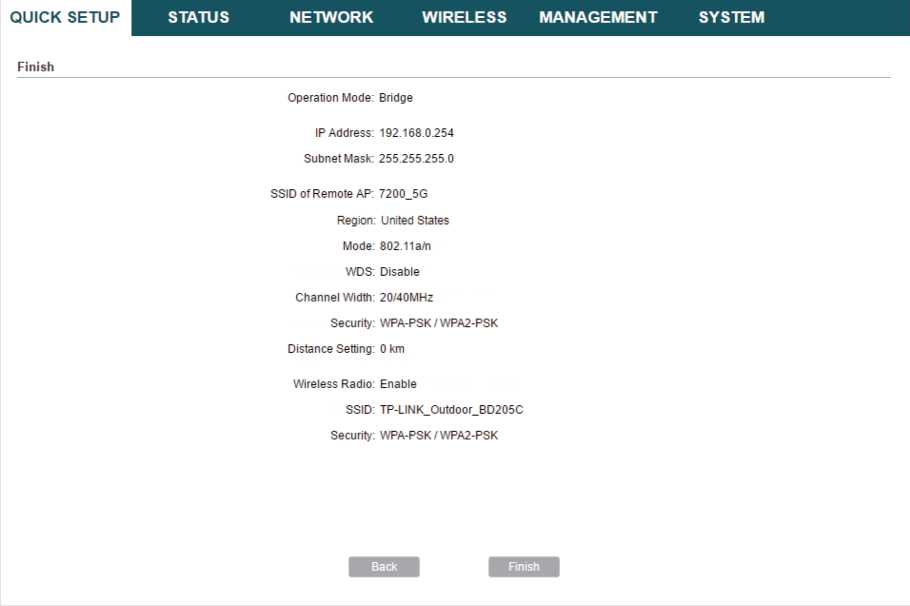
8. Connect the device according to your network topology and use it normally.
Follow the steps below to configure the device as AP Router Mode:
![]()
tp-link PHAROS
QUICK SETUP
STATUS
About Support Log
Operation Mode: AP Client Router ▼ Tools
NETWORK WIRELESS MANAGEMENT SYSTEM
Operation Mode
Please select the proper operation mode according to your needs:
| O Access Point | In this mode, the AP will act as a central hub for different wireless LAN clients. Multi-SSID is also available in this mode, which supports up to 4 different SSIDs and passwords. |
| O Client | In client mode, the device can connect to a wired device and work as a wireless adapter to receive wireless signals from your wireless network. |
| O Repeater | In this mode, the device can copy and reinforce the existing wireless signal to extend the coverage of the signal, especially for a large space to eliminate signal-blind corners. |
| O Bridge | Bridge mode borrows existing wireless internet and broadcasts it using a different SSID and password. In this mode, you can set up a wireless client to connect with a root AP and a wireless AP for local wireless coverage. |
| (•) AP Router | In this mode, the device enables multiple users to share the internet The wireless ports share the same IP address as the Ethernet WAN port to connect to the ISP The wireless port can be regarded as a LAN port while in AP Router mode. |
| O AP Client Router (WISP Client) | In this mode, multiple users can share an internet connection provided by a WISP. The LAN port devices share the same IP as that assigned by the WISP to the Wireless port. While connected to a WISP, the wireless port works as a WAN port in AP Client Router mode. The Ethernet port acts as a LAN port |
Next
The following window will pop up. Click Yes.
• For devices with one Ethernet port.

Note that if you select AP Router as the operation mode, the status of Port0 will change to WAN, and the management access will be disabled on this port after the process of quick setup. If you want to manage the device through Port0, configure the Remote Login IP Address. For details, refer to 6.5. Configure Web Server.
For devices with two Ethernet ports.

Note that if you select AP Router as the operation mode, the status of Port0 will change to WAN, and the management access will be disabled on this port after the process of quick setup. You can connect to the Port1 of the device or wirelessly to manage it. If your want to manage the device through Port0, configure the Remote Login IP Address. For details, refer to 6.5. Configure Web Server.
- In the WAN Connection Type section, specify the connection type according to your need and click Next.
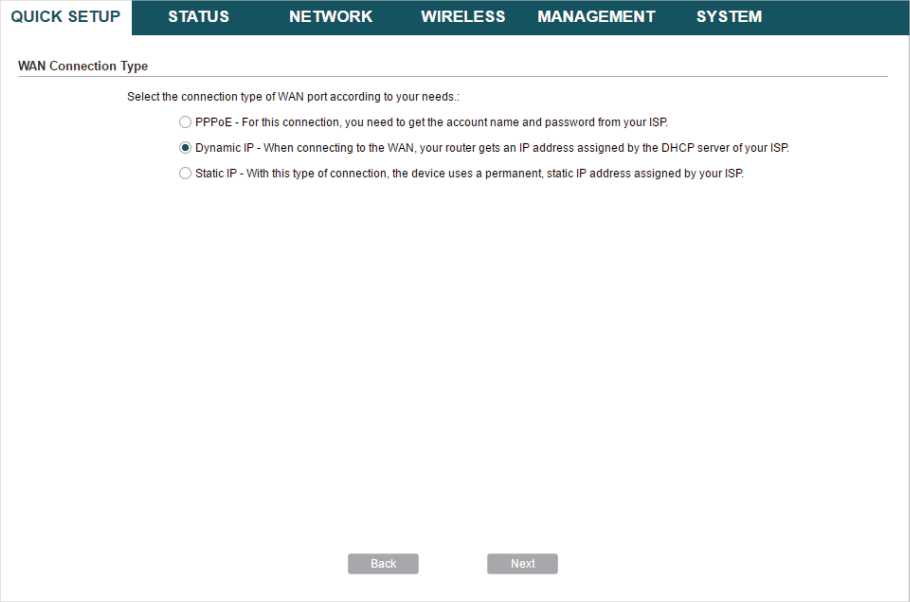
The device supports three types of the WAN connection, including PPPoE, Dynamic IP and Static IP. Contact your ISP to confirm your WAN connection type.
■ PPPoE
Select PPPoE and click Next, then the following page will appear. In the WAN Settings section, specify the parameters that are provided by your ISP and click Next.
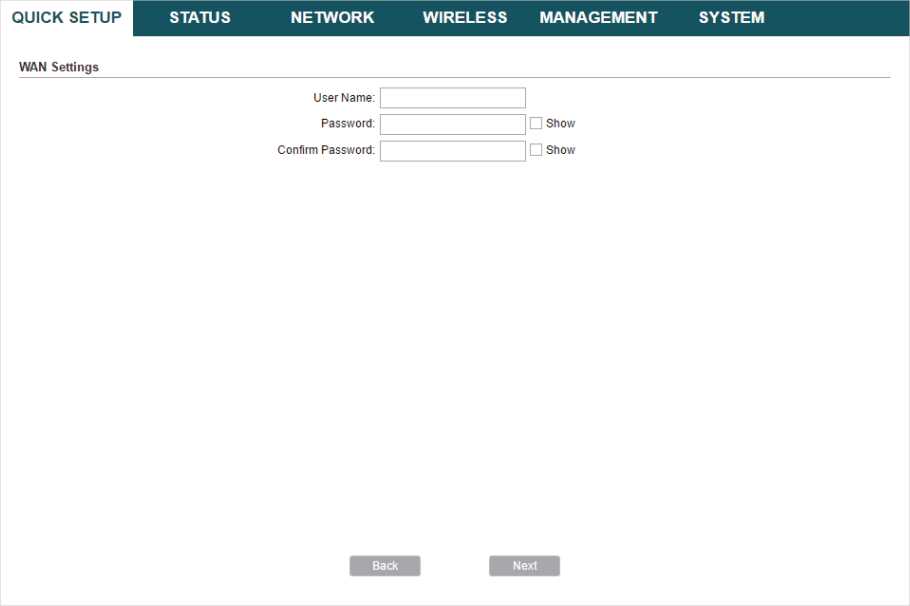
■ Dynamic IP
Select Dynamic IP and click Next. In this type, the device will obtain a WAN connection automatically without any WAN configurations.
■ Static IP
Select Static IP and click Next, then the following page will appear. In the WAN Settings section, specify the parameters that are provided by your ISP and click Next.
STATUS NETWORK WIRELESS MANAGEMENT SYSTEM
QUICK SETUP
WAN Settings
IP Address: 10.0.0.0
Subnet Mask: 10.0.0.0
Default Gateway: 10.0.0.0
Primary DNS: 0.0.0 0
Secondary DNS: [ 0.0.0.0
] (Optional)
Back Next
- In the Wireless AP Settings section, specify the basic wireless parameters to create a wireless network. Click Next.
Note:
• It is recommended to specify Security as WPA-PSK/WPA2-PSK for the network security.
• You can keep the default settings or specify the parameters according to your need. For details, refer to 5. Configure the Wireless Parameters.
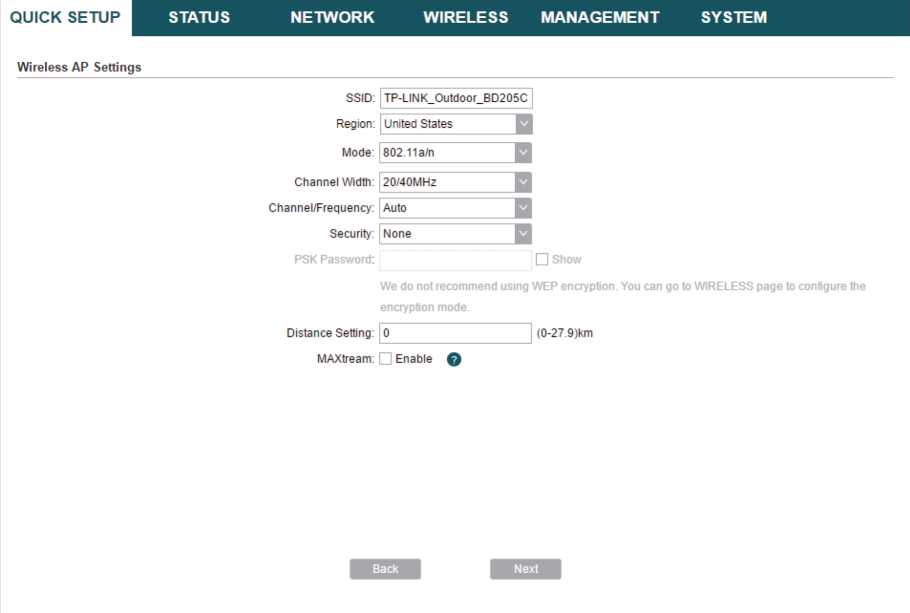
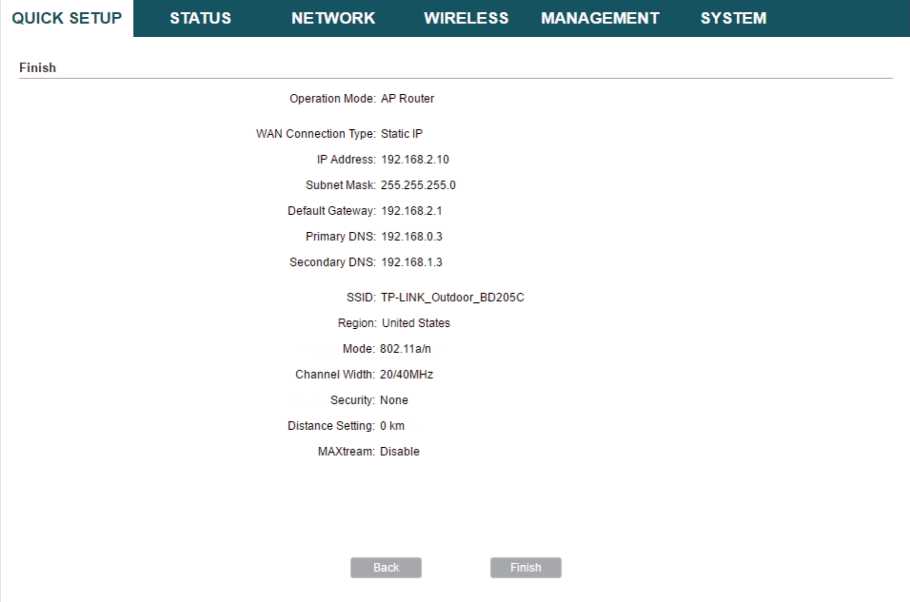
5. Connect the device according to your network topology and use it normally.
AP Client Router (WISP Client)
Follow the steps below to configure the device as AP Client Router (WISP Client) Mode:
About Support Log
q^tp-link PHAROS
Operation Mode: AP Client Router ▼ Tools
QUICK SETUP
STATUS
NETWORK WIRELESS MANAGEMENT SYSTEM
Operation Mode
Please select the proper operation mode according to your needs:
| O Access Point | In this mode, the AP will act as a central hub for different wireless LAN clients. Multi-SSID is also available in this mode, which supports up to 4 different SSIDs and passwords. |
| O Client | In client mode, the device can connect to a wired device and work as a wireless adapter to receive wireless signals from your wireless network. |
| O Repeater | In this mode, the device can copy and reinforce the existing wireless signal to extend the coverage of the signal, especially for a large space to eliminate signal-blind corners. |
| O Bridge | Bridge mode borrows existing wireless internet and broadcasts it using a different SSID and password. In this mode, you can set up a wireless client to connect with a root AP and a wireless AP for local wireless coverage. |
| O AP Router | In this mode, the device enables multiple users to share the internet The wireless ports share the same IP address as the Ethernet WAN port to connect to the ISP. The wireless port can be regarded as a LAN port while in AP Router mode. |
| @ AP Client Router (WISP Client) | In this mode, multiple users can share an internet connection provided by a WISP. The LAN port devices share the same IP as that assigned by the WISP to the Wireless port. While connected to a WISP, the wireless port works as a WAN port in AP Client Router mode. The Ethernet port acts as a LAN port |
Next
The following window will pop up. Click Yes.

Note that if you select AP Client Router (WISP Client) as the operation mode, you will not access the device through the WISP network after the process of quick setup. You can connect to the port of the device or wirelessly to manage it. If you want to manage the device through the WISP network, configure the Remote Login IP Address. For details, refer to 6.5. Configure Web Server.
- In the WAN Connection Type section, choose the connection type according to your need and click Next.
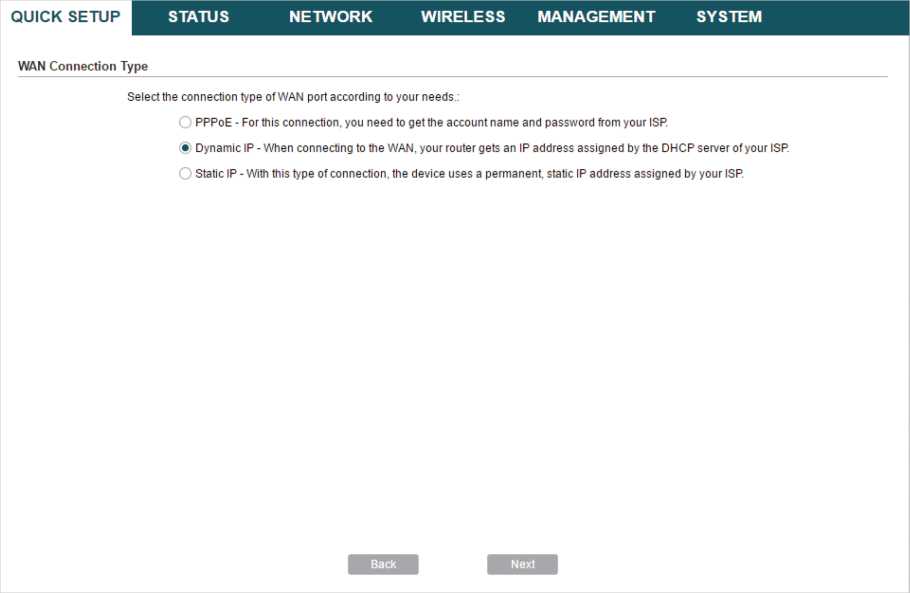
The device supports PPPoE, Dynamic IP and Static IP for the WAN connection. Contact your ISP to confirm your WAN connection type.
■ PPPoE
Select PPPoE and click Next, then the following page will appear. In the WAN Settings section, specify the parameters that are provided by your ISP and click Next.
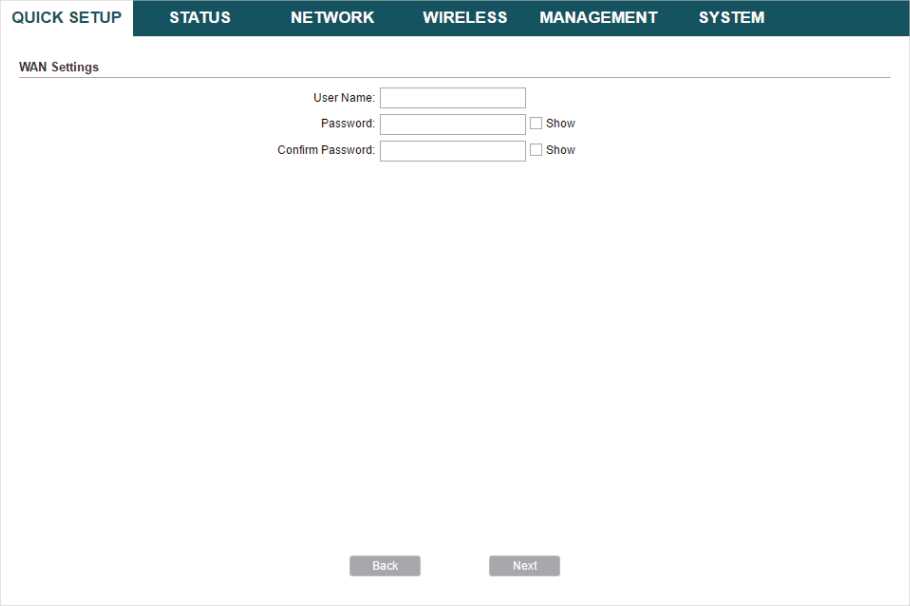
■ Dynamic IP
Select Dynamic IP and click Next. In this type, the device will obtain a WAN connection automatically without any WAN configurations.
■ Static IP
Select Static IP and click Next, then the following page will appear. In the WAN Settings section, specify the parameters that are provided by your ISP and click Next.
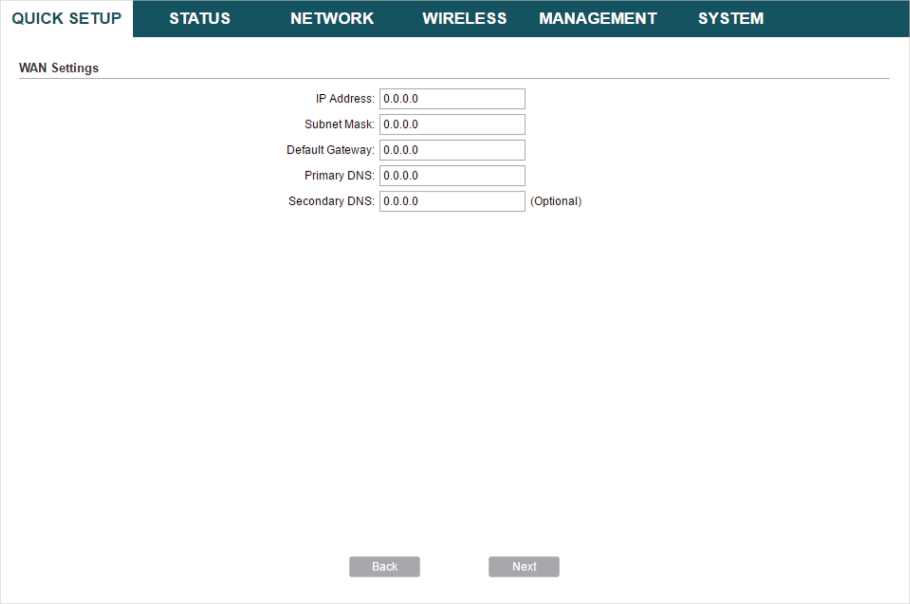
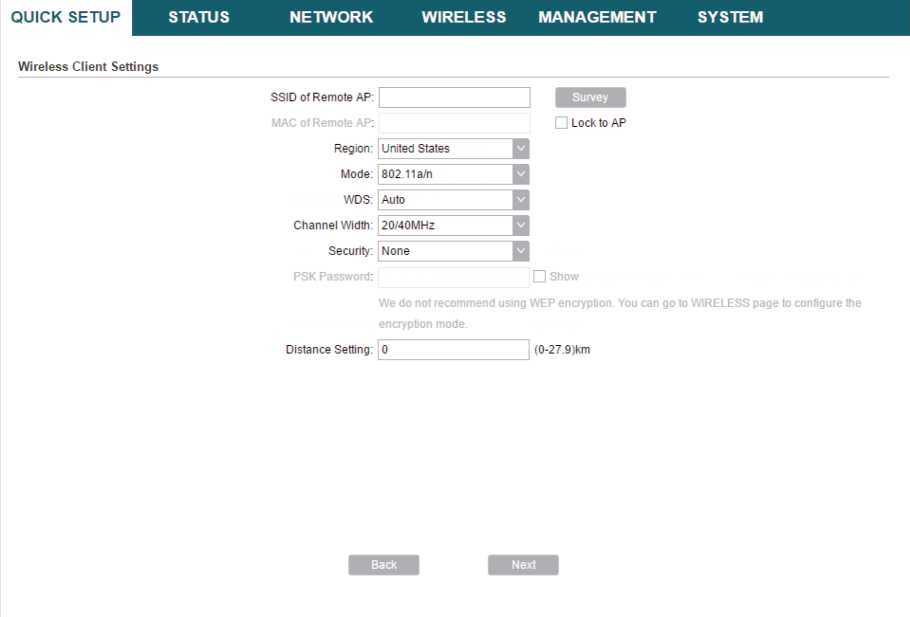
Note:
There may be two or more networks with the same SSID in the AP list. Click Lock to AP to select the SSID and AP simultaneously, which can make the device connect to the specific AP next time.
QUICK SETUP
STATUS
NETWORK
WIRELESS MANAGEMENT
SYSTEM
Wireless Client Settings
| □ | BSSID | SSID | MAXtream | Device Name | SNR (dB) | Signal/Noise (dBm) | Channel | Security | |
| □ | 18-A6-F7-41-26-46 | daisy 3 | No | 42 | -537-95 | 5180 (36) | WPA2-PSK | ||
| □ | 50-C7-BF-27-7F-6E | SR20_5G | No | 50 | -457-95 | 5220 (44) | WPA2-PSK | ||
| □ | 50-C7-BF-17-A6-E3 | EAP-Show | No | 14 | -81/-95 | 5180 (36) | WPA2-PSK | ||
| □ | D4-61-FE-5A-2A-00 | das | No | 11 | -857-96 | 5180 (36) | WPA-PSK/WPA2 -PSK | ||
| □ | 50-C7-BF-48-54-DB | deco | No | 35 | -61/-96 | 5200 (40) | WPA2-PSK | ||
| □ | 50-C7-BF-48-57-1F | deco | No | 30 | -667-96 | 5200 (40) | WPA2-PSK | ||
| □ | 50-C7-BF-48-57-74 | deco | No | 47 | -497-96 | 5200 (40) | WPA2-PSK | ||
| □ | 56-C7-BF-48-54-DB | No | 37 | -597-96 | 5200 (40) | WPA2-PSK | |||
| □ | 56-C7-BF-48-57-1F | No | 31 | -657-96 | 5200 (40) | WPA2-PSK | |||
| □ | 56-C7-BF-48-57-74 | No | 47 | -497-96 | 5200 (40) | WPA2-PSK | |||
| WPA-PSK/WPA2 | |||||||||
Back
Refresh
- In the Wireless Client Settings section, specify the wireless parameters to connect to the specified wireless network. Click Next.
Note:
Make sure that Security and PSK Password are the same as the upstream wireless network’s. Other parameters set in this page and those of the upstream wireless network should be compatible with each other. For details, refer to 5. Configure the Wireless Parameters.
QUICK SETUP
STATUS
NETWORK
WIRELESS MANAGEMENT
SYSTEM
Wireless Client Settings
SSID of Remote AP: [t200 5G
MAC of Remote AP: 50-C7-BF-01-33-1F
Survey
□ Lock to AP
Region: | United States fl
Mode: 3C2 11aJn fl
WDS: | Auto
Channel Width: 2QM0MHZ fl
Security: |wPA-PSK JWPA2-PSK
PSK Password: | □ Show
We do not recommend using WEP encryption. You can go to WIRELESS page to configure the encryption mode.
Distance Setting: 0
] (0-27.g)km
Back
Next
- In the Wireless AP Settings section, specify the parameters to create a new wireless network for the downstream clients. Click Next.
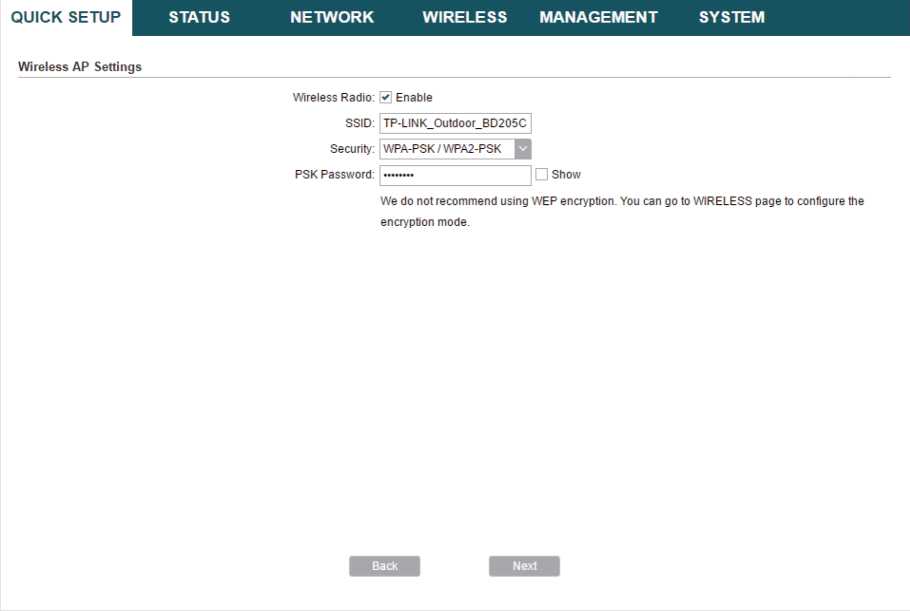
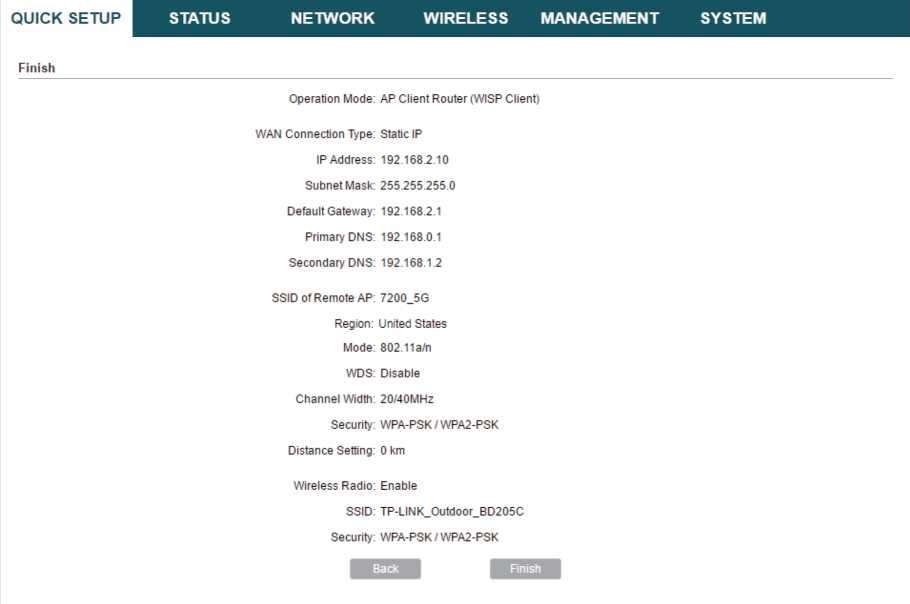
8. Connect the device according to your network topology and use it normally.
This chapter introduces how to monitor the running status and statistics of the wireless network, including:
- View the Device Information
- View the Wireless Settings
- View Wireless Signal Quality
- View Radio Status
- View the LAN Settings
- View the WAN Settings
- Monitor Stations
- Monitor Interfaces
- Monitor ARP Table
- Monitor Routes
- Monitor DHCP Clients
- Monitor Dynamic WAN
- View the Device Information
Go to the STATUS page. In the Device Information section, view the basic information of the device. To configure the device information, refer to 7. Configure the System.
Device Information
Device Name: CPE 510
Device Model: CPE510 v30
Firmware Version: 2.0 0 Build 20160908 Rel. 36610 (5553)
System Time: 2015-01-01 04:37:41
Uptime: 0 days 04:37:43
CPU: I 1%
Memory: 53%
| Device Name | Displays the name of the device. By default, it is the product model. |
| Device Model | Displays the product model and the hardware version of the device. |
| Firmware
Version |
Displays the current firmware version of the device. |
| System Time | Displays the current system time. |
| Uptime | Displays the running time of the device. |
| CPU | Displays the CPU occupancy. |
Memory
Displays the memory occupancy.
Go to the STATUS page. In the Wireless Settings section, view the parameters of the wireless network created by the device. To configure the parameters, refer to 5. Configure the Wireless Parameters.
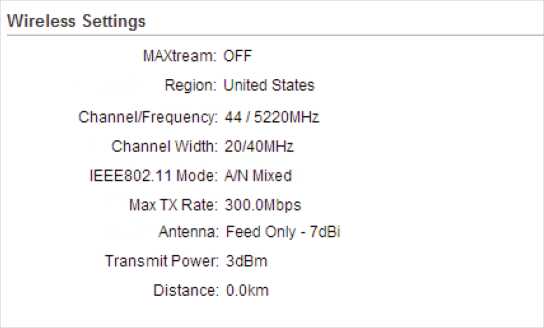
| MAXtream | Note:
Displays the status of the MAXtream function. This function is only available in Access Point Mode and AP Router Mode. MAXtream is a TP-Link proprietary technology. It is based on TDMA (Time Division Multiple Access) so that data streams are transmitted in their own time slots. MAXtream aims to maximize throughput and minimize latency. “Hidden nodes” problem can also be eliminated with MAXtream enabled. |
| Region | Displays the region where you use the device. Available channels and maximum Transmit Power will be determined by the selected region according to the local laws and regulations. |
| Channel/ Frequency | Displays the channel and frequency which are currently used by the device. |
| Channel Width | Displays the channel width which is currently used by the device. |
| IEEE802.11
Mode |
Displays the IEEE802.11 protocol currently used by the device. |
| Max TX Rate | Displays the maximum data rate of the device during the sending of the wireless packets. |
| Antenna | Displays the antenna that you use. |
| Transmit Power | Displays the transmit power which is currently used by the device. |
| Distance | Displays the wireless coverage distance. In the coverage of the device, the clients can be placed to get good wireless performance. |
Go to the STATUS page. In the Wireless Signal Quality section, view the current signal quality of the upstream wireless network. It is only applicable for the Client, Repeater, Bridge and AP Client Router (WISP Client) Modes.

Signal Strength Displays the received wireless signal strength of the root AP. There are two display modes. Values of the two chains are displyed separately in Horizontal/Vertical Mode, and together in Combined Mode. You can switch between display modes by clicking on it.
Noise Strength Displays the received environmental noise from wireless interference on the operating frequency.
SNR Displays the Signal to Noise Ratio (SNR) of the device. SNR refers to
the power ratio between the received wireless signal strength and the environmental noise strength. The larger SNR value is, the better network performance the device can provide.
Transmit CCQ Displays the wireless Client Connection Quality (CCQ). CCQ refers to the ratio of effective transmission bandwidth and the actual total bandwidth. It reflects the quality of the actual link. A larger value means a better utilization of the bandwidth.
3.4
Go to the STATUS page. In the Radio Status section, view the radio status of the device.
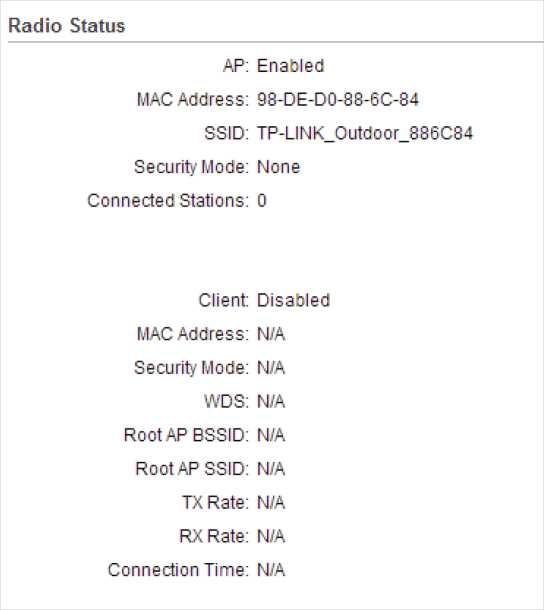
AP Status.
| AP | Displays the status of the wireless AP function. With this enabled, the device can provide a wireless network for the clients. By default, it is enabled in Access Point, Repeater, Bridge, AP Router and AP Client Router Modes and disabled in Client Mode. |
| MAC Address | Displays the MAC address of the wireless interface connected to the clients. |
| SSID | Displays the wireless network name (SSID) created by the device. |
| Security Mode | Note:
WEP is only available on certain devices. To check whether your device supports this feature, refer to the actual web interface. Displays the security mode you’ve selected for your wireless network. There are three security modes: WPA-PSK, WPA and WEP. None means that no security mode is selected and all the hosts are allowed to access the wireless network directly. The security mode which is set on the clients should be the same as that on this device. |
| Connected
Stations |
Displays the number of the connected stations. |
Client Status.
| Client | Displays the status of the wireless client function. With this function enabled, the device can connect to the root AP through wireless connection. By default, it is enabled in Client, Repeater, Bridge and AP Client Router Modes and disabled in Access Point and AP Router Modes. |
| MAC Address | Displays the MAC address of the wireless interface connected to the root AP. |
| Security Mode | Note:
WEP is only available on certain devices. To check whether your device supports this feature, refer to the actual web interface. Displays the security mode you’ve selected for your wireless network. There are three security modes: WPA-PSK, WPA and WEP. None means that no security mode is selected and all the hosts are allowed to access the wireless network directly. The security mode which is set on the device should be the same as that on the root AP. |
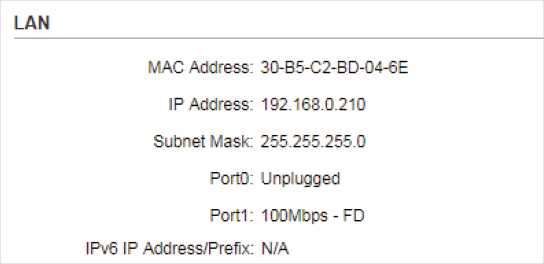
WDS
Displays the status of the WDS (Wireless Distribution System) function. WDS is a communication system among multiple wireless networks . It is established between APs through wireless connection. WDS is used during the connection process between the device and the root AP.
Enable: Forward data frames using four address fields.
Disable: Forward data frames using three address fields.
Auto: The device automatically negotiates the wireless data frame structure (three or four address fields) with the root AP. The selection of Auto is recommended.
| Root AP BSSID | Displays the BSSID (Basic Service Set ID) of the root AP. BSSID is used to identify a BSS. Each BSS has its own BSSID. The BSSID is decided by the manufacturers, and it is usually related to the device’s MAC address. |
| Root AP SSID | Displays the wireless network name of the root AP. |
| TX Rate | Displays the data rate of the device during the sending of the wireless packets. |
| RX Rate | Displays the data rate of the device during the receiving of the wireless packets. |
| Connection
Time |
Displays the amount of time the device has been connected to the root AP. |
Go to the STATUS page. In the LAN section, view the LAN information of the device. To configure the LAN settings, refer to 4. Configure the Network.
| MAC Address | Displays the LAN port MAC address of the device. |
| IP Address | Displays the LAN port IP address of the device. |
| Subnet Mask | Displays the subnet mask of the LAN. |
Displays the current status of the LAN Ethernet port connections and the Maximum transmission rate of the plugged port.
Port
IPv6 IP Address/Prefix Displays the LAN port IPv6 address and prefix of the device.
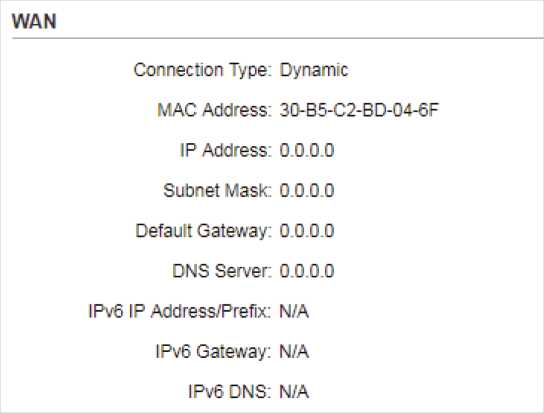 Go to the STATUS page. In the WAN section, view the WAN information of the device. To configure the WAN settings, refer to 4. Configure the Network.
Go to the STATUS page. In the WAN section, view the WAN information of the device. To configure the WAN settings, refer to 4. Configure the Network.
| Connection Type | Displays the connection type of the device. |
| MAC Address | Displays the MAC address of the wireless interface connected to the root AP. |
| IP Address | Displays the IP address of the wireless interface connected to the root AP. |
| Subnet Mask | Displays the subnet mask of the wireless interface connected to the root AP. |
| Default Gateway | Displays the default gateway. |
| DNS Server | Displays the DNS server. |
| IPv6 IP Address/Prefix | Displays the WAN port IPv6 address and prefix of the device. |
| IPv6 Gateway | Displays the default IPv6 gateway. |
| IPv6 DNS | Displays the IPv6 DNS server. |
Go to the STATUS page. In the Monitor section, select Throughput and monitor the current data traffic of specified interfaces including LAN, WAN, WLAN, WWAN and BRIDGE. Note that the interfaces which you can monitor are different among different operation modes.
Monitor
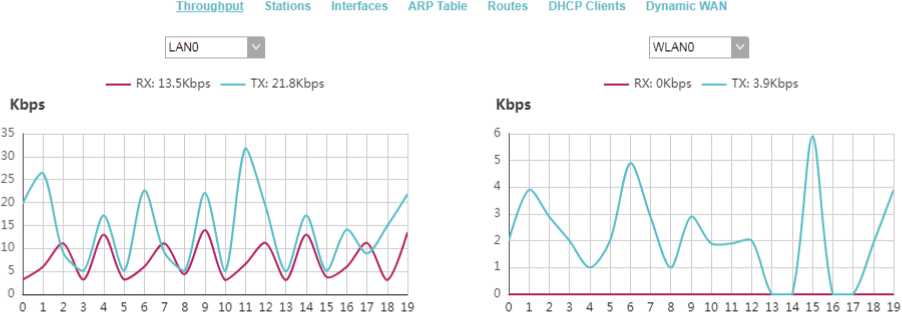
Go to the STATUS page. In the Monitor section, select Stations and monitor the information of all the stations that are connected to the device.
Monitor
Throughput Stations Interfaces ARP Table Routes DHCP Clients Dynamic WAN
| MAC Address | Device Name | Associated
SSID |
Signal / Noise(dBm) ChainO/Chainl | CCQ
(%) |
Negotiated Rate (Mbps) | Data TX / RX (kbps) | Distance (km) | IP Address | Connection Time |
| E4-B2-FB-7B-02-7F | CPE 510 | TP-Link_Outdoo r_EF44BC | -44/-34.-90/-90 | 93 | 300.0 | 169/3962 | 0.00 | 192.168.0.100 | 0 days 00:04:01 |
< Auto Refresh
| MAC Address | Displays the MAC address of the station. |
| Device Name | Displays the device name of the station. |
| Associated
SSID |
Displays the SSID that the station is connected to. |
| Signal/Noise (dBm) | Displays the signal strength and the noise strength of the wireless network. There are two display modes. Values of the two chains are displayed separately in Chain0/Chain1 Mode, and together in Combined Mode. You can switch between display modes by clicking on it. |
CCQ (%)
Displays the wireless Client Connection Quality (CCQ). CCQ refers to the ratio of effective transmission bandwidth and the actual total bandwidth. It reflects the quality of the actual link. A larger value means a better utilization of the bandwidth.
Negotiated Rate Displays the negotiated rates of the packets which the device transmits to
| Data TX/RX (kbps) | Displays the data rates of the last transmitted and received packets. TX means that the device transmits data to the station, while RX means that the device receives data from the station. |
| Distance (km) | Displays the distance between the device and the station. |
| IP Address | Displays the IP address of the station. |
| Connection
Time |
Displays the connection duration. |
(Mbps) the station.
| Auto Refresh | Enable or disable Auto Refresh. With this feature enabled, the table will refresh automatically. |
Click the MAC Address of a station to view the detailed information.
Station E4-B2-FB-7B-02-7F
| Device Name: | Negotiated Rate Last Signal. dBm | ||
| Product: | 6.0Mbps | N/A | |
| Firmware: | 9.0Mbps | N/A | |
| Connection Time: | 00:10:30 | 12.0Mbps | N/A |
| RX Signal: | -33 dBm | 18.0Mbps | N/A |
| 24.0Mbps | -33 | ||
| Noise Floor: | -90 dBm | N/A | |
| 36.0Mbps | |||
| CCQ: | 100% | ||
| 48.0Mbps | N/A | ||
| Last IP: | 192.1680 101 | 54.0Mbps | N/A |
| TX/RX Rate: | 300.0Mbps/24.0Mbps | ||
| TX/RX Bit Rate: | 0.00kbps /0.00kbps | ||
| TX/RX Packets: | 553/2241 | ||
| TX/RX Packets Rate.pps: | 0/0 | ||
| Bytes Transmitted: | 87653 (85.60kBytes) | ||
| Bytes Received: | 169733 (165.75kBytes) | ||
Refresh
Device Name Displays the device name of the station.
Product
Displays the product name of the station.
Firmware Displays the firmware version of the station.
Connection Time Displays the connection duration.
| Noise Floor | Displays the noise strength of the wireless network. |
| CCQ | Displays the wireless Client Connection Quality (CCQ). CCQ refers to the ratio of effective transmission bandwidth and the actual total bandwidth. It reflects the quality of the actual link. A larger value means a better utilization of the bandwidth. |
| Last IP | Displays the IP address of the station. |
| TX/RX Rate | Displays the negotiated rates of the transmitted and received packets. TX means that the device transmits data to the station, while RX means that the device receives data from the station. |
| TX/RX Bit Rate | Displays the data rates of the last transmitted and received packets. TX means that the device transmits data to the station, while RX means that the device receives data from the station. |
| TX/RX Packets | Displays the total number of the transmitted and received packets. TX means that the device transmits data to the station, while RX means that the device receives data from the station. |
| TX/RX Packets Rate, pps | Displays the packet rates of the transmitted and received packets. TX means that the device transmits data to the station, while RX means that the device receives data from the station. |
| Bytes
Transmitted |
Displays the total amount of data which the device transmits to the station. |
| Bytes Received | Displays the total amount of data which the device receives from the station. |
| Negotiated Rate | Displays the possible negotiated rates of the packets which the device receives from the station. |
| Last Signal, dBm | Displays the signal strength of the last packet which the device receives from the station at the corresponding negotiated rate. |
RX Signal
Displays the signal strength of the wireless network.
Click the IP Address of a station to access the web management page of the station.
Go to the STATUS page. In the Monitor section, select Interfaces and monitor the relevant information of the interfaces.
| Throughput Stations Interfaces | ARP Table | Routes DHCP Clients | |||||
| Interface | MAC | IP Address | MTU | RX Packets | RX Bytes | TX packets | TX Bytes |
| LANO | 30-B5-C2-BD-20-CC | o.o.o.o | 1500 | 0 | 0 | 0 | 0 |
| LAN1 | 30-B5-C2-BD-20-CC | o.o.o.o
fe80::203:7fff:feff:fffe/64 |
1500 | 40336 | 5M | 13691 | 4M |
| BRIDGE | 30-B5-C2-BD-20-CC | 192.168.0.251 fe80::32b5:c2ff:febd:20cc/64 | 1500 | 40245 | 4M | 13697 | 3M |
| WLANO | 30-B5-C2-BD-20-CC | O.O.O.O fe80::32b5:c2ff:febd:20cc/64 | 1500 | 0 | 0 | 0 | 0 |
| Auto Refresh | |||||||
| Interface | Displays the interface of the device. |
| MAC | Displays the MAC address of the interface. |
| IP Address | Displays the IP address and IPv6 address of the interface. |
| MTU | Displays the Maximum Transmission Unit (MTU) of the interface. It is the maximum packet size (in bytes) that the interface can transmit. |
| RX packets | Displays the total amount of packets received by the interface after the device is powered on. |
| RX Bytes | Displays the total amount of data (in bytes) received by the interface after the device is powered on. |
| TX packets | Displays the total amount of packets sent by the interface after the device is powered on. |
| TX Bytes | Displays the total amount of data (in bytes) sent by the interface after the device is powered on. |
| Auto Refresh | Enable or disable Auto Refresh. With this feature enabled, the table will refresh automatically. |
Go to the STATUS page. In the Monitor section, select ARP Table and monitor the ARP (Address Resolution Protocol) information recorded by the device.
ARP is used to associate each IP address to the unique hardware MAC address of each device on the network.
Monitor
Throughput Stations Interfaces ARP Table Routes DHCP Clients
| IP Address | MAC | Interface |
| 192.168.0.200 | 00-19-66-35-E1-B0 | BRIDGE |
| 192.168.0.16 | 00-0A-EB-13-23-7B | BRIDGE |
| 192.168.0.61 | F4-F2-6D-C 3-28-62 | BRIDGE |
| 169.254.60.119 | DC-9B-9C-D 3-17-61 | BRIDGE |
Z Auto Refresh
| IP Address | Displays the IP address of the corresponding ARP entry. |
| MAC | Displays the MAC address of the corresponding ARP entry. |
| Interface | Displays the interface connected to the device. |
| Auto Refresh | Enable or disable Auto Refresh. With this feature enabled, the table will refresh automatically. |
Go to the STATUS page. In the Monitor section, select Routes and monitor the routing entries recorded by the device in the Routing table. Routing table is used for the device to decide the interface to forward the packets. You can enable or disable Auto Refresh. With this feature enabled, the table will refresh automatically.
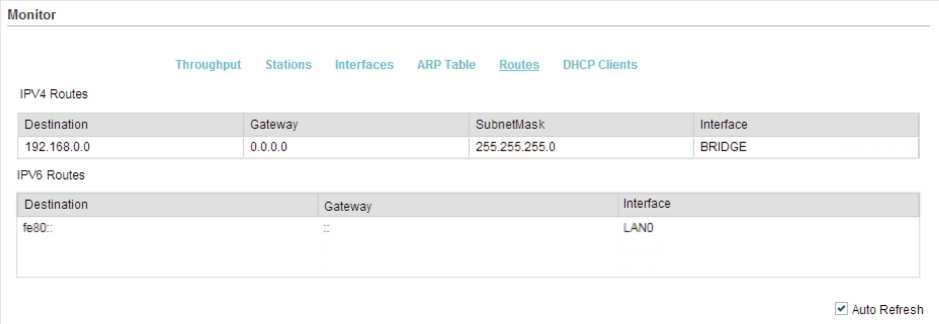
IPv4 Routes
| Destination | Displays the IP address of the destination device or destination network. |
| Gateway | Displays the IP address of the appropriate gateway. |
| SubnetMask | Displays the Subnet Mask of the destination network. |
Displays the interface that the destination device is on.
Interface
IPv6 Routes
| Destination | Displays the IPv6 address of the destination device or destination network. |
| Gateway | Displays the IPv6 address of the appropriate gateway. |
| Interface | Displays the interface that the destination device is on. |
Go to the STATUS page. In the Monitor section, select DHCP Clients and monitor the information of all the DHCP clients.
| Throughput Stations Interfaces | ARP Table Routes DHCP Clients | Dynamic WAN | |
| Client Name | MAC Address | Assigned IP | Lease Time |
| Jim | 00-0A-EB-21-01-10 | 192.168.0.102 | 0 days 01:57:57 |
| * Auto Refresh | |||
| Client Name | Displays the device name of the client. |
| MAC Address | Displays the MAC address of the client. |
| Assigned IP | Displays the IP address that the device assigned to the client. |
| Lease Time | Displays the time that the client leased. When the time expires, the clients will request to renew the lease automatically. |
| Auto Refresh | Enable or disable Auto Refresh. With this feature enabled, the table will refresh automatically. |
Note:
Dynamic WAN submenu is only available in AP Router Mode and AP Client Router (WISP Client) Mode when the WAN connection type is PPPoE, PPTP, L2TP or Dynamic.
Go to the STATUS page. In the Monitor section, select Dynamic WAN and monitor the WAN connection status of the device. You can enable or disable Auto Refresh. With this feature enabled, the table will refresh automatically.
Throughput Stations Interfaces ARP Table Routes DHCP Clients Dynamic WAN
DHCP Status
Primary DNS: 0.0.0.0
Status: Disconnected
Secondary DNS: 0.0.0.0
IP Address: 0.0.0.0
Connection Uptime: 0 days 00:00:00
Subnet Mask: 0 0 0 0
Obtain
Gateway IP: 0.0.0 0
DHCPv6 Status
Primary DNS:
Status: Connected
Secondary DNS:
IP Address
Connection Uptime: 0 days 00:00:00
Subnet Mask:
Release
Gateway IP:
± Auto Refresh
DHCP Status
| Status | Displays the status of the WAN connection. |
| IP Address | Displays the IP address of the WAN. |
| Subnet Mask | Displays the subnet mask of the WAN. |
| Gateway IP | Displays the gateway address of the device. |
| Primary DNS | Displays the primary DNS of the device. |
| Secondary DNS | Displays the secondary DNS of the device. |
| Connection
Uptime |
Displays the time that the latest WAN connection lasts. |
| Obtain | Click Obtain to obtain the WAN IP address from the upstream device. |
| Release | Click Release to release the WAN IP address. |
DHCPv6 Status
| Status | Displays the status of the WAN connection. |
| IP Address | Displays the IPv6 address of the WAN. |
| Subnet Mask | Displays the subnet mask of the WAN. |
| Gateway IP | Displays the gateway address of the device. |
| Secondary DNS | Displays the secondary DNS of the device. |
| Connection
Uptime |
Displays the time that the latest WAN connection lasts. |
| Obtain | Click Obtain to obtain the WAN IPv6 address from the upstream device. |
| Release | Click Release to release the WAN IPv6 address. |
Primary DNS
Displays the primary DNS of the device.
This chapter introduces how to configure the network parameters and the advanced features, including:
- Configure WAN Parameters
- Configure LAN Parameters
- Configure Management VLAN
- Configure the Forwarding Feature
- Configure the Security Feature
- Configure Access Control
- Configure Static Routing
- Configure Bandwidth Control
Note:
WAN submenu is only available in AP Router Mode and AP Client Router (WISP Client) Mode.
WAN submenu is used to create the WAN connection and configure the related advanced
parameters.
Go to the Network page. In the WAN section, configure the WAN parameters of the device.

Follow the steps below to configure the WAN parameters:
- Select the connection type according to your need. The device supports five types: Static, Dynamic, PPPoE, L2TP, and PPTP.
Note:
L2TP or PPTP is only available on certain devices. To check whether your device supports this feature, refer to the actual web interface.
■ Static
This connection type uses a permanent, fixed (static) IP address that is assigned by your ISP. In this type, you should fill in the IP address, Netmask, Gateway IP, and DNS IP address manually, which are assigned by your ISP.
WAN
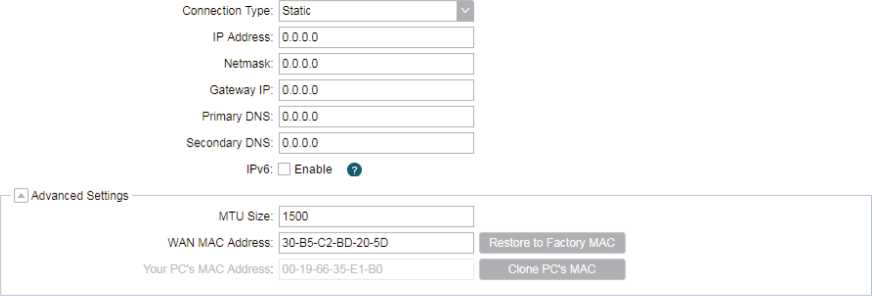
| IP address | Enter the IP address provided by your ISP. |
| Netmask | Enter the netmask provided by your ISP. Normally use 255.255.255.0. |
| Gateway IP | Enter the gateway IP address provided by your ISP. |
| Primary DNS | Enter the DNS IP address provided by your ISP. |
| Secondary DNS | Enter alternative DNS IP address if your ISP provides it. |
| IPv6 | Enable or disable the IPv6 function. If the IPv6 function is enabled, the device will obtain a WAN IPv6 address. Select a method for the device to obtain the WAN IPv6 address according to the information provided by your ISP.
Select static and enter the WAN IPv6 address, IPv6 netmask, IPv6 gateway, primary DNS and secondary DNS provided by your ISP. IPv6: H Enable 0 IPv6 Address: • Static Q) SLAAC O DHCPv6 0 IPv6 Address: | | IPv6 Netmask: 64 | IPv6 Gateway. Primary DNS. Secondary DNS.
Select SLAAC and the device will obtain the WAN IPv6 address automatically. IPv6: 0 Enable 0 IPv6 Address: O Static SLAAC O DHCPv6 0
Select DHCPv6 and the device will obtain the WAN IPv6 address automatically. IPv6: 0 Enable 0 IPv6 Address: Q Static O SLAAC (g) DHCPv6 0 |
| MTU Size | The normal MTU (Maximum Transmission Unit) value for most Ethernet networks is 1500 Bytes. For some ISPs you need to modify the MTU. But this is rarely required, and should not be done unless you are sure it is necessary for your ISP connection. This number should be an integer between 576 and 2026. |
| WAN MAC
Address |
Specify the MAC address of WAN interface. This field displays the current MAC address of the WAN port. If your ISP requires that you register the MAC address, enter the correct MAC address into this field. The format for the MAC Address is XX-XX-XX-XX-XX-XX (X is any hexadecimal digit). Click Restore Factory MAC to restore the MAC address of WAN port to the factory default value. |
| Your PC’s MAC Address | Displays the MAC address of the PC that is managing the device. Some ISPs require that you should register the MAC address of your PC. If the MAC address is required, click Clone PC’s MAC to set the WAN MAC address the same as your management PC’s MAC address. |
■ Dynamic
For this connection, your ISP uses a DHCP server to assign your router an IP address for connecting to the internet. You don’t need to configure any parameters.
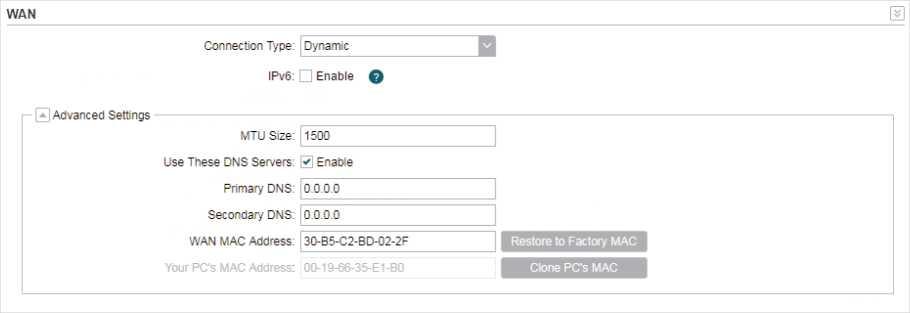
IPv6 Enable or disable the IPv6 function. If the IPv6 function is enabled, the
device will obtain a WAN IPv6 address. Select a method for the device to obtain the WAN IPv6 address according to the information provided by your ISP.
• Static
Select static and enter the WAN IPv6 address, IPv6 netmask, IPv6 gateway, primary DNS and secondary DNS provided by your ISP.
IPv6. 0 Enable @ IPv6 Address: ® Static O SLAAC ODHCPv6 @
IPv6 Address
IPv6 Netmask- [64
Secondary DNS:
• SLAAC
Select SLAAC and the device will obtain the WAN IPv6 address automatically.
I
IPv6: 0 Enable 0
IPv6 Address: Q Static (• SLAAC O DHCPv6 Q
• DHCPv6
Select DHCPv6 and the device will obtain the WAN IPv6 address automatically.
I
IPv6: 0 Enable 0
IPv6 Address: O Static O SLAAC (g) DHCPv6 Q
| MTU Size | Specify the MTU size. The normal MTU (Maximum Transmission Unit) value for most Ethernet networks is 1500 Bytes. For some ISPs you need to modify the MTU. But this is rarely required, and should not be done unless you are sure it is necessary for your ISP connection. This number should be an integer between 576 and 2026. |
| Use These DNS
Servers |
If your ISP gives you one or two DNS IP addresses, select Use These DNS Servers and enter the Primary DNS and Secondary DNS into the correct fields. Otherwise, the DNS servers will be assigned from ISP dynamically. |
| Primary DNS | Enter the DNS IP address provided by your ISP. |
| Secondary DNS | Enter another DNS IP address provided by your ISP. |
| WAN MAC
Address |
Specify the WAN MAC address. This field displays the current MAC address of the WAN port. If your ISP binds the MAC address of your previous computer/router, enter the correct MAC address into this field. The format for the MAC Address is XX-XX-XX-XX-XX-XX (X is any hexadecimal digit). Click Restore Factory MAC to restore the MAC address of WAN port to the factory default value. |
| Your PC’s MAC Address | Displays the MAC address of the PC that is managing the device. Some ISPs require that you should register the MAC address of your PC. If the MAC address is required, click Clone PC’s MAC to set the WAN MAC address the same as your management PC’s MAC address. |
■ PPPoE
If your ISP delivers internet through phone line and provides you with username and password, you should choose this type. Under this condition, you should fill in both User Name and Password that the ISP supplied. Note that these fields are case-sensitive.
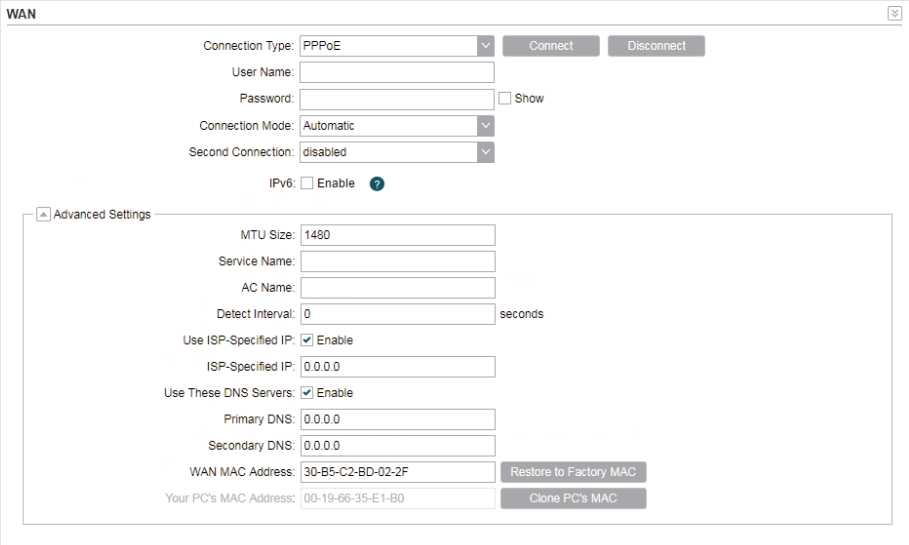
Specify the parameters below and click Connect:
User Name Enter the User Name that is provided by your ISP.
Password Enter the Password that is provided by your ISP.
Select the Connection Mode.
Connection
Mode
• On Demand
 Configure the device to disconnect your internet connection after a specified period of inactivity (Idle Time). If your internet connection has been terminated due to inactivity, Connection on Demand enables the device to automatically re-establish your connection when you attempt to access the internet again. The default Idle Time is 15 minutes. If your internet connection is expected to remain active all the time, enter 0 in the Idle Time field. If you pay by time for your internet access, choose this mode to save your internet-access fee.
Configure the device to disconnect your internet connection after a specified period of inactivity (Idle Time). If your internet connection has been terminated due to inactivity, Connection on Demand enables the device to automatically re-establish your connection when you attempt to access the internet again. The default Idle Time is 15 minutes. If your internet connection is expected to remain active all the time, enter 0 in the Idle Time field. If you pay by time for your internet access, choose this mode to save your internet-access fee.
Connection Mode:
On Demand
Idle Time:
15
minutes
Connect automatically after the device is disconnected. If you are charged a flat monthly fee, choose this mode.
Configure the device to make it connect or disconnect based on time. Enter the start time in From (HH:MM) for connecting and end time in To (HH:MM) for disconnecting. If you need to control the time period of internet access, choose this mode.
Connection Mode:
From(HH:MM):
To(HH:MM):
• Manual
Configure the device to make it connect or disconnect manually. After a specified period of inactivity (Idle Time), the device will disconnect your internet connection, and you must click Connect manually to access the internet again. If your internet connection is expected to remain active all the times, enter 0 in the Idle Time field. Otherwise, enter the desired Idle Time in minutes you wish to use. If you pay by time for your internet access, choose this mode to save your internetaccess fee.
Connection Mode:
Manual
Idle Time:
15
1 minutes
| Second
Connection |
Note:
Second Connection is only available on certain devices. To check whether your device supports this feature, refer to the actual web interface. If your ISP provides an extra Connection type such as Dynamic/Static IP to connect to a local area network, activate this secondary connection. Disable: The Secondary Connection is disabled by default, so there is PPPoE connection only. This is recommended. Dynamic IP: Use dynamic IP address to connect to the local area network provided by ISP. Static IP: Use static IP address to connect to the local area network provided by ISP. |
| IPv6 | Enable or disable the IPv6 function. If the IPv6 function is enabled, the device will obtain a WAN IPv6 address. Select a method for the device to obtain the WAN IPv6 address according to the information provided by your ISP.
Select SLAAC and the device will obtain the WAN IPv6 address automatically. IPv6: 0 Enable Q IPv6 Address O Static (§) SLAAC Q DHCPv6 Q
Select DHCPv6 and the device will obtain the WAN IPv6 address automatically. IPv6: M Enable Q IPv6 Address: O Stade Q SLAAC @ 0HCPv6 Q |
| MTU Size | Specify the MTU size. The default MTU (Maximum Transmission Unit) size is 1480 bytes, which is usually appropriate. For some ISPs, you need modify the MTU. This should not be done unless your ISP told you to. This number should be an integer between 576 and 2026. |
| Service Name | Specify the Service Name provided by your ISP. Keep it empty if your ISP doesn’t provide the name. |
| AC Name | Specify the AC Name provided by your ISP. Keep it empty if your ISP doesn’t provide the name. |
| Detect Internal | Specify the Detect Interval. The default value is 0. Input the value between 0 and 120. The device will detect Access Concentrator online every interval seconds. If the value is 0, it means not detecting. |
| Use
ISP-specified IP |
If your service provider provides you with an IP address along with the user name and password, Enable “Use ISP-specified IP” and enter the IP address. |
| Use These DNS
Servers |
If the ISP provides a DNS server IP address for you, Enable Use These DNS Server, and fill the Primary DNS and Secondary DNS fields below. Otherwise, the DNS servers will obtain automatically from ISP. |
| WAN MAC
Address |
Specify the WAN MAC address. This field displays the current MAC address of the WAN port. If your ISP binds the MAC address of your previous computer/router, enter the correct MAC address into this field. The format for the MAC Address is XX-XX-XX-XX-XX-XX (X is any hexadecimal digit). Click Restore Factory MAC to restore the MAC address of WAN port to the factory default value. |
| Your PC’s MAC Address | Displays the MAC address of the PC that is managing the device. Click Clone PC’s MAC to set the WAN MAC address the same as your management PC’s MAC address. |
| Restore to
Factory MAC |
Click this button to restore the WAN MAC address as factory MAC address. |
| Clone PC’s MAC | Click this button to set the WAN MAC address as PC’s MAC address. |
■ L2TP/PPTP
Note:
L2TP or PPTP is only available on certain devices. To check whether your device supports this feature, refer to the actual web interface.
If your ISP supplies internet access through L2TP or PPTP, it will provide the following parameters. The configurations of L2TP and PPTP are the same, and the following introduction takes L2TP as an example.
WAN E
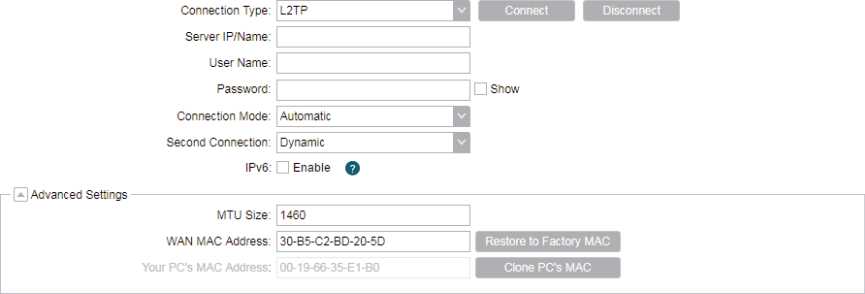
Specify the parameters below and click Connect:
Server IP/Name Enter the server IP address or the domain name provided by your ISP.
Enter the User Name provided by your ISP. This field is case-sensitive.
User Name
Password
Connection
Mode
Enter the Password provided by your ISP. This field is case-sensitive.
Select the Connection Mode.
• On Demand
 Configure the device to disconnect your internet connection after a specified period of inactivity (Idle Time). If your internet connection has been terminated due to inactivity, Connection on Demand enables the device to automatically re-establish your connection when you attempt to access the internet again. The default Idle Time is 15 minutes. If your internet connection is expected to remain active all the time, enter 0 in the Idle Time field. If you pay by time for your internet access, choose this mode to save your internet-access fee.
Configure the device to disconnect your internet connection after a specified period of inactivity (Idle Time). If your internet connection has been terminated due to inactivity, Connection on Demand enables the device to automatically re-establish your connection when you attempt to access the internet again. The default Idle Time is 15 minutes. If your internet connection is expected to remain active all the time, enter 0 in the Idle Time field. If you pay by time for your internet access, choose this mode to save your internet-access fee.
Connect automatically after the device is disconnected. If you are charged a flat monthly fee, choose this mode.
Configure the device to make it connect or disconnect manually. After a specified period of inactivity (Idle Time), the device will disconnect your internet connection, and you must click Connect manually to access the internet again. If your internet connection is expected to remain active all the times, enter 0 in the Idle Time field. Otherwise, enter the desired Idle Time in minutes you wish to use. If you pay by time for your internet access, choose this mode to save your internetaccess fee.
Connection Mode: Manual Q
Idle Time: 15 | minutes
Second
Connection
If your ISP provides a Connection type such as Dynamic/Static IP to connect to a local area network, activate this secondary connection.
Dynamic IP: Use dynamic IP address to connect to the local area network provided by ISP.
Static IP: Use static IP address to connect to the local area network provided by ISP.
IPv6 Enable or disable the IPv6 function. If the IPv6 function is enabled, the
device will obtain a WAN IPv6 address. Select a method for the device to obtain the WAN IPv6 address according to the information provided by your ISP.
• Static
Select static and enter the WAN IPv6 address, IPv6 netmask, IPv6 gateway, primary DNS and secondary DNS provided by your ISP.
IPv6. 0 Enable @ IPv6 Address: ® Static O SLAAC ODHCPv6 @
IPv6 Address
IPv6 Netmask- [64
Secondary DNS:
• SLAAC
Select SLAAC and the device will obtain the WAN IPv6 address automatically.
I
IPv6: 0 Enable 0
IPv6 Address: Q Static (• SLAAC O DHCPv6 Q
• DHCPv6
Select DHCPv6 and the device will obtain the WAN IPv6 address automatically.
I
IPv6: 0 Enable 0
IPv6 Address: O Static O SLAAC (g) DHCPv6 Q
| MTU Size | Specify the MTU size. The normal MTU (Maximum Transmission Unit) value for most Ethernet networks is 1500 Bytes. For some ISPs you need to modify the MTU. But this is rarely required, and should not be done unless you are sure it is necessary for your ISP connection. This number should be an integer between 576 and 2026. |
| WAN MAC
Address |
Specify the WAN MAC address. This field displays the current MAC address of the WAN port. If your ISP requires that you register the MAC address, enter the correct MAC address into this field. The format for the MAC Address is XX-XX-XX-XX-XX-XX (X is any hexadecimal digit). Click Restore Factory MAC to restore the MAC address of WAN port to the factory default value. |
| Your PC’s MAC Address | Displays the MAC address of the PC that is managing the device. Some ISPs require that you should register the MAC address of your PC. If the MAC address is required, click Clone PC’s MAC to set the WAN MAC address the same as your management PC’s MAC. |
3. Click Apply, then click Save.
LAN submenu is used to configure the LAN parameters for the device and the clients.
Access Point/Client/Repeater/Bridge Mode
Go to the Network page. In the LAN section, configure the following parameters.

Follow the steps below to configure the LAN parameters:
- Select the connection type according to your need. The device supports two types: Static and Dynamic.
■ Static
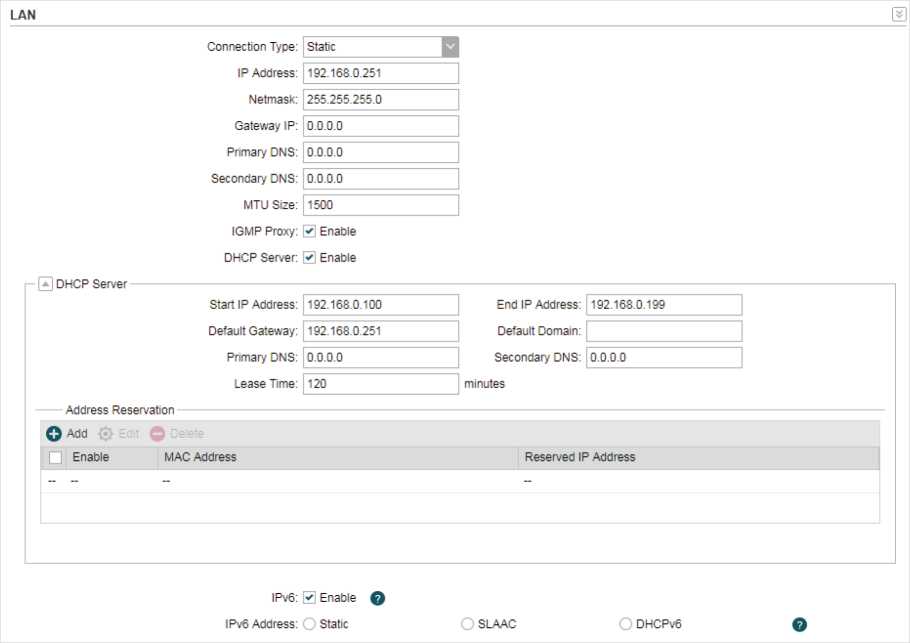
| IP address | Enter the LAN IP address of your device. By default, it is 192.168.0.254.
Note: When you change the LAN IP address in the Network tab, you should log in with the new IP address and save the settings for the configuration change to take effect. Otherwise the configuration will be lost after the reboot. |
| Netmask | Enter the Netmask provided by your ISP. Normally use 255.255.255.0. |
| Gateway IP | Enter the gateway IP address for your device. |
| Primary DNS | Enter the primary DNS IP address provided by your ISP. Consult your ISP if you don’t know the DNS value. The factory default setting is 0.0.0.0, which means no primary DNS is assigned. |
| Secondary DNS | Enter the secondary DNS IP address of alternative DNS server if your ISP has two DNS servers. The factory default setting is 0.0.0.0, which means no secondary DNS is assigned. |
| MTU Size | Specify the MTU size. The normal MTU (Maximum Transmission Unit) value for most Ethernet networks is 1500 Bytes. For some ISPs you need to modify the MTU. But this is rarely required, and should not be done unless you are sure it is necessary for your ISP connection. This number should be an integer between 576 and 2026. |
| IGMP Proxy | Enable or disable IGMP (Internet Group Management Protocol) Proxy. IGMP proxy is used to process the multicast stream in the netwok. It normally works for IPTV service. |
| DHCP Server | Enable or disable the DHCP server function. With this function enabled, the build-in DHCP server will assign IP address to the clients connected to the device. |
| Start IP Address | Specify the first IP address of the IP address pool. By default, it is 192.168.0.100. |
| End IP Address | Specify the last IP address of the IP address pool. By default, it is 192.168.0.199. |
| Default
Gateway |
Specify the gateway IP address for the LAN network. By default, it is 192.168.0.254. |
| Default Domain | (Optional) Specify the domain name for the DHCP server. |
| Primary DNS | Enter the DNS IP address for the LAN. By default, it is 0.0.0.0, which means no primary DNS is assigned. |
Secondary DNS Enter the IP address of alternative DNS server if there are two DNS servers. By default, it is 0.0.0.0, which means no secondary DNS is assigned.
Lease Time
Enter the amount time of the leased IP address assigned by the DHCP server. When the time expires, the clients will request to renew the lease automatically.
Address
Reservation
Enable Address Reservation and specify a reserved IP address for a PC on the local area network, so the PC will always obtain the same IP address each time when it starts up. Reserved IP addresses could be assigned to servers that require permanent IP settings.

To configure Address Reservation:
Click Add, specify the MAC address and the IP address. Enable this entry, then click Save.
IPv6
Enable or disable the IPv6 function. If the IPv6 function is enabled, the device will obtain a LAN IPv6 address. Select a method for the device to obtain the LAN IPv6 address according to the information provided by your ISP.
Select static and enter the LAN IPv6 address and IPv6 netmask.
IPv6: 0 Enable 0
IPv6 Address: • Static O SLAAC O DHCPv6 Q
IPv6 Address.
IPv6 Netmask: 64
Select SLAAC and the device will obtain the LAN IPv6 address automatically.
I
IPv6: 0 Enable 0
IPv6 Address: O Static <g> SLAAC O DHCPv6 0
• DHCPv6
Select DHCPv6 and the device will obtain the LAN IPv6 address automatically.
I
IPv6: 0 Enable e
IPv6 Address: Q Static O SLAAC (g) DHCPv6 0
■ Dynamic
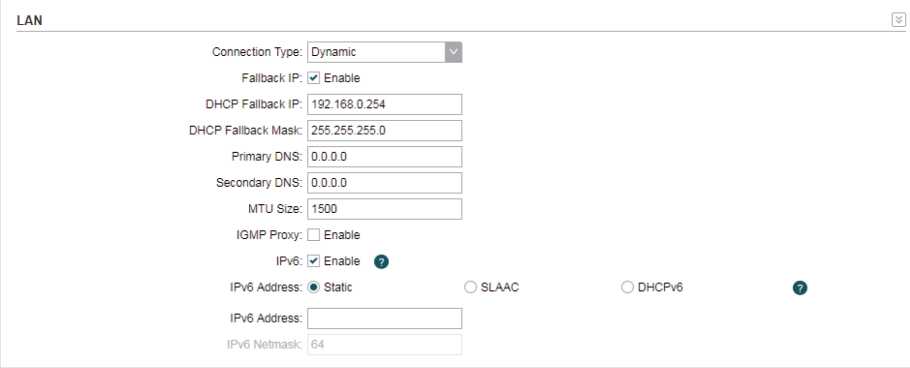
| Fallback IP | Enable or disable the Fallback IP. When the device fails to find the DHCP server, it will use the fallback IP as the LAN IP address. |
| DHCP Fallback IP | Specify the fallback IP for the device. By default, it is 192.168.0.254. |
| DHCP Fallback
Mask |
Specify the fallback netmask for the device. |
| Primary DNS | Enter the DNS IP address for the LAN. By default, it is 0.0.0.0, which means no primary DNS is assigned. |
| Secondary DNS | Enter the IP address of alternative DNS server if there are two DNS servers. By default, it is 0.0.0.0, which means no secondary DNS is assigned. |
| MTU Size | Specify the MTU size. The normal MTU (Maximum Transmission Unit) value for most Ethernet networks is 1500 Bytes. For some ISPs you need to modify the MTU. But this is rarely required, and should not be done unless you are sure it is necessary for your ISP connection. This number should be an integer between 576 and 2026. |
| IGMP Proxy | Enable or disable IGMP (Internet Group Management Protocol) Proxy. IGMP proxy is used to process the multicast stream in the network. It normally works for IPTV service. |
IPv6
Enable or disable the IPv6 function. If the IPv6 function is enabled, the device will obtain a LAN IPv6 address. Select a method for the device to obtain the LAN IPv6 address according to the information provided by your ISP.
Select static and enter the LAN IPv6 address and IPv6 netmask.
IPv6: 0 Enable 0
IPv6 Address: • Static O SLAAC O DHCPv6 0
IPv6 Address.
IPv6 Netmask. 64
Select SLAAC and the device will obtain the LAN IPv6 address automatically.
I
IPv6: 0 Enable 0
IPv6 Address: Q Static (• SLAAC O DHCPv6 0
• DHCPv6
Select DHCPv6 and the device will obtain the LAN IPv6 address automatically.
I
IPv6: 0 Enable 0
IPv6 Address: O Static O SLAAC (g) DHCPv6 0
AP Router/AP Client Router Mode
Go to the Network page. In the LAN section, configure the following parameters.
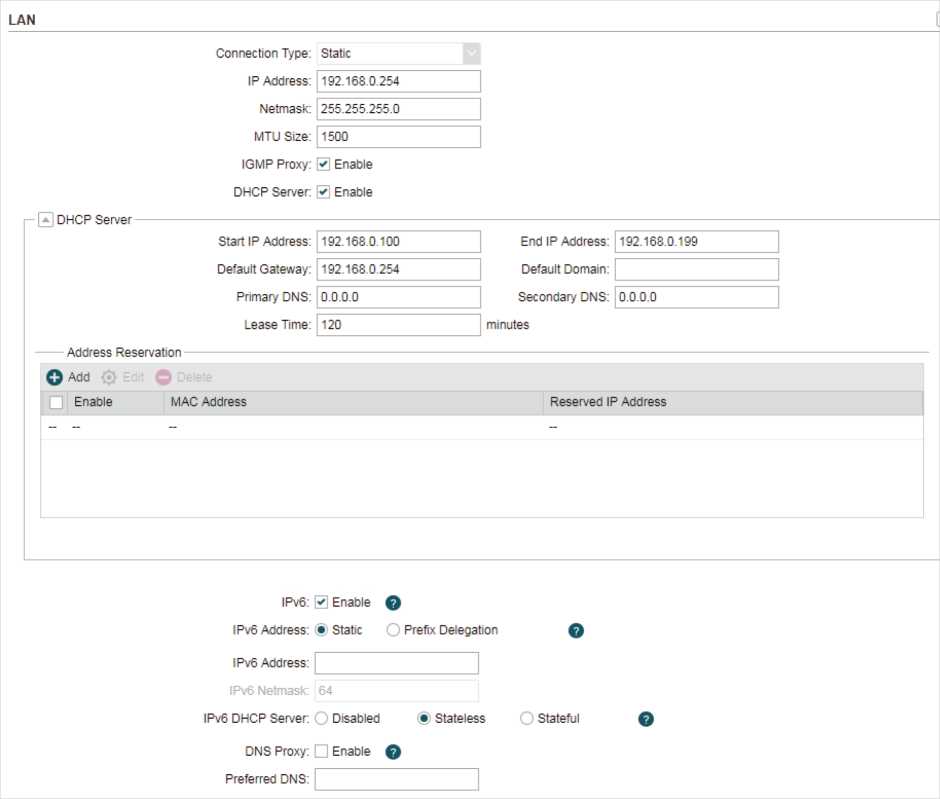
1. For LAN connection type, the device only supports Static.
| IP address | Enter the LAN IP address of your device. By default, it is 192.168.0.254.
Note: When you change the LAN IP address in the Network tab, you should log in with the new IP address and save the settings for the configuration change to take effect. Otherwise the configuration will be lost after the reboot. |
| Netmask | Enter the Netmask provided by your ISP. Normally use 255.255.255.0. |
| MTU Size | Specify the MTU size. The normal MTU (Maximum Transmission Unit) value for most Ethernet networks is 1500 Bytes. For some ISPs you need to modify the MTU. But this is rarely required, and should not be done unless you are sure it is necessary for your ISP connection. This number should be an integer between 576 and 2026. |
| IGMP Proxy | Enable or disable IGMP (Internet Group Management Protocol) Proxy. IGMP proxy is used to process the multicast stream in the netwok. It normally works for IPTV service. |
| DHCP Server | Enable or disable the DHCP server function. With this function enabled, the build-in DHCP server will assign IP address to the clients connected to the device. |
Specify the first IP address of the IP address pool. By default, it is 192.168.0.100.
Start IP Address
End IP Address
Default
Gateway
Default Domain
Primary DNS
Secondary DNS
Lease Time
Address Reservation
Specify the last IP address of the IP address pool. By default, it is 192.168.0.199.
Specify the gateway IP address for the LAN network. By default, it is 192.168.0.254.
(Optional) Specify the domain name for the DHCP server.
Enter the DNS IP address for the LAN. By default, it is 0.0.0.0, which means no primary DNS is assigned.
Enter the IP address of alternative DNS server if there are two DNS servers. By default, it is 0.0.0.0, which means no secondary DNS is assigned.
Enter the amount time of the leased IP address assigned by the DHCP server. When the time expires, the clients will request to renew the lease automatically.
 Enable Address Reservation and specify a reserved IP address for a PC on the local area network, so the PC will always obtain the same IP address each time when it starts up. Reserved IP addresses could be assigned to servers that require permanent IP settings.
Enable Address Reservation and specify a reserved IP address for a PC on the local area network, so the PC will always obtain the same IP address each time when it starts up. Reserved IP addresses could be assigned to servers that require permanent IP settings.
To configure Address Reservation:
Click Add, specify the MAC address and the IP address. Enable this entry, then click Save.
Enable or disable the IPv6 function. If the IPv6 function is enabled, the device will obtain a LAN IPv6 address. Select a method for the device to obtain the LAN IPv6 address according to the information provided by your ISP.
IPv6
• Static
Select static and enter the LAN IPv6 address and IPv6 netmask.
IPv6: 0 Enable
IPv6 Address: <g) Static O Prefix Delegation o
IPv6 Address: | |
IPv6 Netmask: 164 |
• Prefix Delegation
Select Prefix Delegation and the device will obtain the LAN IPv6 address automatically.
IPv6: [Z Enable Q
IPv6 Address: C Static (• Prefix Delegation Q
IPv6 DHCP Enable or disable the IPv6 DHCP server function. With IPv6 DHCP server Server enabled, the clients will obtain the IPv6 address from the DHCP server.
Select Disabled to disable the IPv6 DHCP server function
IPv6 DHCP Server: (§: Disabled (‘ Stateless O Stateful Q
Select Stateless or Stateful, and the clients will obtain the IPv6 address from the IPv6 DHCP server automatically. Enable or disable the DNS proxy. With this feature enabled, the device will obtain the DNS server automatically. With this feature disabled, you should specify the DNS address manually.
IPv6 DHCP Server: O Disabled © Stateless O Stateful 0
I
ONS Proxy: □ Enable 0
Preferred DNS: | |
Management VLAN provides a safer way for you to manage the device. With Management VLAN enabled, only the hosts in the management VLAN can manage the device. Since most hosts cannot process VLAN tags, connect the management host to the network via a switch, and set up correct VLAN settings to ensure the communication between the host and the device in the management VLAN.
Go to the Network page. In the Management VLAN Interfaces section, enable the Management VLAN function, specify VLAN ID and click Apply. Then click Save.

Management Enable or disable the Management VLAN function. By default, it is disabled. VLAN
VLAN ID Specify the Management VLAN ID. The valid values are from 2 to 4094.
Note:
Forwarding submenu is only available in AP Router Mode and AP Client Router (WISP Client) Mode.
The IP address used on the internet is public IP address, while IP address used on local area network is private IP address. The hosts using private IP addresses cannot access the internet directly and vice versa.
The hosts using private IP addresses visit internet through NAT (Network Address Translation) technology. NAT can transfer private IP addresses into public IP addresses to realize the communication from internal hosts to external hosts.
If the hosts on the internet want to visit the hosts on local area network, the forwarding function should be used, including DMZ, Virtual server, Port triggering and UPnP.
Go to the Network page. In the Forwarding section, configure the following parameters and click Apply. Then click Save.
Forwarding
DMZ: 0 Enable Q
DMZ IP: 10.0.0.0 |
ALG: 0 FTP ALG 0 TFTP ALG 0 H323 ALG 0 RTSP ALG 0 Virtual Server: □ Enable 0
Port Trigger: □ Enable
UPnP: □ Enable 0
| DMZ | Enable or disable the DMZ function. DMZ (Demilitarized Zone) specifically allows one computer/device behind NAT to become “demilitarized”, so all packets from the external network are forwarded to this computer/device. The demilitarized host is exposed to the wide area network, which can realize the unlimited bidirectional communication between internal hosts and external hosts. |
| DMZ IP | Specify the IP address of the local host network device. The DMZ host device will be completely exposed to the external network. Any PC that was used for a DMZ must have a static or reserved IP Address because its IP Address may change when using the DHCP function. |
| ALG | Select the type of ALG to enable the corresponding feature. Common NAT only translates the address of packets at network layer and the port number at transport layer but cannot deal with the packets with embedded source/destination information in the application layer. Application layer gateway (ALG) can deal with protocols with embedded source/destination information in the application payload. Some protocols such as FTP, TFTP, H323 and RTSP require ALG (Application Layer Gateway) support to pass through NAT.
FTP ALG: Allows FTP clients and servers to transfer data across NAT. TFTP ALG: Allows TFTP clients and servers to transfer data across NAT. H323 ALG: Allows Microsoft NetMeeting clients to communicate across NAT. RTSP ALG: Allows some media player clients to communicate with some streaming media servers across NAT. |
Enable or disable Virtual Server. Virtual servers can be used for setting up public services on your local area network, such as DNS, Email and FTP. A virtual server is defined as a service port, and all requests from the internet to this service port will be redirected to the LAN server. Virtual Server function not only makes the users from internet visit the local area network, but also keeps network security within the intranet as other services are still invisible from internet. The LAN server must have a static or reserved IP Address because its IP Address may change when using the DHCP function.
Virtual Server

To configure Virtual Server:
Click Add, specify the following parameters and Enable the entry. Click Save.
IP: Enter the IP Address of the PC providing the service application.
Internal Port: Enter the Internal Port number of the PC running the service application. You can leave it blank if the Internal Port is the same as the Service Port, or enter a specific port number.
Service Port: Enter the numbers of external Service Port. You can type a service port or a range of service ports (the format is XXX – YYY, XXX is the start port, YYY is the end port). Internet users send request to the port for services.
Protocol: Choose the one of the protocols used for this application: TCP, UDP, or TCP/UDP.
Enable or disable port trigger. Due to the existence of the firewall, some applications such as online games, video conferences, VoIPs and P2P downloads need the device to configure the forwarding to work properly, and these applications require multiple ports connection, for single-port virtual server cannot meet the demand. Port trigger function comes at this time. When an application initiates a connection to the trigger port, all the incoming ports will open for subsequent connections.
Port Trigger

To configure port trigger:
Click Add, specify the following parameters and Enable the entry. Click Save.
Incoming Port: Enter the incoming port for incoming traffic. The port or port range is used by the remote system when it responds to the outgoing request. A response to one of these ports will be forwarded to the PC that triggered this rule. You can input at most 5 groups of ports (or port section). Every group of ports must be set apart with “,”. For example, 2000-2038, 2050-2051,2085, 3010-3030.
Trigger Port: Enter the trigger port for outgoing traffic. An outgoing connection using this port will “Trigger” this rule.
Protocol: Choose the one of the protocols used for this application: TCP, UDP, or TCP/UDP.
Enable or disable UPnP. If you use applications such as multiplayer gaming, peer-to-peer connections, or real-time communications such as instant messaging or remote assistance (a feature in Windows XP), you should enable the UPnP function. The Universal Plug and Play (UPnP) function allows the devices, such as internet computers, to access the local host resources or devices as needed. Host in the local area network can automatically open the corresponding ports on a router, and make the application of external host access the resources of the internal host through the opened ports. Therefore, the functions limited to the NAT can work properly. Compared to virtual server and port triggering, the application of UPnP doesn’t need manual settings. It is more convenient for some applications required unfixed ports.
UPnP

App Description: Displays the description provided by the application in the UPnP request.
External Port: Displays the external port number that the router opened for the service application.
Internal Port: Displays the internal service port number of the local host running the service application.
Protocol: Displays which type of protocol is opened.
IP Address: Displays the IP address of the local host which initiates the UPnP request.
Status: Enabled means that port is still active. Otherwise, the port is inactive.
Note:
Security submenu is only available in AP Router Mode and AP Client Router (WISP Client) Mode.
Stateful Packet Inspection (SPI) is a firewall that keeps track of the state of network connections (such as TCP streams, UDP communication) traveling across it. The firewall is programmed to distinguish legitimate packets for different types of connections. Only packets matching a known active connection will be allowed to pass through by the firewall and others will be rejected. SPI Firewall is enabled by factory default.
- Go to the Network page. In the Security > Basic section, configure the following parameters and click Apply.

| SPI Firewall | Check the Enable box to use the SPI Firewall function. If forwarding rules are enabled at the same time, the device will give priority to meet forwarding rules. |
| Ping | Select and enable the ping forbidden function.
WAN Ping Forbidden: Enable or disable this function. With this option enabled, the device will not reply the ping request originates from internet. By default, it is disabled. LAN Ping Forbidden: Enable or disable this function. With this option enabled, the device will not reply the ping request originates from local network. |
| VPN | Select and enable the VPN function.
A VPN is created by establishing a virtual point-to-point connection through the use of dedicated connections, virtual tunneling protocols, or traffic encryptions. Through VPN you can access your private network over internet. A virtual private network connection across the internet is similar to a wide area network (WAN) link between sites. From a user perspective, the extended network resources are accessed in the same way as resources available within the private network. When hosts in the local area network want to visit the remote virtual private network using virtual tunneling protocols, the corresponding VPN protocol should be enabled. PPTP Passthrough: PPTP (Point-to-Point Tunneling Protocol) allows the Point-to-Point Protocol (PPP) to be tunneled through an IP (Internet Protocol) network. Check the box to allow PPTP tunnels to pass through the Device. L2TP Passthrough: L2TP (Layer Two Tunneling Protocol) is the method used to enable Point-to-Point connections via the internet on the Layer Two level. Check the box to allow L2TP tunnels to pass through the Device. IPSec Passthrough: IPSec (Internet Protocol Security) is a suite of protocols for ensuring private, secure communications over IP (Internet Protocol) networks, through the use of cryptographic security services. Check the box to allow IPSec tunnels to pass through the Device. |
2. In the Security > Advanced Settings section, configure the following parameters and click Apply.

DoS Protection Enable the DoS Protection and specify the parameters.
DoS (Denial of Service) Attack is to occupy the network bandwidth maliciously by the network attackers or the evil programs sending a lot of service requests to the Host, which incurs an abnormal service or even breakdown of the network. With DoS Protection function enabled, the device can analyze the specific fields of the IP packets and distinguish the malicious DoS attack packets. Upon detecting the packets, the device will discard the illegal packets directly and limit the transmission rate of the legal packets if the over legal packets may incur a breakdown of the network. The hosts sending these packets will be added into the Blocked DoS Host List. The device can defend a few types of DoS attack such as ICMP_FLOOD, UDP_FLOOD and TCP_SYN_ FLOOD.
Packets Statistics Interval: Select a value between 5 and 60 seconds from the drop-down list. The default value is 10. The value indicates the time interval of the packets statistics. The result of the statistic is used for analysis by ICMP-Flood, UDP Flood and TCP-SYN Flood.
ICMP_FLOOD Attack Filter: Enter a value between 5 and 3600. The default value is 50. When the current ICMP-FLOOD Packets number is beyond the set value, the device will start up the blocking function immediately.
UDP_FLOOD Attack Filter: Enter a value between 5 and 3600. The default value is 500. When the current UPD-FLOOD Packets number is beyond the set value, the device will start up the blocking function immediately.
TCP_SYN_FLOOD Attack Filter: Enter a value between 5 and 3600. The default value is 50. When the current TCP-SYN-FLOOD Packets numbers is beyond the set value, the Device will start up the blocking function immediately.

Blocked DoS
Host List
Click Blocked DoS Host List to display the blocked DoS host table including host IP and host MAC. Click Refresh to renewal the table list. Click Clear to release all the blocked hosts. If you want to release one or some of the blocked hosts, select them and Click Unlock.
Note:
Access Control submenu is only available in AP Router Mode and AP Client Router (WISP Client) Mode.
The function can be used to control the internet activities of hosts in the local area network. For example, the online time limit and the specified web stations to visit can be controlled by the filtering policy.
- Go to the Network page. In the Access Control section, enable Access Control and select the Filtering Policy.

| Access Control | Enable or disable Access Control. |
| Filtering Policy | Select the filtering policy according to your need.
Allow the packets specified by any enabled access control policy to pass through the Device: The hosts listed below are allowed to access the internet under the rules. While others are forbidden to access. Deny the packets specified by any enabled access control policy to pass through the Device: The hosts listed below are forbidden to access the internet under the rules. While others are allowed to access. |
2. Click Add and create the filtering entries.

| Enable | Enable or disable the desired entry. |
| Protocol | Choose one of the protocols from the drop-down list used for the target, any of IP, TCP, UDP, or ICMP. |
| Host IP | Enter the IP address or address range of the hosts that you need to control, for example 192.168.0.12-192.168.0.25. |
| Target IP | Enter the IP address or address range of the targets that you need to control, for example 192.168.3.12-192.168.3.25. |
| Target Port | Specify the port or port range for the target when protocol is TCP or UDP. |
| Days of a week | Specify the days in which the rules take effect. |
| Time | Enter the time rule in HH:MM-HH:MM format, the default value is 00:0024:00. |
3. Click Save and click Apply, then click Save.
Note:
Static Routing submenu is only available in AP Router Mode and AP Client Router (WISP Client) Mode.
A static route is a pre-determined path that network information must travel to reach a specific host or network. If static route is used properly in the network, it can decrease the network overhead and improve the speed of forwarding packets.
Static routing is generally suitable for simple network environment, in which users clearly understand the topology of the network so as to set the routing information correctly. When the network topology is complicated and users are not so familiar with the topology structure, this function should be used with caution or under the guidance of the experienced administrator.
- Go to the Network page. In the Static Routing section, click Add and specify the following parameters.

| Enable | Enable or disable the desired entry. |
| Target Network IP | Enter the Target Network IP, the address of the network or host to be visited. The IP address cannot be on the same network segment with the device’s WAN or LAN port. |
| Netmask | Specify the netmask for the desired entry. |
| Gateway IP | Enter the Gateway IP, the address of the gateway that allows for contact between the Device and the network or host |
Note:
Bandwidth Control submenu is only available in AP Router Mode and AP Client Router (WISP Client) Mode.
Bandwidth control function is used to control the internet bandwidth in the local area network. In the case of insufficient bandwidth resources, enable the function to make the device allocate reasonable bandwidth to the clients and achieve the purpose of efficient use of the existing bandwidth. Via IP bandwidth control function, set the upper and lower limit in the bandwidth of the computer network and guarantee a smooth sharing network.

Total Ingress Specify the upper bandwidth for receiving packets from the WAN port.
Bandwidth
The maximum value is 100,000kbps.
Total Egress Specify the upper bandwidth for sending packets from the WAN port.
Bandwidth
The maximum value is 100,000kbps.

2. Click Add and specify the following parameters.
| Enable | Enable or disable the desired entry. |
| IP Range | Enter the IP Range of the target hosts which need to be controlled of bandwidth, for example 192.168.0.12-192.168.0.25. |
| Port Range | Enter the Port Range through which the target hosts visit external server, for example 1-63258. |
| Protocol | Choose one of the protocols used for this application: TCP, UDP, or TCP/ UDP. |
| Ingress Min (kbps) | Specify the minimum ingress bandwidth for the desired entry. |
| Ingress Max (kbps) | Specify the maximum ingress bandwidth for the desired entry. |
| Egress Min (kbps) | Specify the minimum egress bandwidth for the desired entry. |
Egress Max Specify the maximum egress bandwidth for the desired entry. (kbps)
We can effectively prevent ARP attack and IP embezzlement by enabling the IP&MAC binding. Within the local network, the device transmits IP packets to the certain target identified by the MAC address. Therefore, the IP and MAC address should be one-to- one correspondence and their corresponding relations are maintained by the ARP table. ARP attack can use forged information to renewal the ARP table, and destroy the corresponding relations between IP and MAC addresses, which would prevent the communication between the device and the corresponding host. When the IP&MAC Binding function is enabled, the IP and MAC relations in the ARP table won’t be expired and renewed automatically, which effectively prevents the ARP attack.
Some functions such as access control and bandwidth control, are based on the IP addresses to identify the access clients. The network administrator can allocate every client a static IP, according to which he makes the access and bandwidth rules to control the clients’ online behavior and the bandwidth they’ve used. Some illegal users may change the IP address in order to get higher internet access. Enabling IP & MAC binding function can effectively prevent the IP embezzlement.
Note:
After IP & MAC binding function is enabled, the IP bound to the MAC cannot be used by other MACs. However this MAC can use other IPs within the same segment, which are not bounded by other MACs, to access the network.
1. Go to the Network page. In the IP & MAC Binding section, click Add and specify the IP address and MAC address.
Note:
Click Import to quick import the entries in ARP table to IP & MAC Binding table. The imported entries are disabled by default. Select the desired entries and click Edit to enable it.

IP
Enter the IP address that you want to bind with the MAC address.
MAC Enter the MAC address that you want to bind with the IP address.
Configure the Wireless Parameters
This chapter introduces how to configure the parameters of the wireless network, including:
- Configure Basic Wireless Parameters
- Configure Wireless Client Parameters
- Configure Wireless AP Parameters
- Configure Multi-SSID
- Configure Wireless MAC Filtering
- Configure Advanced Wireless Parameters
- Configure Basic Wireless Parameters
This section allows you to configure wireless basic parameters, such as 802.11 mode, Transmit Power, and data rates.
Go to the Wireless Page. In the Basic Wireless Settings section, configure the basic wireless settings and click Apply. Then click Save.

| Region | Specify the region where you use the device. Available channels and maximum Transmit Power will be determined by the selected region according to the local laws and regulations. |
| Mode | Select the protocol standard used in the wireless network. To check what protocol standards your device supports, refer to the actual web interface.
Certain devices have a frequency band of 2.4GHz, supporting 802.11b, 802.11g, 802.11n, 802.11b/g, and 802.11b/g/n modes. We recommend that you set the mode as 802.11b/g/n, allowing all 802.11b, 802.11g and 802.11n wireless stations to access the device. Certain devices have a frequency band of 5GHz, supporting 802.11a, 802.11n, and 802.11a/n modes. We recommend that you set the mode as 802.11a/n, allowing both 802.11a and 802.11n wireless stations to access the device. Certain devices have a frequency band of 5GHz, supporting 802.11ac, 802.11n/ac, and 802.11a/n/ac modes. We recommend that you set the mode as 802.11a/n/ac, allowing all 802.11a, 802.11n, and 802.11ac wireless stations to access the device. |
| Channel Width | Select the channel width of this device. To check what channel width your device supports, refer to the actual web interface.
For certain devices, options include 5 MHz, 10 MHz, 20 MHz, 40 MHz and 20/40 MHz (the device automatically selects 40 MHz, and 20 MHz will be used if 40 MHz is not available). For certain devices, options include 20 MHz, 40 MHz, 80 MHz and 20/40/80 MHz (the device automatically selects 80 MHz, and 40 MHz will be used if 80 MHz is not available, and so on). According to IEEE 802.11n standard, using a wider channel can increase wireless throughput. However, you may need to choose lower bandwidth due to the following reasons:
|
| Max TX Rate | Set the maximum transmit data rate. |
| Channel/ Frequency | Select appropriate channel used by this device to improve wireless performance. 1/2412 MHz refers to Channel 1 and the frequency is 2412 MHz. This setting is only available in Access Point Mode and AP Router Mode. We highly recommend that you use the Spectrum Analysis tool to select a proper channel. |
| Antenna | Select your antenna from the list. |
| Antenna Gain | Antenna Gain is only available in WBS products. Enter the antenna gain value according to the antennas and the value ranges from 0 to 30dBi. It can work together with the transmit power to improve the transmit signal quality.
Channel/Frequency: Auto O Antenna Gain: 0 (0-30)dBi |
| EIRP Limit | This option should remain enabled. With EIRP Limit enabled, the transmit power is restricted so that the EIRP (Effecitive Isotropic Radiated Power) of the device is kept below the amount which is allowed in the selected region. |
| Channel
Shifting |
Note:
Channel Shifting is only available on certain devices. To check whether your device supports this feature, refer to the actual web interface. Enable or disable the Channel Shifting function. This function is only available when MAXtream is enabled in Access Point Mode and AP Router Mode. Channel Shifting is a TP-Link proprietary technology. With Channel Shifting enabled, the AP will use non-standard channels by adding a frequency offset to the standard 802.11 b/g/n channels. Your network can then only be detected by the wireless devices with Channel Shifting enabled and so is less likely to be detected by other wireless networks, which benefits network security. |
| Transmit Power | Note:
In most scenarios, it is unnecessary to select the maximum transmit power. Selecting larger transmit power than your need may cause interference to neighborhood. Also it consumes more power and will reduce longevity of the device. Select appropriate transmit power to achieve the best performance. Use the Speed Test tool to find the best performance. Specify the transmit power of the device. Use the slider or manually enter the transmit power value. For Outdoor Wireless Base Stations, the maximum transmit power varies according to the antenna gain value. |
| MAXtream | Note:
Enable or disable the MAXtream function. This function is only available in Access Point Mode and AP Router Mode. MAXtream is a TP-Link proprietary technology. It is based on TDMA (Time Division Multiple Access) so that data streams are transmitted in their own time slots. MAXtream aims to maximize throughput and minimize latency. “Hidden nodes” problem can also be eliminated with MAXtream enabled. |
| MAXtream
Station Mode |
Note:
MAXtream is only available on certain devices. To check whether your device supports this feature, refer to the actual web interface. MAXtream Station Mode is available in Client Mode, Bridge Mode and AP Client Router Mode with the wireless AP settings disabled. Auto Adjust: The device will choose the MAXtream Station Mode automatically. Latency First: Set the MAXtream Station Mode as Latency First and the time sensitive stream such as VoIP will take precedence in MAXtream system. Throughput First: Set the MAXtream Station Mode as Throughput First and the stream that needs high throughput such as online games will take precedence in MAXtream system. |
Note:
Wireless Client Settings submenu is only available in Client, Repeater, Bridge and AP Client Router (WISP Client) Mode.
In this section, configure wireless client parameters used for the connection with the root AP.

1. Go to the Wireless Page. In the Wireless Client Settings section, configure the following parameters.
| SSID of AP | Specify the SSID of the root AP. You can enter the SSID of the specific AP manually, or directly survey all the APs around by clicking Survey and select one. |
| MAC of AP | Displays the MAC address of the root AP. It’s possible that two or more networks use the same SSID in the AP list. Enable Lock to AP to select SSID and AP simultaneously, which can make the device connect to the specific AP you had connected before the next time. |
| WDS | Displays the status of the WDS (Wireless distribution System) function. WDS is a communication system among multiple wireless networks . It is established between APs through wireless connection. WDS is used to during the connection between the device and the root AP.
Enable: Forward data frames to use four address fields. Disable: Forward data frames to use three address fields. Auto: The device automatically negotiates the wireless data frame structure (three or four address fields) with the root AP. The selection of Auto is recommended. |
- Specify the security mode. Make sure the security mode and the related parameters are the same as the upstream wireless network’s.
■ None
Select this option if the root AP has no encryption. When connecting to the root AP, it’s no need to enter a password to access the wireless network.
■ WEP
Note:
- WEP is only available on certain devices. To check whether your device supports this feature, refer to the actual web interface.
- WEP is not supported in 802.11n mode or 802.11ac mode. If WEP is applied in 802.11n, 802.11 ac or 802.11n/ac mixed mode, the clients may not be able to access the wireless network. If WEP is applied in 802.11b/g/n mode (2.4GHz) or 802.11a/n (5GHz), the device may work at a low transmission rate.

 WEP (Wired Equivalent Privacy) is a traditional encryption method. It has been proved that WEP has security flaws and can easily be cracked, so WEP is rarely used in normal wireless network. Select this option if the security mode of the root AP is WEP.
WEP (Wired Equivalent Privacy) is a traditional encryption method. It has been proved that WEP has security flaws and can easily be cracked, so WEP is rarely used in normal wireless network. Select this option if the security mode of the root AP is WEP.
Key Selected:
Key 1: tS)
Key 2:
Key 3:
Key 4:
Key Type
Disaolec
Disaolec
Disaolec
Disaolec
| Auth Type | Select the authentication type for WEP.
Auto: The device can select Open System or Shared Key automatically according to the wireless network of the root AP. Open System: The device can pass the authentication and associate with the root wireless network without password. However, correct password is necessary for data transmission. Shared Key: The device needs the correct password to pass the authentication, otherwise the device cannot associate with the root wireless network or transmit data. |
| Key Format | Select ASCII or Hex as the WEP key format.
ASCII: With this format selected, the WEP key can be any combination of keyboard characters of the specified length. Hex: With this format selected, the WEP key can be any combination of hexadecimal digits (0-9, a-f, A-F) with the specified length. |
| Key Selected | Select one key to specify. You can configure four keys at most. |
| WEP Key | Enter the WEP keys. The length and valid characters are determined by the key format and key type. |
| Key Type | Select the WEP key length for encryption.
64Bit: Enter 10 hexadecimal digits or 5 ASCII characters. 128Bit: Enter 26 hexadecimal digits or 13 ASCII characters. 152Bit: Enter 32 hexadecimal digits or 16 ASCII characters. |
■ WPA
WPA (Wi-Fi Protected Access) is a safer encryption method compared with WEP and WAP- PSK. It requires a RADIUS server to authenticate the clients via 802.1X and EAP (Extensible Authentication Protocol). WPA can generate different passwords for different clients, which ensures higher network security. But it also costs more to maintain the network, so it is more suitable for business networks.
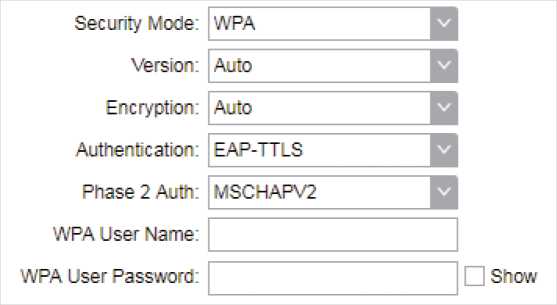
| Auto: The device will automatically choose the version used by the root AP.
WPA/WPA2: They’re two versions of WPA security mode. WPA2 is an update of WPA. Compared with WPA, WPA2 introduces AES algorithm and CCMP encryption. Theoretically, WPA2 is securer than WPA. |
|
| Encryption | Note:
TKIP is only available on certain devices. To check whether your device supports this feature, refer to the actual web interface. Select the Encryption type. Auto: The default setting is Auto and the device will select TKIP or AES automatically according to the wireless network of root AP. TKIP: Temporal Key Integrity Protocol. TKIP is not supported in 802.11n mode, 802.11ac mode or 802.11 n/ac mixed mode. If TKIP is applied in 802.11n, 802.11 ac or 802.11n/ac mixed mode, the device may not be able to access the root wireless network. If TKIP is applied in 11b/ g/n mode (2.4GHz) or 11a/n mode(5GHz), the device may work at a low transmission rate. AES: Advanced Encryption Standard. It is securer than TKIP. |
| Authentication | Select the type of the authentication. |
| Phase 2 Auth | Select the type of Phase 2 Auth. The device only supports MSCHAPV2 currently. |
| WPA User
Name |
Specify the WPA User Name used in the connection with the root AP. |
Version
Select the version of WPA.
| WPA User
Password |
Specify the WPA User Password used in the connection with the root AP. |
■ WPA-PSK
WPA-PSK (Wi-Fi Protected Access-PSK) is based on a pre-shared key. It is characterized by high safety and simple settings, so it is mostly used by common households and small businesses.
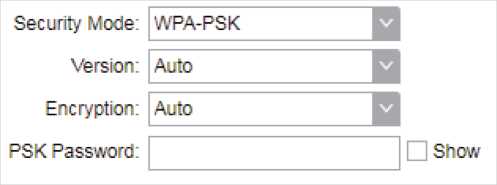
| WPA-PSK/WPA2-PSK is only available on certain devices. To check whether your device supports this feature, refer to the actual web interface.
Select the version of WPA-PSK. WPA-PSK/WPA2-PSK: They’re two versions of WPA-PSK security mode. WPA2-PSK is an update of WPA-PSK. Compared with WPA, Theoretically, WPA2 is securer than WPA. Auto: The device will automatically choose the version used by the root AP. WPA/WPA2: They’re two versions of WPA-PSK security mode normally called WPA-PSK/WPA2-PSK. WPA2-PSK is an update of WPA-PSK. Compared with WPA-PSK, theoretically, WPA2-PSK is securer than WPA-PSK. |
|
| Encryption | Note:
TKIP is only available on certain devices. To check whether your device supports this feature, refer to the actual web interface. Select the Encryption type. Auto: The default setting is Auto and the device will select TKIP or AES automatically according to the wireless network of root AP. TKIP: Temporal Key Integrity Protocol. TKIP is not supported in 802.11n mode, 802.11ac mode or 802.11 n/ac mixed mode. If TKIP is applied in 802.11n, 802.11 ac or 802.11n/ac mixed mode, the device may not be able to access the root wireless network. If TKIP is applied in 11b/ g/n mode (2.4GHz) or 11a/n mode(5GHz), the device may work at a low transmission rate. AES: Advanced Encryption Standard. It is securer than TKIP. |
| PSK Password | Specify the PSK password used in the connection with the root AP. |
Version
Note:
Note:
Wireless AP Settings submenu is only available in Access Point, Bridge, AP Router and AP Client Router (WISP Client) Mode.
In this section, configure wireless AP parameters used for the connection with the clients.

Enable SSID Enable or disable SSID broadcast. With this function enabled, the device Broadcast will broadcast the SSID periodically.
■ None
Select None when you want an open network without wireless security. In this mode, network data is not encrypted, but you can still authenticate clients by enabling the RADIUS MAC Authentication function.
Note:
RADIUS MAC Authentication is only available on certain devices. To check whether your device supports this feature, refer to the actual web interface.
RADIUS MAC Authentication 3 Enable Q
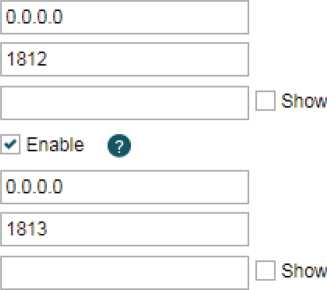
Authentication Server I3
Authent cation Server Pert
Authentication Server Key:
Accounting Server I3
.Accounting Server Port
Accounting Server Key
Accounting Server
| RADIUS MAC Authentication | Enable or disable the Radius MAC authentication. With this feature enabled, you can authenticate clients using their MAC addresses on your RADIUS authentication server.
Remember to log into your RADIUS authentication server and create authentication entries whose username and password are both the access-enabled clients’ MAC address (for MAC address 11-22-33-AA- BB-CC, create an authentication entry whose username and password are both 112233aabbcc on the RADIUS server). |
| Authentication
Server IP |
Enter the IP address of the RADIUS authentication server. |
| Authentication
Server Port |
Enter the UDP port of the RADIUS authentication server. The most commonly used port is the default, 1812, but this may vary depending on the RADIUS authentication server you are using. |
| Authentication
Server Key |
Enter the shared key used between this device and the authentication server. The shared key is a case-sensitive text string used to validate communication between this device and the RADIUS authentication server.
Check the Show box to view the shared key characters. |
| Accounting
Server |
Enable or disable Accounting Server. With this feature enabled, you can keep accounts on users using a RADIUS accounting server. |
| Accounting
Server IP |
Enter the IP address of the RADIUS accounting server. |
| Accounting
Server Port |
Enter the UDP port of the RADIUS accounting server. The most commonly used port is 1813, but this may vary depending on the RADIUS accounting server you are using. |
| Accounting
Server Key |
Enter the password used between this device and the RADIUS accounting server. The shared key is a case-sensitive text string used to validate communication between this device and the RADIUS accounting server.
Check the Show box to view the shared key characters. |
■ WEP
Note:
- WEP is only available on certain devices. To check whether your device supports this feature, refer to the actual web interface.
- WEP is not supported in 802.11n mode or 802.11ac mode. If WEP is applied in 802.11n, 802.11 ac or 802.11n/ac mixed mode, the clients may not be able to access the wireless network. If WEP is applied in 802.11b/g/n mode (2.4GHz) or 802.11a/n (5GHz), the device may work at a low transmission rate.

 WEP (Wired Equivalent Privacy) is a traditional encryption method. It has been proved that WEP has security flaws and can easily be cracked, so WEP cannot provide effective protection for wireless networks. Since WPA-PSK and WPA-Enterprise are much safer than WEP, we recommend that you choose WPA-PSK or WPA-Enterprise if your clients also support them.
WEP (Wired Equivalent Privacy) is a traditional encryption method. It has been proved that WEP has security flaws and can easily be cracked, so WEP cannot provide effective protection for wireless networks. Since WPA-PSK and WPA-Enterprise are much safer than WEP, we recommend that you choose WPA-PSK or WPA-Enterprise if your clients also support them.
Key Selected:
Key 1: tS)
Key 2:
Key 3:
Key 4:
Key Type
Disaolec
Disaolec
Disaolec
Disaolea
| Auth Type | Select the authentication type for WEP.
Auto: The device can select Open System or Shared Key automatically based on the wireless capability and request of the clients. Open System: Clients can pass the authentication and associate with the wireless network without password. However, correct password is necessary for data transmission. Shared Key: Clients have to input the correct password to pass the authentication, otherwise the clients cannot associate with the wireless network or transmit data. |
| Key Format | Select ASCII or Hex as the WEP key format.
ASCII: With this format selected, the WEP key can be any combination of keyboard characters of the specified length. Hex: With this format selected, the WEP key can be any combination of hexadecimal digits (0-9, a-f, A-F) with the specified length. |
| Key Selected | Select one key to specify. You can configure four keys at most. |
| WEP Key | Enter the WEP keys. The length and valid characters are determined by the key format and key type. |
| Key Type | Select the WEP key length for encryption.
64Bit: Enter 10 hexadecimal digits or 5 ASCII characters. 128Bit: Enter 26 hexadecimal digits or 13 ASCII characters. 152Bit: Enter 32 hexadecimal digits or 16 ASCII characters. |
■ WPA
WPA (Wi-Fi Protected Access) is a safer encryption method compared with WEP and WAP- PSK. It requires a RADIUS server to authenticate the clients via 802.1X and EAP (Extensible Authentication Protocol). WPA can generate different passwords for different clients, which ensures higher network security. But it also costs more to maintain the network, so it is more suitable for business networks.
1^”” Note:
Accounting Server is only available on certain devices. To check whether your device supports this feature, refer to the actual web interface.
Version
| Security Mode
Vtersion Encryption |
WPA | D D D | |
| Auto | |||
| Auto | |||
| Authentication Server IP | IJ 0 IJ 0 | ||
| Authent cation Server Port: | 1812 | ||
| Authentic a: on Server Key: | L Show | ||
| Group Key Update Period | 0 | seconds. (0 means no update.) | |
| Accounting Server ** =nable 0 | |||
| Accounting Server IP | a a a a | ||
| .Accounting Server Port | 1813 | ||
| Account ng Server Key: | L Show | ||
Select the version of WPA.
Auto: The device will automatically choose the version used by each client device.
WPA/WPA2: They’re two versions of WPA security mode. WPA2 is an update of WPA. Compared with WPA, WPA2 introduces AES algorithm and CCMP encryption. Theoretically, WPA2 is securer than WPA.
| Encryption | Note:
TKIP is only available on certain devices. To check whether your device supports this feature, refer to the actual web interface. Select the Encryption type. Auto: The default setting is Auto and the device will select TKIP or AES automatically based on the client device’s request. TKIP: Temporal Key Integrity Protocol. TKIP is not supported in 802.11n mode, 802.11ac mode or 802.11 n/ac mixed mode. If TKIP is applied in 802.11n, 802.11 ac or 802.11n/ac mixed mode, the device may not be able to access the root wireless network. If TKIP is applied in 11b/ g/n mode (2.4GHz) or 11a/n mode(5GHz), the device may work at a low transmission rate. AES: Advanced Encryption Standard. It is securer than TKIP. |
| Authentication
Server IP |
Enter the IP address of the Radius Authentication Server. |
| Authentication
Server Port |
Enter the UDP port of the RADIUS authentication server. The most commonly used port is 1812, but this may vary depending on the RADIUS authentication server you are using. |
| Authentication
Server Key |
Enter the shared key used between this device and the authentication server. The shared key is a case-sensitive text string used to validate communication between this device and the RADIUS authentication server.
Check the Show box to view the shared key characters. |
| Group Key Update Period | Specify an update period of the encryption key. The update period instructs how often the device should change the encryption key. 0 means that the encryption key does not change at anytime. |
| Accounting
Server |
Enable or disable Accounting Server. With this feature enabled, you can keep accounts on users using a RADIUS accounting server. |
| Accounting
Server IP |
Enter the IP address of the RADIUS accounting server. |
| Accounting
Server Port |
Enter the UDP port of the RADIUS accounting server. The most commonly used port is 1813, but this may vary depending on the RADIUS accounting server you are using. |
| Accounting
Server Key |
Enter the password used between this device and the RADIUS accounting server. The shared key is a case-sensitive text string used to validate communication between this device and the RADIUS accounting server.
Check the Show box to view the shared key characters. |
■ WPA-PSK
WPA-PSK (Wi-Fi Protected Access-PSK) is based on a pre-shared key. It is characterized by high safety and simple settings, so it is mostly used by common households and small businesses.

| Version | Note:
WPA-PSK/WPA2-PSK is only available on certain devices. To check whether your device supports this feature, refer to the actual web interface. Select the version of WPA-PSK. WPA-PSK/WPA2-PSK: They’re two versions of WPA-PSK security mode. WPA2-PSK is an update of WPA-PSK. Compared with WPA, theoretically, WPA2 is securer than WPA. Auto: The device will automatically choose the version used by the root AP. WPA/WPA2: They’re two versions of WPA-PSK security mode normally called WPA-PSK/WPA2-PSK. WPA2-PSK is an update of WPA-PSK. Compared with WPA-PSK, theoretically, WPA2-PSK is securer than WPA-PSK. |
| Encryption | Note:
TKIP is only available on certain devices. To check whether your device supports this feature, refer to the actual web interface. Select the Encryption type. Auto: The default setting is Auto and the device will select TKIP or AES automatically according to the wireless network of root AP. TKIP: Temporal Key Integrity Protocol. TKIP is not supported in 802.11n mode, 802.11ac mode or 802.11 n/ac mixed mode. If TKIP is applied in 802.11n, 802.11 ac or 802.11n/ac mixed mode, the device may not be able to access the root wireless network. If TKIP is applied in 11b/ g/n mode (2.4GHz) or 11a/n mode(5GHz), the device may work at a low transmission rate. AES: Advanced Encryption Standard. It is securer than TKIP. |
| PSK Password | Specify the PSK password used in the connection with the clients. |
Group Key Specify an update period of the encryption key. The update period Update Period instructs how often the device should change the encryption key. 0
means that the encryption key does not change at anytime.
Note:
Multi-SSID submenu is only available in Access Point Mode.
The device can build up to four virtual wireless networks for users to access. When the Multi-SSID function is enabled, the VLAN function is enabled at the same time. It can work together with switches supporting 802.1 Q VLAN and supports maximum four VLANs. The device adds different VLAN tag to the clients which connect to the corresponding wireless network. The clients in different VLANs cannot directly communicate with each other.
The wired client can communicate with all the wireless clients despite the VLAN settings.
1. Go to the Wireless page. In the Multi-SSID section, Enable Multi-SSID. Click Add and create a new wireless network.

| SSID | Specify the SSID of the wireless network. |
| VLAN | Specify the VLAN to which the new wireless network belongs. The valid value ranges from 1 to 4094. |
| SSID Broadcast | Enable or disable SSID broadcast . With this feature enabled, the device will broadcast the SSID. |
| AP Isolation | Enable or disable AP Isolation. With this feature enabled, all the hosts cannot communicate with each other. |
2. Select the desired SSID and specify the Security Mode.

| SSID | Select the desired SSID to specify the security settings. |
| Security Mode | Specify the security mode for the desired SSID. The device only supports WPA-PSK. |
| Version | Note:
WPA-PSK/WPA2-PSK is only available on certain devices. To check whether your device supports this feature, refer to the actual web interface. Select the version of WPA-PSK. WPA-PSK/WPA2-PSK: They’re two versions of WPA-PSK security mode. WPA2-PSK is an update of WPA-PSK. Compared with WPA, Theoretically, WPA2 is securer than WPA. Auto: The device will automatically choose the version used by the root AP. WPA/WPA2: They’re two versions of WPA-PSK security mode normally called WPA-PSK/WPA2-PSK. WPA2-PSK is an update of WPA-PSK. Compared with WPA-PSK, theoretically, WPA2-PSK is securer than WPA-PSK. |
| Encryption | Note:
TKIP is only available on certain devices. To check whether your device supports this feature, refer to the actual web interface. Select the Encryption type. Auto: The default setting is Auto and the device will select TKIP or AES automatically according to the wireless network of root AP. TKIP: Temporal Key Integrity Protocol. TKIP is not supported in 802.11n mode, 802.11ac mode or 802.11 n/ac mixed mode. If TKIP is applied in 802.11n, 802.11 ac or 802.11n/ac mixed mode, the device may not be able to access the root wireless network. If TKIP is applied in 11b/ g/n mode (2.4GHz) or 11a/n mode(5GHz), the device may work at a low transmission rate. AES: Advanced Encryption Standard. It is securer than TKIP. |
| PSK Password | Specify the PSK password used in the connection with the clients. |
Specify an update period of the encryption key. The update period instructs how often the device should change the encryption key. 0 means that the encryption key does not change at anytime.
Group Key Update Period
Wireless MAC Filtering function uses MAC addresses to determine whether one host can access the wireless network or not. Thereby it can effectively control the user access in the wireless network. This function is available in all modes except the Client Mode.
 1. Go to the Wireless page. In the Wireless MAC Filtering section, enable this feature and specify the filtering rule.
1. Go to the Wireless page. In the Wireless MAC Filtering section, enable this feature and specify the filtering rule.
| Wireless MAC Filtering | Enable or disable the Wireless MAC Filtering function. |

2. Click Add and specify the following parameters.
| Filtering Rules | Specify the filtering rules.
Allow the stations specified by any enabled entries in the list to access the network: The stations listed in the table are allowed to access the wireless network under the rules. While others are forbidden to access. Deny the stations specified by any enabled entries in the list to access the network: The stations listed in the table are forbidden to access the wireless network under the rules. While others are allowed to access. |
Enable Enable or disable the desired entry.
| SSID | Select te SSID to which the filtering rules apply. In AP Mode, if Multi-SSID is enabled, you should set different filtering rules for each SSID. |
| MAC | Enter the MAC address of the wireless host that you need to filter. |
| Comment | Enter the description information for the filtering rule |
3. Click Save and click Apply. Then click Save.
This section is used to specify the advanced wireless parameters, such as Beacon Interval, RTS threshold and DTIM Interval.
Go to the Wireless page. In the Advanced Wireless Settings section, specify the following parameters and click Apply. Then click Save.
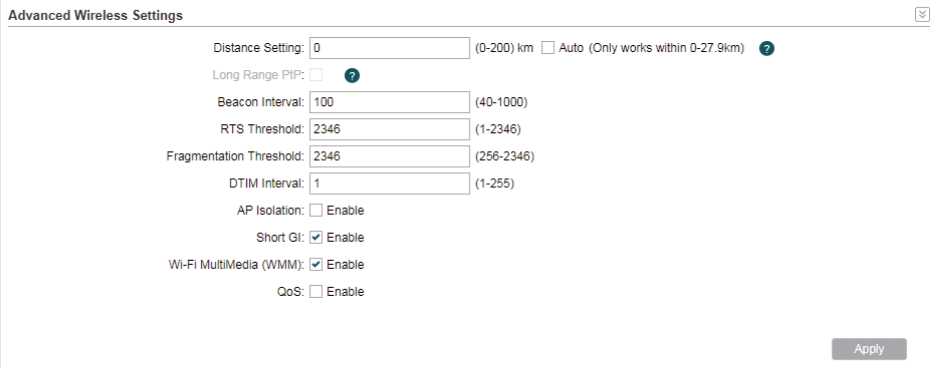
| Distance
Setting |
Specify the distance between AP and Station. If this device serves as a client, the value is the distance between this device and the root AP. If this device serves as an AP, the value is the distance between the farthest client and this AP.
You can manually enter the value or enable the Auto option. Manual: Enter the distance manually in the input box. The value is limited to 0-200km, and we recommend you set the value to 110% of the real distance. Auto (Only works within 0-xx km): Check the Auto option, then the system will dynamically detect the distance. This function is available only when the distance is less than xx kilometers. The value xx varies according to the channel width you set. CPE210 does not support this option. The distance value will be converted to a corresponding ACK timeout value, and the ACK timeout value will influence the throughput performance to a large extent. |
| Long Range PtP | Note:
Long Range PtP is only available on certain devices. To check whether your device supports this feature, refer to the actual web interface. Long Rage PtP is only available when MAXtream function is enabled. With this function enabled, it is allowed to specify a larger distance which can be helpful in the following situations:
The distance is used to calculate the Acknowledge timeout (ACK timeout). Long Range PtP allows the AP to get a larger ACK timeout and reduce unnecessary retransmission in the situations above. |
| Beacon Interval | Specify the beacon interval for the device. Beacons are transmitted periodically by the device to announce the presence of a wireless network for the clients. Beacon Interval value determines the time interval of the beacons sent by the device. Specify a value from 40 to 1,000. The default value is 100. |
| RTS Threshold | Specify the RTS threshold for the device.
RTS/CTS (Request to Send/Clear to Send) is used to improve the data transmission efficiency of the network with hidden nodes, especially when there are lots of large packets to be transmitted. When the size of a data packet is larger than the RTS Threshold, the RTS/ CTS mechanism will be activated. With this mechanism activated, before sending a data packet, the client will send an RTS packet to the device to request data transmitting. And then the device will send CTS packet to inform other clients to delay their data transmitting. In this way, packet collisions can be avoided. For a busy network with hidden nodes, a low threshold value will help reduce interference and packet collisions. But for a not-so-busy network, a too low threshold value will cause bandwidth wasting and reduce the data throughput. |
| Fragmentation
Threshold |
Specify the fragmentation threshold for packets.
The fragmentation function can limit the size of packets transmitted over the network. If the size of a packet exceeds the Fragmentation Threshold, the fragmentation function is activated and the packet will be fragmented into several packets. Fragmentation helps improve network performance if properly configured. However, a too low fragmentation threshold may result in poor wireless performance caused by the extra work of dividing up and reassembling of frames and increased message traffic. The recommended and default value is 2346 bytes. |
| DTIM Interval | Specify the DTIM (Delivery Traffic Indication Message) Interval for the device.
The DTIM is contained in some Beacon frames. It indicates whether the device has buffered data for client devices. The DTIM Period indicates how often the clients served by this device should check for buffered data still on the device awaiting pickup. Specify the value between 1-255 Beacon Intervals. The default value is 1, indicating that clients check for buffered data at every beacon. An excessive DTIM interval may reduce the performance of multicast applications, so we recommend you keep the default value. |
| AP Isolation | Enable or disable AP Isolation. With this feature enabled, the clients can not communicate with each other directly.
Note: AP Isolation is not available in Client Mode. |
| Short GI | Enable or disable Short GI.
Propagation delays often occurs in data transmission process and influence the capability of the wireless network. It can result from multiple factors, such as multipath effect. GI (Guard Interval) is intended to solve the problem based on delays, and Short GI is used to improve the throughput of the wireless network based on the GI in the environment with small delays. When the delays are small. When Short GI is enabled, the guard interval will be set as 400ns and this function will boost the performance about 11%. In the with serious multipath time delay. Short GI function will reduce the throughput instead of improving it. |
| Wi-Fi Multimedia (WMM) | Enable or disable WMM. With WMM enabled, the system will prioritize traffic according to the data type when forwarding data. Time-dependent traffic, such as video or audio packets, gets a higher priority than normal traffic.
We recommend you enable this function when you are running the video or audio application. |
| QoS | Enable or disable QoS. The QoS function improves the transmission performance of video or audio traffic by optimizing the scheduling policy between the AP and the clients. |
Manage the Device
The device provides powerful functions of management and maintenance. This chapter introduces how to manage the device, including:
- Configure RSSI LED Thresholds
- Manage System Logs
System logs record the events and activities while the device is running. If a failure happens on the device, System logs can help to diagnose the issue.
1. Go to the Management page. In the System Log section, perform the following operations.
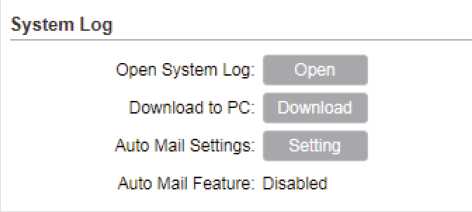
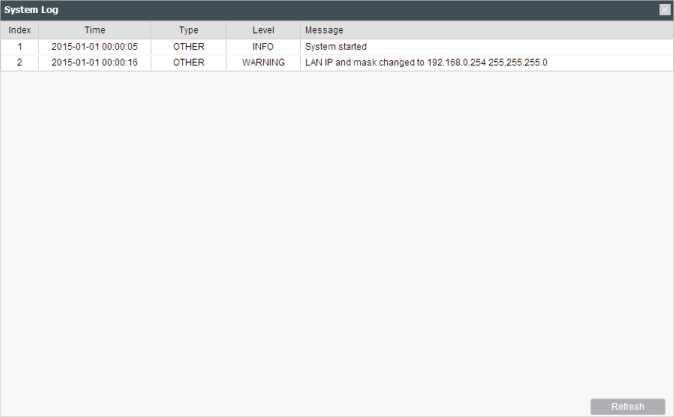
Open System Log
Click the Open button to view the system log.
This page displays detailed system logs that can be sorted on columns by ascending or descending order. Columns can be chosen from Time, Type, Level, and Message.
Download to PC Click the Download button to download the system logs to your PC.
2. Click the Setting button to specify the Auto Mail Settings.
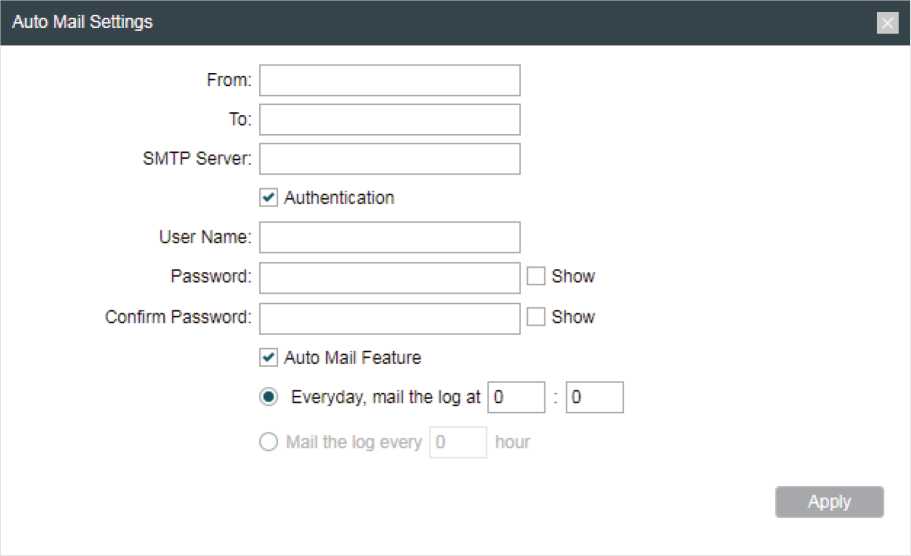
| From | Enter the sender’s E-mail address. |
| To | Enter the receiver’s E-mail address. |
| SMTP Server | Enter the IP address of the sender’s SMTP server. |
| Authentication | Enable or disable the authentication function. If the sender’s mailbox is configured, check the box to enable mail server authentication. Enter the sender’s username and password. |
| Auto Mail Feature | Enable or disable Auto Mail Feature. With this feature enabled, specify the way for the device to send the system log. |
This section is used to specify miscellaneous parameters.
- Go to the Management Page. In the Miscellaneous section, configure the following features and click Apply.
Miscellaneous
Discovery: 3 Enable 0
CDP: 13 Enable Q
Apply
| Discovery | Enable or disable Discovery. With this feature enabled, TP-Link Pharos Control software can discover the device. Pharos Control is a network management software developed independently by TP-Link and it currently supports Pharos series products. It can centralize monitoring and managing network devices in the network platform |
| CDP | Enable or disable CDP. With this function enabled, this device can share its information with the neighboring devices that support CDP (Cisco Discovery Protocol, a device discovery protocol developed by Cisco). |
2. Click Save.
Ping Watch Dog sets the device to continuously ping a user-defined IP address (it can be the internet gateway, for example) to check the network connectivity. If there is a connection failure then the device will automatically reboot.
Ping Watch Dog is dedicated to continuously monitoring the connectivity to a specific host using the Ping tool. The Ping tool sends ICMP echo request packets to the target host and listens for ICMP echo response. If the defined number of replies is not received, the tool reboots the device.
1. Go to the Management Page. In the Ping Watch Dog section, Enable this feature and configure the following features. Click Apply.
Ping Watch Dog
| Ping Watch Dog: >] Enable | ||
| IP Address To Ping: | 0 00 0 | |
| Fing Interval: | 300 | (10-300) seconds |
| Startup Delay: | 300 | (60-300) seconds |
| Fall Count To Reboot: | 3 | (1-65535) |
| Ping Watch Dog | Enable or disable Ping Watch Dog. |
| IP Address To Ping | Specify the IP address of the target host to which the device will send ping packets. |
| Ping Interval | Enter the time interval between two ping packets. The default value is 300 seconds. |
| Startup Delay | Enter the initial time delay from device startup to the first ICMP echo requests sent by Ping Watch Dog. The default value is 300 seconds.
The Startup Delay value should be at least 60 seconds taking the device‘s initialization time in account. |
| Fail Count To Reboot | Enter the fail count of ICMP echo request. If the device sends the specified count of ICMP echo requests to the host and none of the corresponding ICMP echo response packets is received, Ping Watch Dog will reboot the device. The default value is 3. |
2. Click Save.
Note:
The Dynamic DNS function is only available in AP Router and AP Client Router (WISP Client) Mode.
The main function of Dynamic DNS (DDNS) is mapping the fixed domain name to dynamic IP address.
When a device connects to the internet through PPPoE or Dynamic IP, the WAN IP address it gets is not fixed, which is inconvenient for the internet users to access the servers in the local area network through IP address. With Dynamic DNS function enabled, users can access servers using a fixed domain name.
The DDNS server will establish a mapping table about the dynamic IP address and the fixed domain name. When the WAN IP address of the device changes, it will make an update request to the specified DDNS server, and then the DDNS server will update the mapping relation between the IP address and the domain name. Therefore, whenever the WAN IP address changes, users on the internet can still access the servers in the local area network using a fixed, easy-to-remember domain name.
The DDNS function that serves as the client of DDNS service must work with DDNS server. Register an account to DDNS service provider (NO-IP, Dyndns or Comexe) first.
1. Go to the Management page. In the Dynamic DNS section, configure the following parameters and click Login.
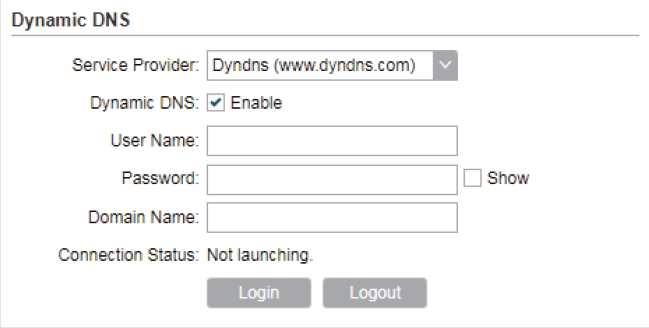
| Service
Provider |
Select the service provider. |
| Dynamic DNS | Enable or disable the Dynamic DNS feature. |
| User Name | Enter the user name of your DDNS account. |
| Password | Enter the password of your DDNS account. |
| Domain Name | Specify the domain name that you registered with your DDNS service provider. |
| Connection
Status |
Displays the connection status of the DDNS service. |
2. Click Apply, then click Save.
This function is used to configure the related parameters of Web server. Users can log in to the web management page to manage this device remotely over the internet through Web Server.
1. Go to the Management page. In the Web Server section, configure the following parameters and click Apply.
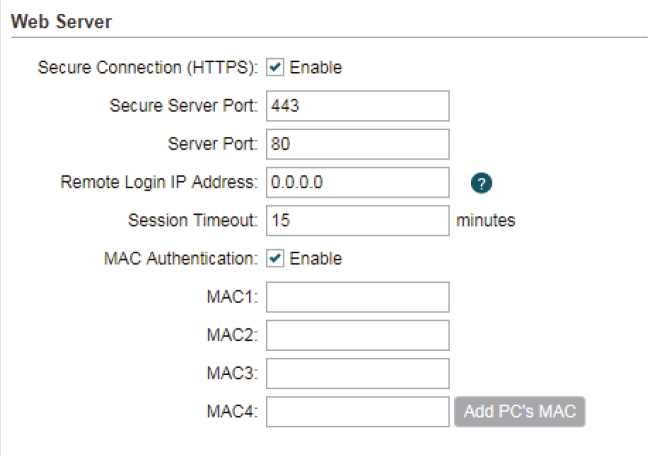
| Secure
Connection (HTTPS) |
Enable or disable the HTTPS feature. HTTPS function is based on the SSL or TLS protocol working in transport layer. It supports a security access via a web browser. |
| Secure Server
Port |
Specify the server port number used in HTTPS. The default value is 443. |
| Server Port | Specify the server port number used in HTTP. The default value is 80. |
| Remote Login IP Address | Specify the IP address of the remote host. With this configured, the remote host can access the management interface remotely using the WAN IP of this device. |
| Session
Timeout |
Specify the session timeout time. The system will automatically release the connection when the time is up. |
| MAC
Authentication |
Enable or disable MAC Authentication. When it is enabled, you can specify up to four MAC address for authentication.
With this function enabled, only the device whose MAC address is in the MAC list can access the management interface to configure the device. Click Add PC’s MAC to quickly add your PC’s MAC address to the MAC list. |
2. Click Apply, then click Save.
Get the traffic information and transmit condition by using the SNMP Agent function. Simple Network Management Protocol (SNMP) is an application layer protocol that facilitates the exchange of management information between network devices. Main functions of SNMP include monitoring network performance, detecting and analyzing network error, configuring network devices, and so on.
Configure the device as SNMP Agent, and it can receive and process the management message from the NMS (Network Management System).
1. Go to the Management page. In the SNMP Agent section, configure the following parameters and click Apply.
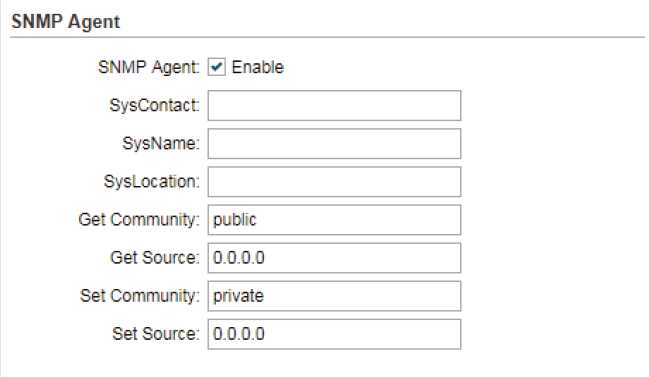
| SNMP Agent | Enable or disable the SNMP Agent function. |
| SysContact | Enter the textual identification of the contact person for this device, for example, contact number or e-mail address. |
| SysName | Enter a name for the device. |
| Syslocation | Enter the location of the device. For example, the name can be composed of the building, floor number, and room location. |
| Get Community | Specify the community that has read-only access to the device’s SNMP information. |
| Get Source | Enter the IP address of the NMS that can serve as Get Community to read the SNMP information of this device. By default, it is 0.0.0.0, which means an NMS of any IP address is available. |
| Set Community | Specify the community who has the read-and-write right of the device’s SNMP information. |
| Set Source | Enter the IP address of the NMS that can serve as Set Community to read and write the SNMP information of this device. By default, it is 0.0.0.0, which means an NMS of any IP address is available. |
2. Click Apply, then click Save.
Note:
Defining community can allow management systems in the same community to communicate with the SNMP Agent. The community name can be seen as the shared password of the network hosts group. Thus, for the safety, we suggest modifying the default community name before enabling the SNMP Agent service. If the field of community is blank, the SNMP Agent will not respond to any community name.
The SSH Server function is used for the users to log in and manage the device through SSH connection on the SSH client software.
SSH (Secure Shell) is a security protocol established on application and transport layers. SSH- encrypted-connection is similar to a telnet connection, but essentially the old telnet remote management method is not safe, because the password and data transmitted with plain-text can be easily intercepted. SSH can provide information security and powerful authentication when you log in this device remotely through an insecure network environment. It can encrypt all the transmission data and prevent the information in remote management from being leaked.
1. Go to the Management page. In the SSH Server section, configure the following parameters and click Apply.

| Server Port | Enter the TCP/IP port of the SSH Server. The default port is 22. |
| SSH Login | Enable or disable SSH function. |
| Remote
Management |
Enable or disable Remote Management. With this function enabled, TP- Link Pharos Control software can manage the device remotely. |
2. Click Save.
Note:
RSSI LED Thresholds is only available on certain devices. To check whether your device supports this feature, refer to the actual web interface.
Configure the LEDs on the device to light up when received signal levels reach the values defined in the following fields. This function can help a technician to easily deploy a Pharos series product without logging into the device (for example, for antenna alignment operation).
1. Go to the Management page. In the RSSI LED Thresholds section, configure the following parameters and click Apply.
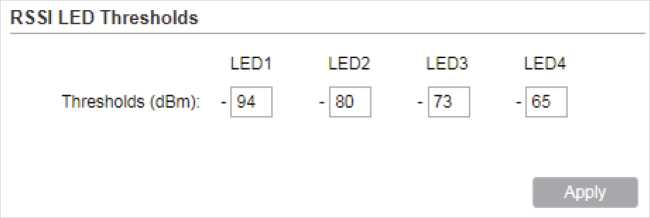
| LED1/LED2/
LED3/LED4 |
Displays the LED number. |
| Thresholds | Specify the threshold for the desired LED. The specified LED will light up if the signal strength reaches the values in the field. The default values are set according to the verified optimum values. We recommend you keep it by default.
The default LED threshold values may vary among different product models in terms of radio features. |
2. Click Apply, then click Save.
This chapter introduces how to configure the system of the device, including:
- Configure Device Information
- Configure Location Information
- Configure User Account
- Configure Time Settings
- Update Firmware
- Configure Other Settings
- Configure Device Information
In this section, configure the device name and the system language.
Device
Device Name: CPE21C
Language: English
Device Name Specify the device name.
Language Specify the system language used in the management interface.
In this section, configure the location for the device.
1. Go to the System page. In the Location section, configure the following parameters and click Apply.

| Longitude | Enter the longitude of the device’s location in decimal degree. The positive number indicates the east longitude while the negative number indicates the west longitude. |
| Latitude | Enter the latitude of the device’s location in decimal degree. The positive number indicates the north latitude while the negative number indicates the south latitude. |
2. Click Save.
This section is used to configure user account.
1. Go to the System page. In the User Account section, configure the following
parameters and click Apply.
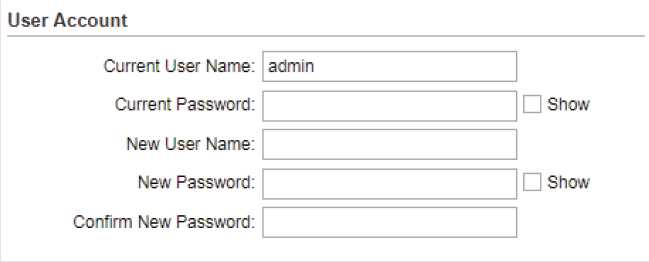
| Current User
Name |
Displays the current user name. |
| Current
Password |
Enter the current password for the user account. Check the Show box to display what you’ve entered. |
| New User Name | Enter a new user name for the user account. |
| New Password | Enter a new password for the user account. Check the Show box to display what you’ve entered. |
| Confirm New Password | Confirm the new password. |
2. Click Save.
In this section, configure the system time and the daylight saving time.
1. Go to the System page. In the Time Settings section, configure the system time.
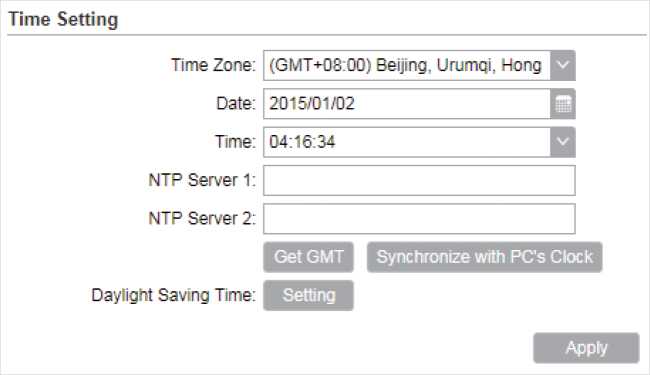
■ Manually
Configure the System time manually.
| Time Zone | Select your local time zone. |
| Date | Click the calendar button to choose the date or enter the date in the format: YYYY/MM/DD. |
| Time | Select the time from the drop-down list or enter the time in the format HH:MM:SS. |
■ Automatically
• Specify the NTP Server, then click the Get GMT button to get the system time from the NTP server
NTP Server 1 Specify the primary NTP server used to get time automatically.
NTP Server 2 Specify the alternate NTP server used to get time automatically.
• Click Synchronize with PC’s Clock to synchronize the system time with the PC’s time.
2. Click the Setting button to specify the daylight saving time.
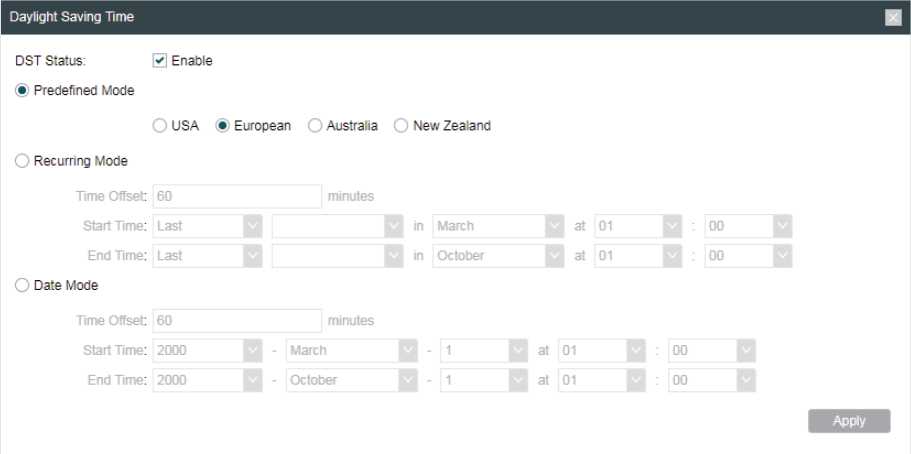
■ Predefined Mode
Select Predefined Mode and select the predefined daylight saving time schedule for the device.
| USA | The daylight saving time of USA is from Second Sunday in March, 02:00 to First Sunday in November, 02:00. |
| European | The daylight saving time of European is from Last Sunday in March, 01:00 to Last Sunday in October, 01:00. |
| Australia | The daylight saving time of Australia is from First Sunday in October, 02:00 to First Sunday in April, 03:00. |
| New Zealand | The daylight saving time of New Zealand is from Last Sunday in September, 02:00 to First Sunday in April, 03:00. |
■ Recurring Mode
Select Recurring Mode and configure the related parameters for the device. This configuration will be used every year.
| Offset | Specify the time to set the clock forward by. |
| Start Time | Specify the start time of Daylight Saving Time. |
| End Time | Specify the end time of Daylight Saving Time. |
■ Date Mode
Note:
Date Mode is only available on certain devices. To check whether your device supports this feature, refer to the actual web interface.
Select Date Mode and configure the related parameters for the device. This configuration will be used only one time.
| Offset | Specify the time to set the clock forward by. |
| Start Time | Specify the start time of Daylight Saving Time. |
| End Time | Specify the end time of Daylight Saving Time. |
This section is used to view the current firmware and update the firmware of the device.
Go to the System page. In the Firmware Update section, click Browser to select a firmware file then click Upload.
Firmware Update
Firmware Version: 2.1.6 Build 20170908 Rel. 45233 (0000)
Upload Firmware:
Displays the current firmware version of the device.
Firmware
Version
Note:
- We recommend that you back up current system configuration before updating the firmware.
- Select the proper software version that matches your hardware to upgrade. Visit TP- Link website to download the latest firmware.
- To avoid damage, do not power off the device while upgrading.
- After upgrading, the device will reboot automatically.
 This section is used to back up or upload the configuration file, reset the device and reboot the device.
This section is used to back up or upload the configuration file, reset the device and reboot the device.
Go to the System Page. In the Configuration section, perform the following operations.
| Backup Configuration | Click Backup to back up the current configuration to your PC. |
| Upload Configuration | Click Browser to select the desired configuration file in your PC. Then click Upload to upload the configuration file to your device. We recommend that you back up your current system configuration before uploading the new configuration. |
| Reset to
Factory Defaults |
Click Reset to restore the device to its factory defaults. It’s recommended to back up your current system configuration before restoring the device to its defaults. |
| Reboot Device | Click Reboot to reboot the device. Note that any changes that have not been saved will be lost. |
Note:
- After backup, the device will reboot automatically.
- To avoid damage, DO NOT turn off the device while uploading.
Use the System Tools
This chapter introduces how to configure the system tools:
Ping test function is used to test the connectivity and reachability between the device and the target host so as to locate the network malfunctions.
1. Click Ping from the drop-down list on the upper-right corner and specify the following parameters.
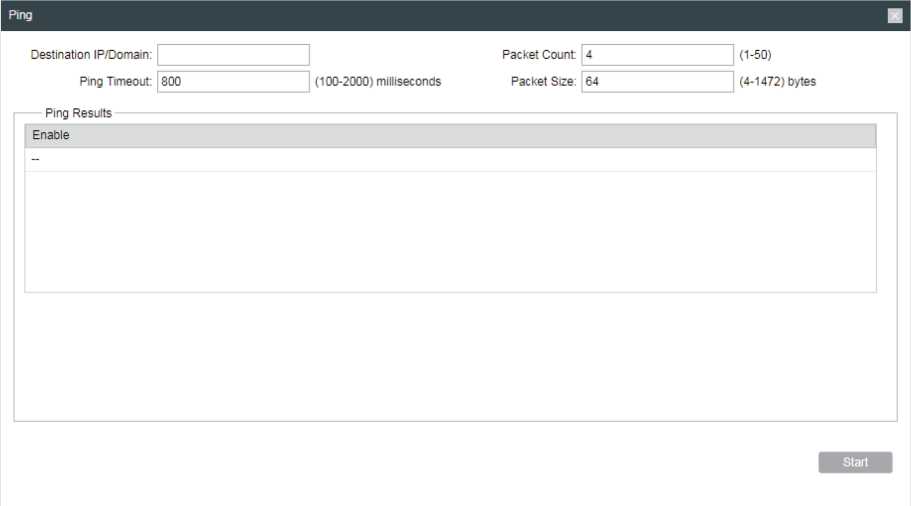
| Destination IP/
Domain |
Enter the IP address of the destination node for Ping test. The device will send Ping packets to test the network connectivity and reachability of the host and the results will be displayed in the Ping Result. |
| Packet Count | Enter the number of packets to be sent during the testing. It can be 1 to 50 and the default is 4. |
| Ping Timeout | Enter a time value to wait for a response. If the device doesn’t receive ant response during the timeout time, the connection will be considered to be failed. It can be 100-2000 milliseconds. The default value is 800 milliseconds. |
| Packet Size | Enter the number of data bytes to be sent. It can be 4-1472 bytes and the default is 64. |
2. Click Start.
Tracertroute function is used to tracks the route packets taken from source on their way to a given target host. When malfunctions occur in the network, troubleshoot with traceroute utility.
1. Click Traceroute from the drop-down list on the upper-right corner and specify the following parameters.
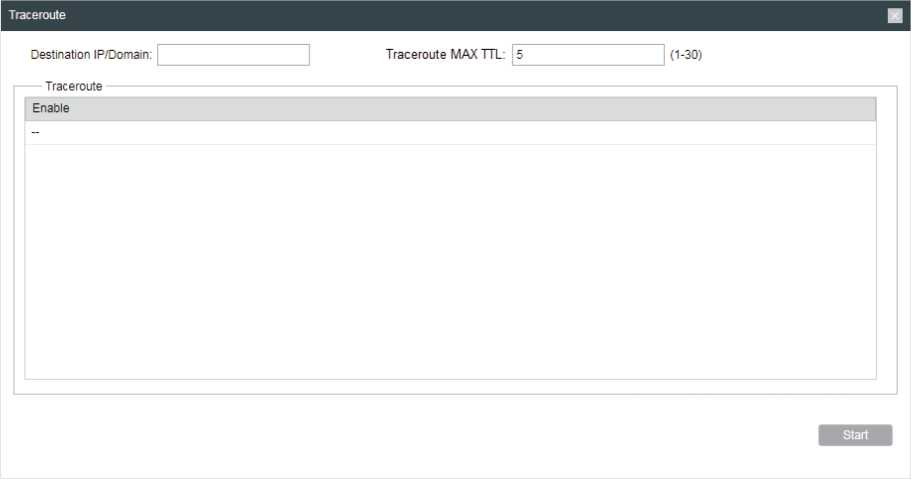
| Destination IP/
Domain |
Enter the IP address of the destination node for Traceroute test. The device will send Traceroute packets to test the network connectivity and reachability of the host and the results will be displayed in the Traceroute. |
| Traceroute Max TTL | Specify the traceroute max TTL (Time To Live) during the traceroute process. It is the maximum number of the route hops the test packets can pass through. |
2. Click Start.
Speed Test tool is used for testing the throughput between two Pharos products in the same network. The test requires one of the two devices to be set as a server and the other as a client. The client launches the test request to the server and the server respond to it. The test result will display on the page of the client.
1. Click Speed Test from the drop-down list on the upper-right corner and specify the following parameters.
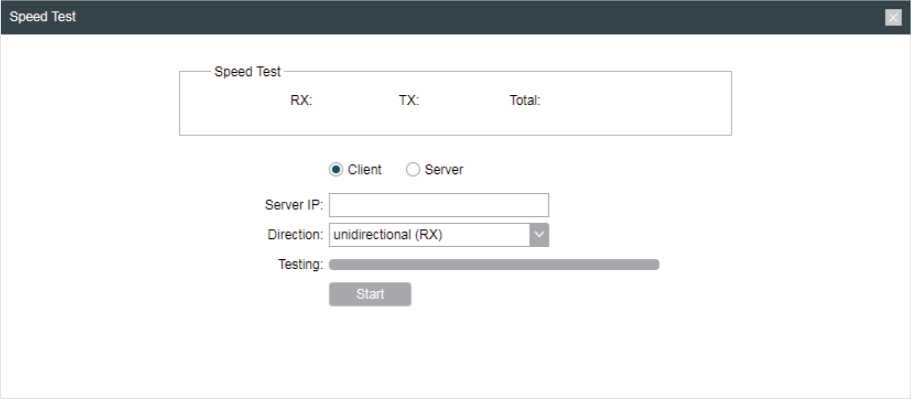
| Speed Test | Displays the data streams that the device is transmitting (TX), receiving (RX) and both of them (Total). |
| Server | Select Server and the device will passively accept the test request from the clients in the speed test process. |
| Client | Select Client and the device will launch the test request to the server in speed test process. |
| Server IP | Specify the server IP for speed test. |
| Direction | Select the direction of the speed test including unidirectional (RX), unidirectional (TX) and bidirectional. |
| Testing | Displays the process of the test. |
2. Click Start.
The survey tool is used to survey the wireless network around the device.
Click Survey from the drop-down list on the upper-right corner and the following page will
appear.
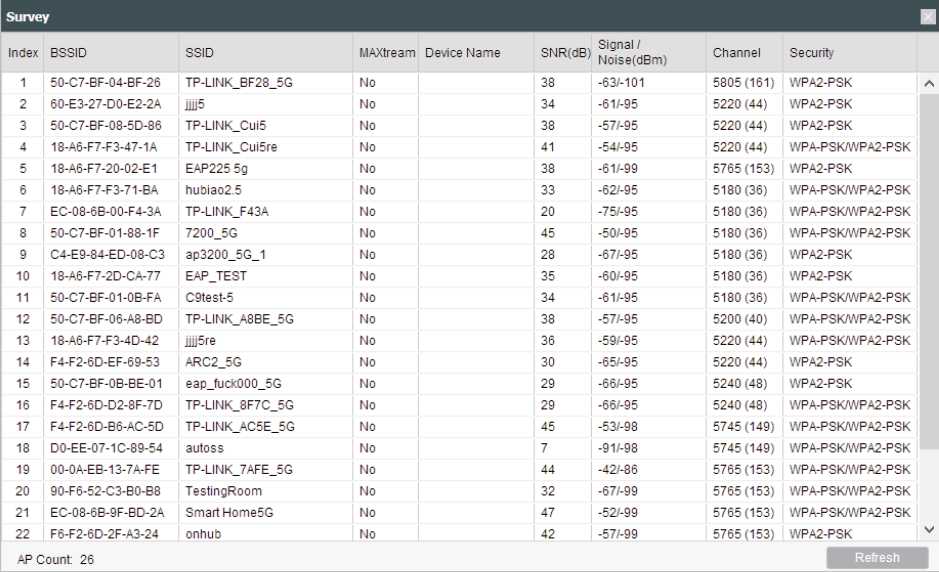
| BSSID | Displays the BSSID of other APs surveyed by this device. |
| SSID | Displays the SSID of other APs surveyed by this device. |
| MAXtream | Displays the MAXtream capability of other APs surveyed by this device. |
| Device Name | Displays the names of other APs surveyed by this device. |
| SNR(dB) | Displays the Signal Noise Ratio (Unit: dB) of other APs surveyed by this device. |
| Signal/Noise (dBm) | Displays the signal and noise value (Unit: dBm) of other APs surveyed by this device. |
| Channel | Displays the channels of other APs surveyed by this device. |
| Security | Displays the security mode of APs surveyed by this device. |
| AP Count | Displays the number of other APs surveyed by this device. |
| Refresh | Click Refresh to refresh this page. |
Spectrum Analysis can help you choose the proper channel/frequency. Through the spectrum analysis, learn the distribution of the radio noise and intelligently select the channel/frequency in low noise.
1. Click Spectrum Analysis from the drop-down list on the upper-right corner and click
Yes on the pop-up window.

2. Click Start. Observe the curves for a period of time, and then click Stop. The relatively low and continuous part of the average curve indicates less radio noise. Here we take the figure below as an example.
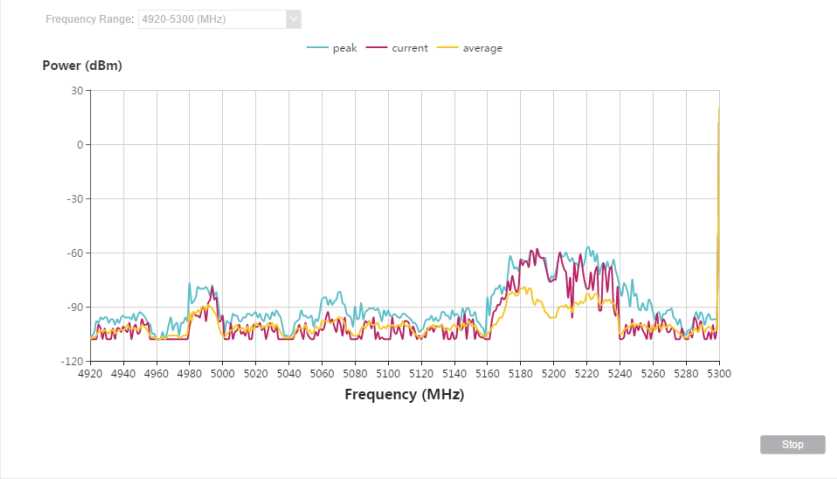
![]()
Spectrum Analysis
Note:
The select box of Frequency Range is only available on certain devices. To check whether your device supports this feature, refer to the actual web interface. Select the required range and then click Start.
- When choosing Channel/Frequency, try to avoid the spectrum with large radio noise.
- Antenna Alignment
Antenna alignment can help you to optimize the antenna. Click Antenna Alignment from the drop-down list on the upper-right corner. Adjust your antenna according to the following parameters. Point the antenna in the direction of maximum signal and minimum noise.
Antenna Alignment
| Signal Level: ■■■■■ ■■■■■■■■— -27 dBm
Horizontal/Vertical: -34/-30 dBm Noise Floor: -90 dBm Max Signal: * B 1 [-65 dBm Alignment Beep: □ Q |
|
| Signal Level | Displays the signal strength of the last received packet. The signal strength is the combined value of the two chains. |
Horizontal/Vertical Displays the signal strength of the last received packet. The signal
| strength of the two chains is displayed separately. | |
| Noise Floor | Displays the noise strength of the wireless network. |
| Max Signal | Specify the maximum value of the Signal Level indicator. Adjust the sensitivity of the Signal Level indicator by changing this value. |
| Alignment Beep | Enable the beep sound during the device antenna alignment. This function can help users to align the antenna easily without looking at the management interface. When received signal levels reach the defined levels, the different beep sound will be played. The lower the sound frequency, the stronger the signal strength. |
